Tim Notier's Blog, page 8
August 12, 2020
Chapter 9 - Turnarounds
By Tim Notier Sometimes life can seem difficult, unfair, with uncomfortable situations that seem to have no end in sight. But hopefully some of our own experiences can help shed some light on positive outcomes. That silver lining may seem thin at times, but if you just keep pushing forward, things will turnaround for the better.
The following is an excerpt from the book 2Up and Overloaded.
Chapter 9 - Turnarounds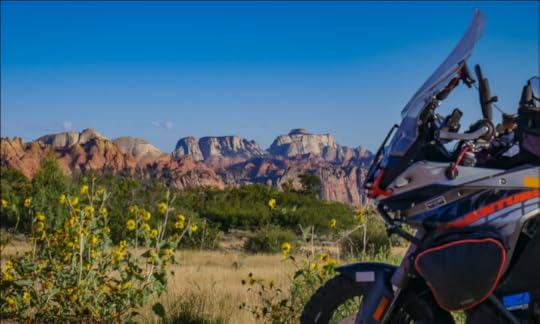 After spending two nights just outside of the Grand Canyon, we turned around and headed back into Utah. Out of Utah’s ‘Mighty Five’ national parks—Zion, Bryce Canyon, Capitol Reef, Arches, and Canyonlands, we had only one national park left to check off our list from our previous visit: Zion.
After spending two nights just outside of the Grand Canyon, we turned around and headed back into Utah. Out of Utah’s ‘Mighty Five’ national parks—Zion, Bryce Canyon, Capitol Reef, Arches, and Canyonlands, we had only one national park left to check off our list from our previous visit: Zion.
We rode into Zion as far as we were allowed by motorcycle. The public road ends at a main hub with large hotels and restaurants. From there, you have to take a network of buses that shuttle you further into the park. The buses fill up and let people off at specific waypoints. Trails with names like Court of the Patriarchs, Emerald Pools, and Temple of Sinawava all sounded like the titles of fantasy books I used to read as a kid, and they all led to the Narrows, the end of the line of the park.
The Narrows Trail doesn’t actually end, but it turns into the Virgin River that spreads from canyon wall to canyon wall. The river gets progressively deeper as you twist along the bends of the canyon. Sometimes we were waist deep as we navigated further along.
“How far do you want to go?” Marisa asked.
“Let’s get to the point where it weeds out most of the hikers,” I replied. “I would like to get some pictures that don’t have a hundred people in them.”
We lurched forward, expecting the crowds to thin around every corner, but there were always more people, just as stubborn as me to find a secluded section of this wonder.
After a couple of miles, we sat down to have a lunch break on a small section of land that wasn’t submerged. As we ate our sandwiches, a couple were having a photoshoot not too far in front of us. The woman was strutting her best poses, taking off her shirt slowly to reveal the bikini underneath and raising her arms in angelic positions for her beauty shots.
Her boyfriend was nailing each shot as she worked the hell out of that camera.
“Why don’t you take a picture, Tim?” Marisa asked as I stared, refusing to blink.
“Sometimes I just want to live in the moment,” I replied. “Do you see all of the glimmering stars and rays of light surrounding her in an aura of perfection?”
Then it was the Khal Drogo’s turn to striptease the camera. The woman took the camera and aimed it at his marble-like stature. Same poses, but with a masculine tone. With his shirt off, he bent and flexed for what I can only assume to be the cover shot of ‘Men’s Health’.
“Do you see the glimmering, Tim?” Marisa shot back. “The shadows in the tone of his muscles?”
“All right, all right. These two are clearly the descendants of Nordic Gods,” I said. “Did you ever see any of those movies where they piss in the same fountain when lightning strikes and they trade bodies, or a Chinese fortune cookie swaps the souls of two people?” I asked.
“Are you really going where I think you are going with this?” she replied.
“If you’re thinking I want to attempt to exchange bodies with those two beautiful creatures, then yes,” I said.
“How are you going to get him to pee in the river with you?” she asked.
“We have to at least try and do something,” I said. “Just concentrate really hard and do your best ‘I Dream of Jeannie’ impersonation.”
We both sat there in a meditative posture, with our hands locked on our elbows, our faces scrunched and wrinkled in full-on wish mode, all while nodding our heads and winking every once and a while.
“I don’t think it’s working,” I said after a while.
“I think it did,” Marisa said. “You’re the most gorgeous man I have ever seen.”
Both accepting our fate as who we were, and who we chose to be with, we continued down the river until finally feeling like we had seen enough and headed back. The Narrow’s constant flow of water was matched by the flood of people wading through its water.
The one thing that stood out to us about Zion was the accessibility of the majority of the sights. With the exception of The Narrows, most destinations were a short hike from one of the many shuttle stops. Large groups of people gathered together at the main attractions. We had felt a little more secluded at Bryce Canyon and Arches. Marisa and I were able to roam down different channels and avoid large clusters of other tourists while hiking through the other parks throughout Utah.
Zion seemed to be a stream-lined, cattle-herding, all-business model of a National Park. The park was beautiful, don’t get me wrong, but it just felt like we had bought admission tickets to an amusement park and had to wait in long lines to get to the most popular rides.
After a couple more walks to different sections of the park, we got back on a bus that would return us to our bike. It had been another amazing day filled with surreal sights. We searched for campgrounds on our phones and picked one on the banks of the Kolob Reservoir, just north of Zion. On the way, we stopped in a small town for lunch.
While in the parking lot of a Walmart, a woman walked up to us and introduced herself as Dana. She was so thrilled we were traveling via motorcycle and said we were more than welcome to stay with her. She said that her husband rides a motorcycle and would love to meet us.
We kindly took her number, but we had been self-sufficient up to that point and we were very much looking forward to some more camping. Besides, I felt awkward accepting someone’s invitation. I didn’t want to impose on anyone, nor did I think we had really done anything all that unique to be rewarded with special attention. But we thanked her for her offer and headed off to the campsite.
Once out of town, fields of Black-Eyed Susans lined the road on either side. The sky was a baby blue backdrop with clouds meandering around in no particular direction. The flat land yielded prairie-like grasses, shrubbery, and pine trees, then gave way to the jagged sections of rock that was Zion in the background. When we arrived at the reservoir, we knew we had found yet another slice of heaven.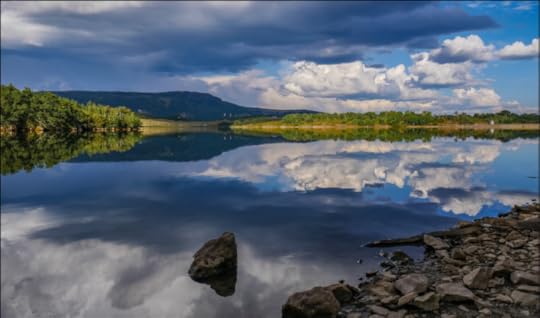 With plenty of spots to choose from and no other campers, we picked a site with an open view to the lake that perfectly mirrored the sky, the clouds above, the shoreline, and all the trees lining the edge. Ducks quacked as they swam around in circles, bobbing their heads underwater to nibble on the grass and weeds that grew beneath, and every once in a while, coming up with a small fish.
With plenty of spots to choose from and no other campers, we picked a site with an open view to the lake that perfectly mirrored the sky, the clouds above, the shoreline, and all the trees lining the edge. Ducks quacked as they swam around in circles, bobbing their heads underwater to nibble on the grass and weeds that grew beneath, and every once in a while, coming up with a small fish.
We set up our tent and then brought our chairs to the lake’s edge as we just breathed in the day.
“Do you think this is another two or three-day spot?” I asked.
“I sure do. This reminds me of camping on the Rio Grande. It’s just so peaceful,” she replied.
There was a little store a couple of miles away that we could get vegetables and pasta from, and there was plenty of fresh water to filter, so we figured we had everything we needed.
When we woke up the next morning it was raining, then it started to hail. As we huddled in the tent, hail hammered the ground around us, causing splashes of water and mud to ricochet onto us from every direction. It was even getting at us from under the tent’s rainfly. We were stuck, and filthy, but there was no way I was going to pack up the tent while God’s wrath came down on us.
“We need food, love,” Marisa stated, after six hours of non-stop rain.
“We’ve eaten all of our peanuts and granola bars, and there’s nothing left.”
“All right. I’ll go to that little store and get some food,” I said.
“Good luck,” Marisa said as I got on my raingear and headed out of the tent.
I jumped on the bike and made my way to through some muddy sludge before turning right onto the gravel road. As soon as I turned right, my rear tire lost traction in the mud and kicked out to the left. It happened too quickly for me to counterbalance, and I dropped the bike not ten feet from where I had started.
“This is going to be awesome,” I said.
“Are you okay?” Marisa asked from the tent.
“I’ll be fine. The bike is unloaded, so there’s no reason for us both to get wet and muddy,” I grunted as I lifted the bike back upright.
I carefully continued on to the store. Most of the track was made up of water-filled trenches of mud and gook that I tried desperately not to fall into. The hail was coming down hard, clinking against my helmet, and each piece of frozen water that hit me felt like I was getting shot at with a paintball gun. I made it to the ‘Little House on the Prairie’ store that stood alone against the backdrop of absolutely nothing, and although I could not fathom who its clients were, I was thankful for its presence.
The sign on the front door displayed ‘Closed’. The little clock with red movable hands said that they would return at three. It was two. With nothing better to do, I sat underneath the awning of the store and chain-smoked as I watched the thick black clouds that blocked the sun deposit tons of hail on the earth below. Marisa was out there probably wondering if I was okay, especially after my not-so-graceful exit. I liked it when Marisa worried about me. It’s a guilty pleasure, but I liked knowing someone was thinking about my welfare and might even miss me if I were to perish. Even if only because her survival was directly tied into my own; but still, she cared.
Forty-five minutes and six cigarettes later, the owner came back and opened the door. It wasn’t even locked; he just opened the door and flipped the ‘closed’ sign around to ‘open’.
“If anyone were to come in while I wasn’t here, it’d usually just be Tommy, Frank, or Bill getting a pack of smokes or some bait, and most of the time they leave a note with some cash,” he said. “Not a lot of traffic around here, especially on days like today.”
“I just need some pasta, crackers, and some canned veggies to wait out the storm down by the reservoir,” I said.
“You may be there a while. The radar doesn’t show this letting up for a couple days,” he replied.
“Awesome.” I said as I grabbed a second can of beans, corn, and another bag of pasta.
I rode back in what seemed to be worse weather than I had ridden out in. It was one-hundred percent miserable, with a chance of awful. When I got back to the entrance of the reservoir, I saw a husband and wife duo that were two-up on an Africa Twin. One was covered in mud from helmet to boots, and they were putting the final pieces of luggage back on the bike.
“Where did you two come from?” I asked as I introduced myself.
“We camped here last night, and it has just been torrential rain since four o’clock this morning,” he replied. “I’m James, and this is my wife, Imogen.”
“Really? We camped here last night too. I just went out to get some food for my wife. Where did you guys camp? We’re just over there,” I said, as I pointed to the west side of the lake.
“We thought we saw lights across the lake last night,” James said. “We were on the opposite side, down that dirt hill that has now turned into a mudslide.”
“I had to push him up the bloody hill as he slipped around spraying mud all over me,” Imogen stated, pointing to the filth that covered her as she curtsied like a pageant queen.
“We’ve totally been there!” I laughed as I thought of Marisa doing the exact same thing.
They were from London and were the first world travelers I had met while on our own circumnavigation of the globe.
We stood there and chatted about their travels as well as our own short stint across the States as the weather beat down on us. We exchanged information and sadly had to part ways more quickly than I would have liked to. It had already been more than an hour, and I was sure Marisa was well past the worried point and probably completely freaking out. I got back on the bike and rode to camp.
“Oh, thank God you’re back,” she said as I crawled into the tent.
I showed her our survival kit of canned goods and pasta, and she immediately wished she had made the journey with me to purchase more nutritious food.
“We will survive, but we will not flourish,” I stated. “The guy at the store said it will be like this for a couple more days.”
“We should move on tomorrow, regardless of the weather then,” Marisa said.
“Agreed. I just met two other travelers who’ve packed up and headed off in this madness,” I told her.
It rained for the next fifteen hours straight. We went to sleep with nothing better to do except wait it out.
The next morning, the sky retreated from its hostile onslaught momentarily, and we seized the opportunity to get the hell out of there. As we packed up our gear, everything was coated in a muddy stew that added an additional ten pounds to the bike’s collective weight.
“This sucks,” I said in a cranky mood. “Not a single part of me is dry.”
“Let’s just make it to the next town. Everything we own needs to be washed, twice,” Marisa stated.
Hurricane was the closest town, and we pulled into the first hotel available. Marisa hopped off the bike to see how much the cheapest room was.
“A hundred-and-twenty bucks,” she said with a frown, as she came out the door.
We rode to another hotel. It was eighty dollars a night.
“We just can’t afford that,” I said.
I knew that all Marisa wanted in life was a warm shower and a bed, but those numbers were twice our daily budget.
“Call that Dana woman,” Marisa said.
“Really?” I asked.
“Why not?” she said. “We don’t have a lot of options here.”
“I feel uncomfortable asking for help from people I don’t know. And, we are not technically stranded, we’re just cheap,” I said.
“Then let’s get an eighty-dollar hotel room,” she replied.
“Okay, I’ll call her,” I said as I dug through my wallet looking for the piece of paper with her number on it.
“Hi, is this Dana?” I asked over the phone. “You met my wife and me a couple of days ago, and... said we might be able to stay with you if needed.”
“Of course!” She said over the phone. “We would be more than happy to have you stay with us!”
“Thank you so much. The rain just won’t stop, and we really don’t want to pay an arm and a leg for a basic room. But we don’t want to impose at all and...”
“Oh, stop ramblin’ on about being a burden and get yourself over here. I’ll fatten you up with some hot food and some whiskey,” she said, interrupting my prepared pity speech.
She gave us her address, and I thanked her again before hanging up.
“I think that woman is my Fairy Godmother,” I told Marisa.
We plugged her address into our Garmin and rode through the rain with the hopes of a hot meal, shower, and whiskey in the very near future. What she provided us was everything she promised and more.
We spent the next four days with two of the most amazing people we had ever met. Dana and her husband Bill were like an aunt and uncle that we had not seen for years. During the days we talked about her past life in the Mormon church, a life she has now retreated from ‘gracefully’. It was interesting as an outsider, talking to someone who was willing to discuss all of the dirty little secrets.
At night, we slept in her ‘Glamper’, an old RV that had stopped being completely functional long ago, but was now an external extension to her house. There was a comfortable bed, window shades, and an extension cord running through the top of the door that provided electricity to a small lamp and whatever gadgets we wanted to plug in.
Her property was dubbed Red Hen Gardens, and for good reason. There was a huge garden complete with every type of bean, corn, potato, and all the herbs that I could imagine. There were, of course, chickens, as well as a friendly dog that kept a watchful eye on us as we made ourselves at home.
There was a trampoline in a corner of the yard by some lawn chairs and a fire pit. The entire property was amazing to walk around and see all of the care and special touches she had put in place. One of the trees had the face of a woman carved into it. It was so realistic that I didn’t doubt the possibility that she might open her eyes and speak to me in some elvish tongue.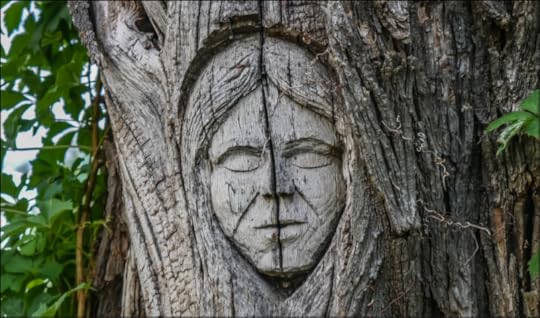 Dana was a character that could be the star of a TV sitcom. A wonderfully positive woman who has been through hell on a road that was disguised as a pathway to heaven, but she had come out the other side still cheerful, compassionate, wise, and hysterically funny. I was completely fascinated and horrified by some of the stories Dana shared. I am not a religious man, and Dana had converted to atheism since leaving the Mormon church, so we had a good time poking fun at some of the obscure sections of religion. Marisa, on the other hand, is religious, so we were careful to not dig the knife in too hard, at least when she was present.
Dana was a character that could be the star of a TV sitcom. A wonderfully positive woman who has been through hell on a road that was disguised as a pathway to heaven, but she had come out the other side still cheerful, compassionate, wise, and hysterically funny. I was completely fascinated and horrified by some of the stories Dana shared. I am not a religious man, and Dana had converted to atheism since leaving the Mormon church, so we had a good time poking fun at some of the obscure sections of religion. Marisa, on the other hand, is religious, so we were careful to not dig the knife in too hard, at least when she was present.
On the last night, while drinking more whiskey than I probably should have, we sat in Dana’s living room listening to Stevie Ray Vaughn make his guitar weep with the blues. I started to think about our trip so far from an outside perspective. Not every day had been filled with pure excitement. In fact, there had been moments of complete frustration, either with the weather, the KTM dealership, or disagreements between Marisa and me about where to camp, for how long, and where to eat. But we always got ourselves back on course as a team.
I play guitar myself, and some of my favorite lines in the twelve-bar-blues progressions are the turnarounds. Little personal licks of emotion, dirty and gritty as they can be, that lead back to the main rhythm and comforting progression of the song.
We had experienced moments of our trip that seemed to have led to the unknown, truly blues-filled trials that had eventually led back into the standard harmonious patterns of our trip that we are accustomed to.
Turnarounds in my attitude, and the outlook of uncomfortable situations have deepened my understanding of uncertainty, that “Life is Chaos”, or more simply, “Chaos is”. I started to realize that the world was not out to get me, and that everything seemed to settle back to normal if given enough time, attention, or acceptance that some things will just not change.
It hasn’t been all bliss and wonder, but every moment had been an experience that I wouldn’t have traded for an easier path. Some of the worst roads led to the most beautiful camp sites, and some of the most stressful days led to meeting the most amazing people that I have ever encountered. * If you enjoyed this chapter, we would love for you to absorb the full experience, the ups and downs, and all of the excitement and beauty that we have found throughout our travels through the States, Mexico, and Central America through the pages of 2Up and Overloaded. If you have read the book and enjoyed the journey alongside us… it would be great if you were willing to spare just two or three minutes to share your review of the book on Amazon.
It would mean the absolute world to us!
Here’s the link to Amazon to add a review: Leave a Review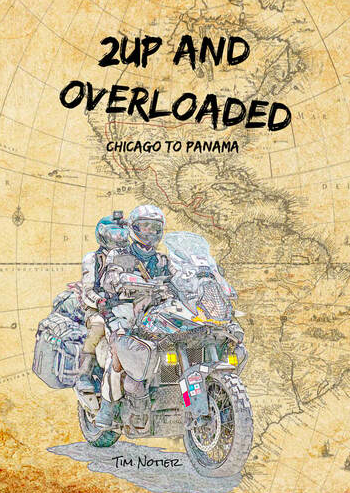 Purchase 2Up and Overloaded
Purchase 2Up and Overloaded 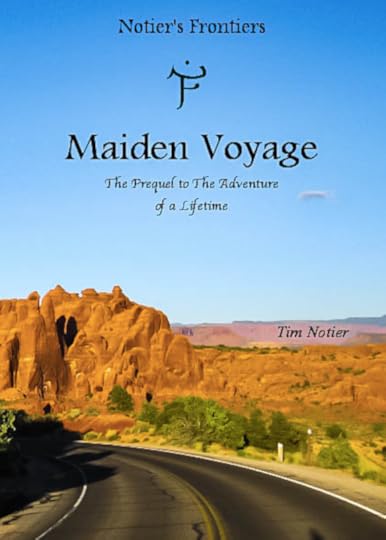 Purchase Maiden Voyage Not a fan of Amazon? Check out our Package Deals where you can get a digital copy of all three published books for only $20 via charge card or PayPal. There are also bundles that include some of our favorite prints of photos that we have taken throughout our journey.
Purchase Maiden Voyage Not a fan of Amazon? Check out our Package Deals where you can get a digital copy of all three published books for only $20 via charge card or PayPal. There are also bundles that include some of our favorite prints of photos that we have taken throughout our journey.
We would love to be able to inspire you to travel this magnificent world, via two wheels, four, or even by foot. We live on an amazing planet, and our only hope is to get your adventure blood pumping to get out there and explore it for yourself once these tough times have passed.
The following is an excerpt from the book 2Up and Overloaded.
Chapter 9 - Turnarounds
 After spending two nights just outside of the Grand Canyon, we turned around and headed back into Utah. Out of Utah’s ‘Mighty Five’ national parks—Zion, Bryce Canyon, Capitol Reef, Arches, and Canyonlands, we had only one national park left to check off our list from our previous visit: Zion.
After spending two nights just outside of the Grand Canyon, we turned around and headed back into Utah. Out of Utah’s ‘Mighty Five’ national parks—Zion, Bryce Canyon, Capitol Reef, Arches, and Canyonlands, we had only one national park left to check off our list from our previous visit: Zion.We rode into Zion as far as we were allowed by motorcycle. The public road ends at a main hub with large hotels and restaurants. From there, you have to take a network of buses that shuttle you further into the park. The buses fill up and let people off at specific waypoints. Trails with names like Court of the Patriarchs, Emerald Pools, and Temple of Sinawava all sounded like the titles of fantasy books I used to read as a kid, and they all led to the Narrows, the end of the line of the park.
The Narrows Trail doesn’t actually end, but it turns into the Virgin River that spreads from canyon wall to canyon wall. The river gets progressively deeper as you twist along the bends of the canyon. Sometimes we were waist deep as we navigated further along.
“How far do you want to go?” Marisa asked.
“Let’s get to the point where it weeds out most of the hikers,” I replied. “I would like to get some pictures that don’t have a hundred people in them.”
We lurched forward, expecting the crowds to thin around every corner, but there were always more people, just as stubborn as me to find a secluded section of this wonder.
After a couple of miles, we sat down to have a lunch break on a small section of land that wasn’t submerged. As we ate our sandwiches, a couple were having a photoshoot not too far in front of us. The woman was strutting her best poses, taking off her shirt slowly to reveal the bikini underneath and raising her arms in angelic positions for her beauty shots.
Her boyfriend was nailing each shot as she worked the hell out of that camera.
“Why don’t you take a picture, Tim?” Marisa asked as I stared, refusing to blink.
“Sometimes I just want to live in the moment,” I replied. “Do you see all of the glimmering stars and rays of light surrounding her in an aura of perfection?”
Then it was the Khal Drogo’s turn to striptease the camera. The woman took the camera and aimed it at his marble-like stature. Same poses, but with a masculine tone. With his shirt off, he bent and flexed for what I can only assume to be the cover shot of ‘Men’s Health’.
“Do you see the glimmering, Tim?” Marisa shot back. “The shadows in the tone of his muscles?”
“All right, all right. These two are clearly the descendants of Nordic Gods,” I said. “Did you ever see any of those movies where they piss in the same fountain when lightning strikes and they trade bodies, or a Chinese fortune cookie swaps the souls of two people?” I asked.
“Are you really going where I think you are going with this?” she replied.
“If you’re thinking I want to attempt to exchange bodies with those two beautiful creatures, then yes,” I said.
“How are you going to get him to pee in the river with you?” she asked.
“We have to at least try and do something,” I said. “Just concentrate really hard and do your best ‘I Dream of Jeannie’ impersonation.”
We both sat there in a meditative posture, with our hands locked on our elbows, our faces scrunched and wrinkled in full-on wish mode, all while nodding our heads and winking every once and a while.
“I don’t think it’s working,” I said after a while.
“I think it did,” Marisa said. “You’re the most gorgeous man I have ever seen.”
Both accepting our fate as who we were, and who we chose to be with, we continued down the river until finally feeling like we had seen enough and headed back. The Narrow’s constant flow of water was matched by the flood of people wading through its water.
The one thing that stood out to us about Zion was the accessibility of the majority of the sights. With the exception of The Narrows, most destinations were a short hike from one of the many shuttle stops. Large groups of people gathered together at the main attractions. We had felt a little more secluded at Bryce Canyon and Arches. Marisa and I were able to roam down different channels and avoid large clusters of other tourists while hiking through the other parks throughout Utah.
Zion seemed to be a stream-lined, cattle-herding, all-business model of a National Park. The park was beautiful, don’t get me wrong, but it just felt like we had bought admission tickets to an amusement park and had to wait in long lines to get to the most popular rides.
After a couple more walks to different sections of the park, we got back on a bus that would return us to our bike. It had been another amazing day filled with surreal sights. We searched for campgrounds on our phones and picked one on the banks of the Kolob Reservoir, just north of Zion. On the way, we stopped in a small town for lunch.
While in the parking lot of a Walmart, a woman walked up to us and introduced herself as Dana. She was so thrilled we were traveling via motorcycle and said we were more than welcome to stay with her. She said that her husband rides a motorcycle and would love to meet us.
We kindly took her number, but we had been self-sufficient up to that point and we were very much looking forward to some more camping. Besides, I felt awkward accepting someone’s invitation. I didn’t want to impose on anyone, nor did I think we had really done anything all that unique to be rewarded with special attention. But we thanked her for her offer and headed off to the campsite.
Once out of town, fields of Black-Eyed Susans lined the road on either side. The sky was a baby blue backdrop with clouds meandering around in no particular direction. The flat land yielded prairie-like grasses, shrubbery, and pine trees, then gave way to the jagged sections of rock that was Zion in the background. When we arrived at the reservoir, we knew we had found yet another slice of heaven.
 With plenty of spots to choose from and no other campers, we picked a site with an open view to the lake that perfectly mirrored the sky, the clouds above, the shoreline, and all the trees lining the edge. Ducks quacked as they swam around in circles, bobbing their heads underwater to nibble on the grass and weeds that grew beneath, and every once in a while, coming up with a small fish.
With plenty of spots to choose from and no other campers, we picked a site with an open view to the lake that perfectly mirrored the sky, the clouds above, the shoreline, and all the trees lining the edge. Ducks quacked as they swam around in circles, bobbing their heads underwater to nibble on the grass and weeds that grew beneath, and every once in a while, coming up with a small fish.We set up our tent and then brought our chairs to the lake’s edge as we just breathed in the day.
“Do you think this is another two or three-day spot?” I asked.
“I sure do. This reminds me of camping on the Rio Grande. It’s just so peaceful,” she replied.
There was a little store a couple of miles away that we could get vegetables and pasta from, and there was plenty of fresh water to filter, so we figured we had everything we needed.
When we woke up the next morning it was raining, then it started to hail. As we huddled in the tent, hail hammered the ground around us, causing splashes of water and mud to ricochet onto us from every direction. It was even getting at us from under the tent’s rainfly. We were stuck, and filthy, but there was no way I was going to pack up the tent while God’s wrath came down on us.
“We need food, love,” Marisa stated, after six hours of non-stop rain.
“We’ve eaten all of our peanuts and granola bars, and there’s nothing left.”
“All right. I’ll go to that little store and get some food,” I said.
“Good luck,” Marisa said as I got on my raingear and headed out of the tent.
I jumped on the bike and made my way to through some muddy sludge before turning right onto the gravel road. As soon as I turned right, my rear tire lost traction in the mud and kicked out to the left. It happened too quickly for me to counterbalance, and I dropped the bike not ten feet from where I had started.
“This is going to be awesome,” I said.
“Are you okay?” Marisa asked from the tent.
“I’ll be fine. The bike is unloaded, so there’s no reason for us both to get wet and muddy,” I grunted as I lifted the bike back upright.
I carefully continued on to the store. Most of the track was made up of water-filled trenches of mud and gook that I tried desperately not to fall into. The hail was coming down hard, clinking against my helmet, and each piece of frozen water that hit me felt like I was getting shot at with a paintball gun. I made it to the ‘Little House on the Prairie’ store that stood alone against the backdrop of absolutely nothing, and although I could not fathom who its clients were, I was thankful for its presence.
The sign on the front door displayed ‘Closed’. The little clock with red movable hands said that they would return at three. It was two. With nothing better to do, I sat underneath the awning of the store and chain-smoked as I watched the thick black clouds that blocked the sun deposit tons of hail on the earth below. Marisa was out there probably wondering if I was okay, especially after my not-so-graceful exit. I liked it when Marisa worried about me. It’s a guilty pleasure, but I liked knowing someone was thinking about my welfare and might even miss me if I were to perish. Even if only because her survival was directly tied into my own; but still, she cared.
Forty-five minutes and six cigarettes later, the owner came back and opened the door. It wasn’t even locked; he just opened the door and flipped the ‘closed’ sign around to ‘open’.
“If anyone were to come in while I wasn’t here, it’d usually just be Tommy, Frank, or Bill getting a pack of smokes or some bait, and most of the time they leave a note with some cash,” he said. “Not a lot of traffic around here, especially on days like today.”
“I just need some pasta, crackers, and some canned veggies to wait out the storm down by the reservoir,” I said.
“You may be there a while. The radar doesn’t show this letting up for a couple days,” he replied.
“Awesome.” I said as I grabbed a second can of beans, corn, and another bag of pasta.
I rode back in what seemed to be worse weather than I had ridden out in. It was one-hundred percent miserable, with a chance of awful. When I got back to the entrance of the reservoir, I saw a husband and wife duo that were two-up on an Africa Twin. One was covered in mud from helmet to boots, and they were putting the final pieces of luggage back on the bike.
“Where did you two come from?” I asked as I introduced myself.
“We camped here last night, and it has just been torrential rain since four o’clock this morning,” he replied. “I’m James, and this is my wife, Imogen.”
“Really? We camped here last night too. I just went out to get some food for my wife. Where did you guys camp? We’re just over there,” I said, as I pointed to the west side of the lake.
“We thought we saw lights across the lake last night,” James said. “We were on the opposite side, down that dirt hill that has now turned into a mudslide.”
“I had to push him up the bloody hill as he slipped around spraying mud all over me,” Imogen stated, pointing to the filth that covered her as she curtsied like a pageant queen.
“We’ve totally been there!” I laughed as I thought of Marisa doing the exact same thing.
They were from London and were the first world travelers I had met while on our own circumnavigation of the globe.
We stood there and chatted about their travels as well as our own short stint across the States as the weather beat down on us. We exchanged information and sadly had to part ways more quickly than I would have liked to. It had already been more than an hour, and I was sure Marisa was well past the worried point and probably completely freaking out. I got back on the bike and rode to camp.
“Oh, thank God you’re back,” she said as I crawled into the tent.
I showed her our survival kit of canned goods and pasta, and she immediately wished she had made the journey with me to purchase more nutritious food.
“We will survive, but we will not flourish,” I stated. “The guy at the store said it will be like this for a couple more days.”
“We should move on tomorrow, regardless of the weather then,” Marisa said.
“Agreed. I just met two other travelers who’ve packed up and headed off in this madness,” I told her.
It rained for the next fifteen hours straight. We went to sleep with nothing better to do except wait it out.
The next morning, the sky retreated from its hostile onslaught momentarily, and we seized the opportunity to get the hell out of there. As we packed up our gear, everything was coated in a muddy stew that added an additional ten pounds to the bike’s collective weight.
“This sucks,” I said in a cranky mood. “Not a single part of me is dry.”
“Let’s just make it to the next town. Everything we own needs to be washed, twice,” Marisa stated.
Hurricane was the closest town, and we pulled into the first hotel available. Marisa hopped off the bike to see how much the cheapest room was.
“A hundred-and-twenty bucks,” she said with a frown, as she came out the door.
We rode to another hotel. It was eighty dollars a night.
“We just can’t afford that,” I said.
I knew that all Marisa wanted in life was a warm shower and a bed, but those numbers were twice our daily budget.
“Call that Dana woman,” Marisa said.
“Really?” I asked.
“Why not?” she said. “We don’t have a lot of options here.”
“I feel uncomfortable asking for help from people I don’t know. And, we are not technically stranded, we’re just cheap,” I said.
“Then let’s get an eighty-dollar hotel room,” she replied.
“Okay, I’ll call her,” I said as I dug through my wallet looking for the piece of paper with her number on it.
“Hi, is this Dana?” I asked over the phone. “You met my wife and me a couple of days ago, and... said we might be able to stay with you if needed.”
“Of course!” She said over the phone. “We would be more than happy to have you stay with us!”
“Thank you so much. The rain just won’t stop, and we really don’t want to pay an arm and a leg for a basic room. But we don’t want to impose at all and...”
“Oh, stop ramblin’ on about being a burden and get yourself over here. I’ll fatten you up with some hot food and some whiskey,” she said, interrupting my prepared pity speech.
She gave us her address, and I thanked her again before hanging up.
“I think that woman is my Fairy Godmother,” I told Marisa.
We plugged her address into our Garmin and rode through the rain with the hopes of a hot meal, shower, and whiskey in the very near future. What she provided us was everything she promised and more.
We spent the next four days with two of the most amazing people we had ever met. Dana and her husband Bill were like an aunt and uncle that we had not seen for years. During the days we talked about her past life in the Mormon church, a life she has now retreated from ‘gracefully’. It was interesting as an outsider, talking to someone who was willing to discuss all of the dirty little secrets.
At night, we slept in her ‘Glamper’, an old RV that had stopped being completely functional long ago, but was now an external extension to her house. There was a comfortable bed, window shades, and an extension cord running through the top of the door that provided electricity to a small lamp and whatever gadgets we wanted to plug in.
Her property was dubbed Red Hen Gardens, and for good reason. There was a huge garden complete with every type of bean, corn, potato, and all the herbs that I could imagine. There were, of course, chickens, as well as a friendly dog that kept a watchful eye on us as we made ourselves at home.
There was a trampoline in a corner of the yard by some lawn chairs and a fire pit. The entire property was amazing to walk around and see all of the care and special touches she had put in place. One of the trees had the face of a woman carved into it. It was so realistic that I didn’t doubt the possibility that she might open her eyes and speak to me in some elvish tongue.
 Dana was a character that could be the star of a TV sitcom. A wonderfully positive woman who has been through hell on a road that was disguised as a pathway to heaven, but she had come out the other side still cheerful, compassionate, wise, and hysterically funny. I was completely fascinated and horrified by some of the stories Dana shared. I am not a religious man, and Dana had converted to atheism since leaving the Mormon church, so we had a good time poking fun at some of the obscure sections of religion. Marisa, on the other hand, is religious, so we were careful to not dig the knife in too hard, at least when she was present.
Dana was a character that could be the star of a TV sitcom. A wonderfully positive woman who has been through hell on a road that was disguised as a pathway to heaven, but she had come out the other side still cheerful, compassionate, wise, and hysterically funny. I was completely fascinated and horrified by some of the stories Dana shared. I am not a religious man, and Dana had converted to atheism since leaving the Mormon church, so we had a good time poking fun at some of the obscure sections of religion. Marisa, on the other hand, is religious, so we were careful to not dig the knife in too hard, at least when she was present.
On the last night, while drinking more whiskey than I probably should have, we sat in Dana’s living room listening to Stevie Ray Vaughn make his guitar weep with the blues. I started to think about our trip so far from an outside perspective. Not every day had been filled with pure excitement. In fact, there had been moments of complete frustration, either with the weather, the KTM dealership, or disagreements between Marisa and me about where to camp, for how long, and where to eat. But we always got ourselves back on course as a team.
I play guitar myself, and some of my favorite lines in the twelve-bar-blues progressions are the turnarounds. Little personal licks of emotion, dirty and gritty as they can be, that lead back to the main rhythm and comforting progression of the song.
We had experienced moments of our trip that seemed to have led to the unknown, truly blues-filled trials that had eventually led back into the standard harmonious patterns of our trip that we are accustomed to.
Turnarounds in my attitude, and the outlook of uncomfortable situations have deepened my understanding of uncertainty, that “Life is Chaos”, or more simply, “Chaos is”. I started to realize that the world was not out to get me, and that everything seemed to settle back to normal if given enough time, attention, or acceptance that some things will just not change.
It hasn’t been all bliss and wonder, but every moment had been an experience that I wouldn’t have traded for an easier path. Some of the worst roads led to the most beautiful camp sites, and some of the most stressful days led to meeting the most amazing people that I have ever encountered. * If you enjoyed this chapter, we would love for you to absorb the full experience, the ups and downs, and all of the excitement and beauty that we have found throughout our travels through the States, Mexico, and Central America through the pages of 2Up and Overloaded. If you have read the book and enjoyed the journey alongside us… it would be great if you were willing to spare just two or three minutes to share your review of the book on Amazon.
It would mean the absolute world to us!
Here’s the link to Amazon to add a review: Leave a Review
 Purchase 2Up and Overloaded
Purchase 2Up and Overloaded  Purchase Maiden Voyage Not a fan of Amazon? Check out our Package Deals where you can get a digital copy of all three published books for only $20 via charge card or PayPal. There are also bundles that include some of our favorite prints of photos that we have taken throughout our journey.
Purchase Maiden Voyage Not a fan of Amazon? Check out our Package Deals where you can get a digital copy of all three published books for only $20 via charge card or PayPal. There are also bundles that include some of our favorite prints of photos that we have taken throughout our journey.
We would love to be able to inspire you to travel this magnificent world, via two wheels, four, or even by foot. We live on an amazing planet, and our only hope is to get your adventure blood pumping to get out there and explore it for yourself once these tough times have passed.
Published on August 12, 2020 00:22
June 25, 2020
The Crown of Uganda - Lockdown Part 3
Tim Noiter 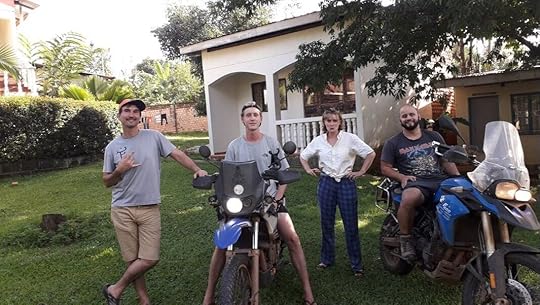 Me, Braden, Lucy, and Leo Marisa and I wanted to provide a little update of our lockdown situation. Sadly, our crew of five has whittled down to three. We said goodbye to Lucy over two months ago, and a couple weeks ago Leo flew back to the States.
Me, Braden, Lucy, and Leo Marisa and I wanted to provide a little update of our lockdown situation. Sadly, our crew of five has whittled down to three. We said goodbye to Lucy over two months ago, and a couple weeks ago Leo flew back to the States.
Now it is just Braden, Marisa, and me bunkering down here in Kampala. We would much rather be back out on the road, but we are thankful for the time that we have had here. We were able to participate in the Arm Chair Festival and had a blast talking with The Sidecar Guys. In a time where international overland travel has been halted, it was great to participate and to be part of an event that so many world travelers were involved in. Keep the adventure spirit alive! We also were interviewed alongside Sam Manicom, who as an author and an adventure traveler, is one of my biggest inspirations. It was truly surreal to be on a live interview with him via a magazine that I had been subscribed to in the years that led up to our own adventure. Marisa and I also made cameo appearances in two Adventure movies that have been released in the last couple of months! Christian Vogal's “Whatever May Come" and Dylan Wickrama's “When the Road Ends". Christian's movie is about his around-the-world motorcycle adventures, and has a love story that is mixed in with some hair-raising moments, all beautifully documented since he's a videographer. Dylan's movie is about his insane journey on a raft he built out of his motorcycle to cross the Darien Gap. We thought that we were crazy, that was until we saw his documentary.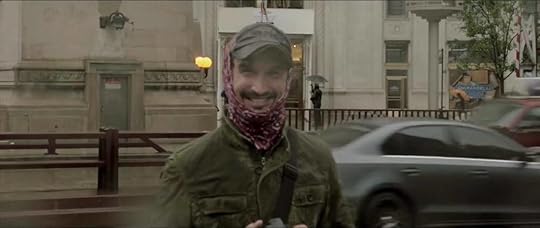 A screenshot from "Whatever May Come"
A screenshot from "Whatever May Come" 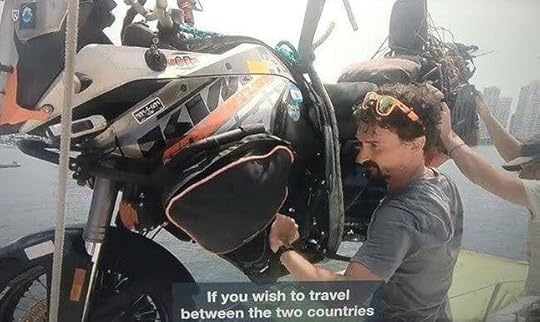 Me unloading our motorcycle in "When the Road Ends" Needless to say, it has been a fairly active past couple of months. In less exciting news for the general population, I bought new pants, pajamas, and a shirt! Marisa bought a dress and some flip-flops, these are luxury items that we often are not allowed to carry with us. We also have a pair of guitars that help strum away some of the day's idle moments.
Me unloading our motorcycle in "When the Road Ends" Needless to say, it has been a fairly active past couple of months. In less exciting news for the general population, I bought new pants, pajamas, and a shirt! Marisa bought a dress and some flip-flops, these are luxury items that we often are not allowed to carry with us. We also have a pair of guitars that help strum away some of the day's idle moments. 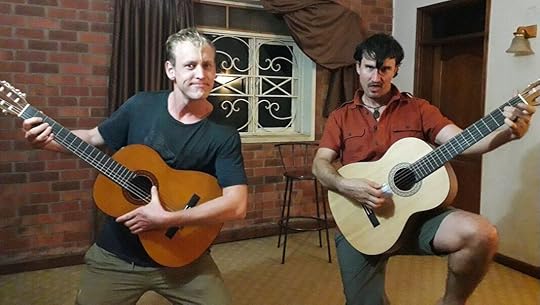 Our debut album is forthcoming... Stay tuned (even if we are out of tune...) We now spend our days working on our different projects. I have completed seven chapters of my third book, with the working title of: “Blood, Sweat, and Notiers"!
Our debut album is forthcoming... Stay tuned (even if we are out of tune...) We now spend our days working on our different projects. I have completed seven chapters of my third book, with the working title of: “Blood, Sweat, and Notiers"!
Marisa and I play cards, guitar, and watch crappy Netflix shows as the days go by. We celebrated my 38th birthday on June 17th, and our first anniversary on the 22nd!
But it hasn't been complete bliss, I went to a dentist and was informed that I needed a root canal... that's awesome... Back-alley dentist in Uganda...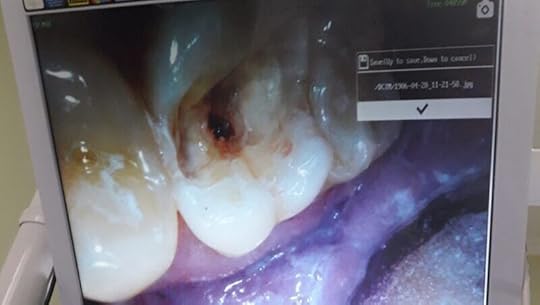 That isn't good... The dentist actually did an amazing job, and for just around $300 USD! I just had my Ugandan crown put on yesterday, and I'm back to chomping on ramon noodles and tuna salad like a pro.
That isn't good... The dentist actually did an amazing job, and for just around $300 USD! I just had my Ugandan crown put on yesterday, and I'm back to chomping on ramon noodles and tuna salad like a pro. 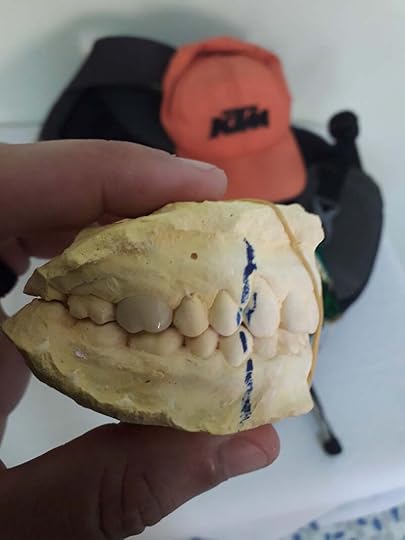 A crown fit for a prince... One last call to action, I would be forever grateful if you left a review on Amazon for either Maiden Voyage or 2Up and Overloaded! Reviews really help the book get in front of more potential customers, so if you liked it or hated it, please do leave a review that can just be a couple of sentences long.
A crown fit for a prince... One last call to action, I would be forever grateful if you left a review on Amazon for either Maiden Voyage or 2Up and Overloaded! Reviews really help the book get in front of more potential customers, so if you liked it or hated it, please do leave a review that can just be a couple of sentences long.
- Not a fan of Amazon? Shoot me an email at NotiersFrontiers@outlook.com and I would love to get you a PDF of either book for $9.99 via PayPal. When using PayPal, please be sure to put your email address and what book you are after in the comments so we can promptly send it to you!
For everyone that already has left a review, THANK YOU so much for the support!!!!
Marisa has a blog post on Rwanda in the works. Even though it was somewhat in the past, things got a little crazy here for a while. Subscribe to Our Blog
 Me, Braden, Lucy, and Leo Marisa and I wanted to provide a little update of our lockdown situation. Sadly, our crew of five has whittled down to three. We said goodbye to Lucy over two months ago, and a couple weeks ago Leo flew back to the States.
Me, Braden, Lucy, and Leo Marisa and I wanted to provide a little update of our lockdown situation. Sadly, our crew of five has whittled down to three. We said goodbye to Lucy over two months ago, and a couple weeks ago Leo flew back to the States.Now it is just Braden, Marisa, and me bunkering down here in Kampala. We would much rather be back out on the road, but we are thankful for the time that we have had here. We were able to participate in the Arm Chair Festival and had a blast talking with The Sidecar Guys. In a time where international overland travel has been halted, it was great to participate and to be part of an event that so many world travelers were involved in. Keep the adventure spirit alive! We also were interviewed alongside Sam Manicom, who as an author and an adventure traveler, is one of my biggest inspirations. It was truly surreal to be on a live interview with him via a magazine that I had been subscribed to in the years that led up to our own adventure. Marisa and I also made cameo appearances in two Adventure movies that have been released in the last couple of months! Christian Vogal's “Whatever May Come" and Dylan Wickrama's “When the Road Ends". Christian's movie is about his around-the-world motorcycle adventures, and has a love story that is mixed in with some hair-raising moments, all beautifully documented since he's a videographer. Dylan's movie is about his insane journey on a raft he built out of his motorcycle to cross the Darien Gap. We thought that we were crazy, that was until we saw his documentary.
 A screenshot from "Whatever May Come"
A screenshot from "Whatever May Come"  Me unloading our motorcycle in "When the Road Ends" Needless to say, it has been a fairly active past couple of months. In less exciting news for the general population, I bought new pants, pajamas, and a shirt! Marisa bought a dress and some flip-flops, these are luxury items that we often are not allowed to carry with us. We also have a pair of guitars that help strum away some of the day's idle moments.
Me unloading our motorcycle in "When the Road Ends" Needless to say, it has been a fairly active past couple of months. In less exciting news for the general population, I bought new pants, pajamas, and a shirt! Marisa bought a dress and some flip-flops, these are luxury items that we often are not allowed to carry with us. We also have a pair of guitars that help strum away some of the day's idle moments.  Our debut album is forthcoming... Stay tuned (even if we are out of tune...) We now spend our days working on our different projects. I have completed seven chapters of my third book, with the working title of: “Blood, Sweat, and Notiers"!
Our debut album is forthcoming... Stay tuned (even if we are out of tune...) We now spend our days working on our different projects. I have completed seven chapters of my third book, with the working title of: “Blood, Sweat, and Notiers"!Marisa and I play cards, guitar, and watch crappy Netflix shows as the days go by. We celebrated my 38th birthday on June 17th, and our first anniversary on the 22nd!
But it hasn't been complete bliss, I went to a dentist and was informed that I needed a root canal... that's awesome... Back-alley dentist in Uganda...
 That isn't good... The dentist actually did an amazing job, and for just around $300 USD! I just had my Ugandan crown put on yesterday, and I'm back to chomping on ramon noodles and tuna salad like a pro.
That isn't good... The dentist actually did an amazing job, and for just around $300 USD! I just had my Ugandan crown put on yesterday, and I'm back to chomping on ramon noodles and tuna salad like a pro.  A crown fit for a prince... One last call to action, I would be forever grateful if you left a review on Amazon for either Maiden Voyage or 2Up and Overloaded! Reviews really help the book get in front of more potential customers, so if you liked it or hated it, please do leave a review that can just be a couple of sentences long.
A crown fit for a prince... One last call to action, I would be forever grateful if you left a review on Amazon for either Maiden Voyage or 2Up and Overloaded! Reviews really help the book get in front of more potential customers, so if you liked it or hated it, please do leave a review that can just be a couple of sentences long. - Not a fan of Amazon? Shoot me an email at NotiersFrontiers@outlook.com and I would love to get you a PDF of either book for $9.99 via PayPal. When using PayPal, please be sure to put your email address and what book you are after in the comments so we can promptly send it to you!
For everyone that already has left a review, THANK YOU so much for the support!!!!
Marisa has a blog post on Rwanda in the works. Even though it was somewhat in the past, things got a little crazy here for a while. Subscribe to Our Blog
Published on June 25, 2020 22:56
March 30, 2020
Being in Africa during the Coronavirus Pandemic - Part 2
By Marisa 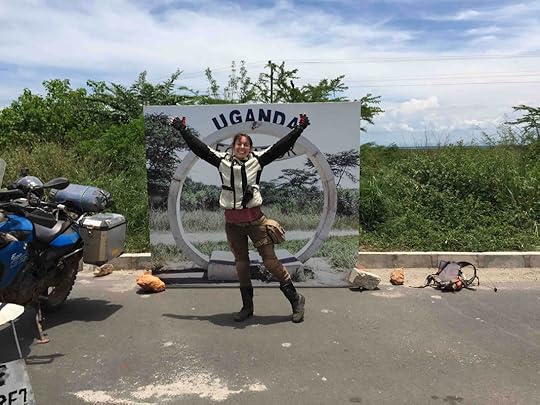 Here I am at Uganda's equator, back when we could still go out and about... That's right, while the Coronavirus makes its rampage around the world, we are in Uganda. The US State Department has just emailed me their last alert notifying any US citizens still in Uganda that there may be one final “care lift" flight out that will head back to the USA. This would be our last chance out, and our last chance to get home. It sounds dire and certainly scary, and the situation in the world is dire and scary, but after weighing all of our options, we have decided to stay in Uganda.
Here I am at Uganda's equator, back when we could still go out and about... That's right, while the Coronavirus makes its rampage around the world, we are in Uganda. The US State Department has just emailed me their last alert notifying any US citizens still in Uganda that there may be one final “care lift" flight out that will head back to the USA. This would be our last chance out, and our last chance to get home. It sounds dire and certainly scary, and the situation in the world is dire and scary, but after weighing all of our options, we have decided to stay in Uganda.
This has not been an easy choice, as it seems that finding a perfect “safe haven" no longer is a reality for us, or anyone for that matter. But I will try to convey in this post a sense of what life is like here in Uganda, and what our reasons are for staying. Plus, we'll give you a little tour of our new home. How bad is it in Uganda? Amazingly, Uganda and most of Sub-Saharan Africa (except maybe South Africa) has not been hit hard yet with the Coronavirus. As of today, Uganda has had 33 confirmed cases and nearly all of these have been from people who were immediately quarantined after flying in from other countries. So far, three of these cases were from one Ugandan transmitting the virus to his family members. But besides that, it has not spread within the country itself.
That we know of.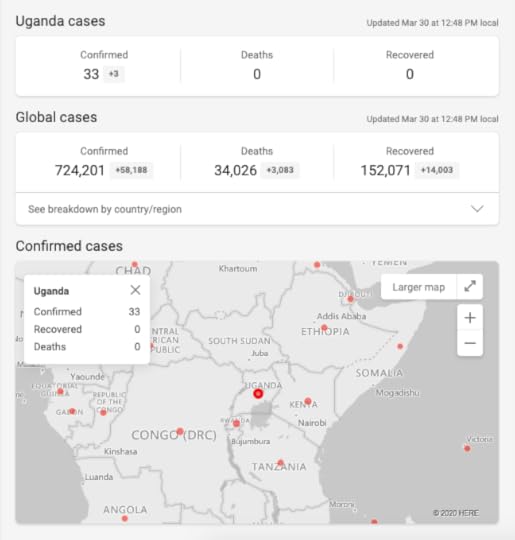 Will it be contained to these isolated cases? Well, it's nice to be optimistic, but if there's any indication from other countries of what this virus will do, the realistic answer would be it will probably spread.
Will it be contained to these isolated cases? Well, it's nice to be optimistic, but if there's any indication from other countries of what this virus will do, the realistic answer would be it will probably spread.
So now the real question is how will Uganda handle an outbreak? Life in Uganda Today As of today (March 31), Uganda is on a 14-day lock-down. The reason for this is because three of the institutionally quarantined travelers who tested positive for Coronavirus escaped a few days ago and interacted with the public. Therefore, all non-essential movement and most person-to-person contact will be suspended for two weeks in order to locate any new cases before this virus spreads.
Yesterday, life here continued more or less normally. Most people still went to work, and there was still plenty of traffic in the streets. Some things had been closed, such as schools and religious centers, the tourist industry had dried up, large social gatherings had been canceled, and the little mototaxis that zip around town had been forbidden. But besides that, daily life went on.
But today, things are supposed to change. No more driving around, even in private vehicles. No more going to work if you are not part of the allowed emergency and essential professions, and even if you are, you are supposed to camp and live next to your place of work for 14 days without going home. Unfortunately, I don't know how easy it will be to implement such social distancing and lock-down techniques here. This is a country where many people are used to living close together, sometimes with whole families staying in one room, and moving around is essential for many people to get their daily rice and bread.
But we will see. I believe if this country puts their mind to it, they can do anything for 14 days. But if it needs to be longer... there is no financial safety-net here big enough to support all the people that will need basic supplies without their jobs and without movement. So let's keep our fingers crossed for the people of Uganda.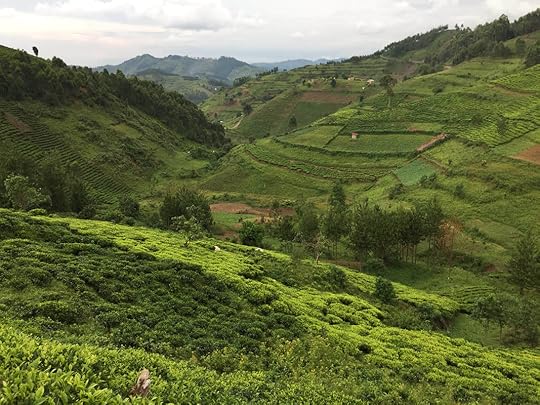 Uganda certainly is a beautiful country, and though it may not be wealthy, it is rich in basic necessities of food and water. The Ugandan Response This Coronavirus pandemic has not been easy for any government, but I'm actually quite impressed with Uganda's response. For not having a lot of resources to begin with, I think they've done a great job of coherently informing the public of every case and every step they make. They've implemented the use of the newest technology to locate the contacts of confirmed cases, they've categorized people according to their potential risk of having the virus, and they've tested and followed up on everyone they can.
Uganda certainly is a beautiful country, and though it may not be wealthy, it is rich in basic necessities of food and water. The Ugandan Response This Coronavirus pandemic has not been easy for any government, but I'm actually quite impressed with Uganda's response. For not having a lot of resources to begin with, I think they've done a great job of coherently informing the public of every case and every step they make. They've implemented the use of the newest technology to locate the contacts of confirmed cases, they've categorized people according to their potential risk of having the virus, and they've tested and followed up on everyone they can.
This is not Uganda's first time dealing with viral epidemics, and they have some good systems already in place from last year's ebola outbreak. I'm glad to see that the Ministry of Health, the president, and the government as a whole have taken this pandemic very seriously, and it appears like they are doing their best to keep the Ugandan people safe from the virus.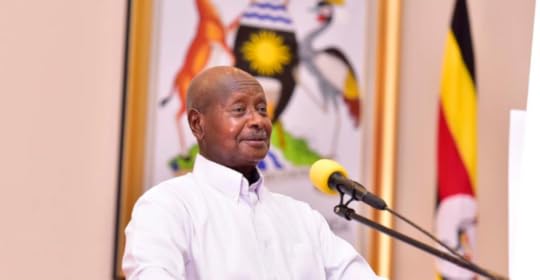 President Museveni of Uganda giving a speech on the Covid-19 situation. President Museveni has made many speeches to the nation about the situation, and he seems to be a respected and reassuring presence here. He speaks clearly and simply, and he does it all with a touch of humor. Also, the advice he gives is from scientists and specialists, as he's working hard to put into practice all the latest suggestions. He is also not afraid to administer harsh and economically-damaging measures in order to quell the spread of Coronavirus.
President Museveni of Uganda giving a speech on the Covid-19 situation. President Museveni has made many speeches to the nation about the situation, and he seems to be a respected and reassuring presence here. He speaks clearly and simply, and he does it all with a touch of humor. Also, the advice he gives is from scientists and specialists, as he's working hard to put into practice all the latest suggestions. He is also not afraid to administer harsh and economically-damaging measures in order to quell the spread of Coronavirus.
I hope that all of these precautions and measures work. We will see. The Pros of Staying in Uganda Besides Uganda having evaded a major outbreak so far, there are some real advantages for us staying here. Financially, it makes a lot of sense since life here is very cheap compared to life in the States, not to mention the cost of getting us (and the motorcycle?) back to the US.
But also we don't really have a home in the US to return to, since we quit our jobs and sold everything to travel the world on our motorcycle. This means that if we were to fly back, not only would we be taking a big risk of getting the Coronavirus on the several flights required to get us to Chicago (one of which is through NYC), but we'd have to stay with family and friends once there. Therefore, we'd risk infecting them, and this would be a nightmare situation for us.
The truth is, as far as prevention goes, it's much safer for us and everyone else if we stay here where we have a wonderful house to live in that we really never need to leave.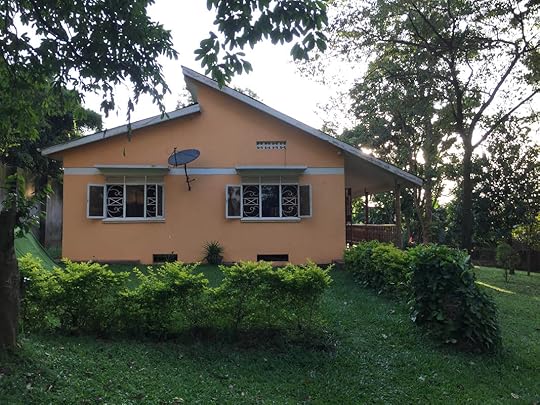 This is our house that we've rented. It's very comfortable and surrounded by beautiful property. The Cons of Staying in Uganda There are two very bad scenarios that could happen by staying here, but they are both unlikely. If we were to get the virus and need hospitalization, the health care system here is not up to Western standards. I don't even know how many ventilators are in Uganda, but I've heard three. I've also heard zero. Either way, it's not enough. It's almost laughable in a very sad, depressing way.
This is our house that we've rented. It's very comfortable and surrounded by beautiful property. The Cons of Staying in Uganda There are two very bad scenarios that could happen by staying here, but they are both unlikely. If we were to get the virus and need hospitalization, the health care system here is not up to Western standards. I don't even know how many ventilators are in Uganda, but I've heard three. I've also heard zero. Either way, it's not enough. It's almost laughable in a very sad, depressing way.
But there's no place on the planet right now that has enough ventilators, so like I said before, finding that perfect “safe haven" that will be able to care for and hospitalize everyone who needs it is almost non-existent at this point.
The other apocalyptic scenario that could happen here is if a lot of people die, and others are going hungry and are angry and need someone to blame, they may take it out on mzungus (white people). They already call this virus the mzungu corona.
But I see the chance of this happening on a large scale to be slim. We have found the Ugandan people to be extremely welcoming and understanding. Plus, the place we are at is well guarded with high fences all around, and the staff here are wonderful. Welcome to our new home! Thus, Tim and I are going to be here in Uganda for the long-haul. How long will that be? We don't know. But it will probably be a while.
So in the meantime, let me introduce you to our new home.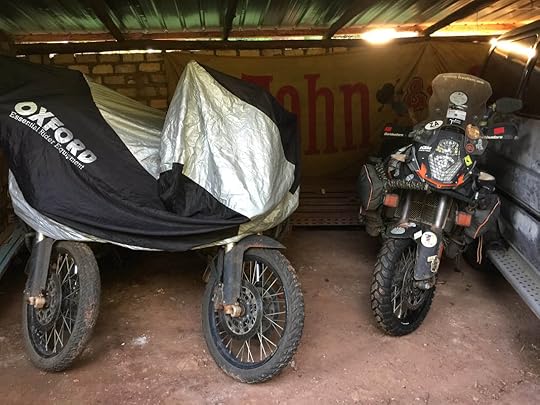 Here's our bike taking a break from the road with a couple new friends. She's got a new set of tires, so whenever we can get a chance to go out and adventure on her again, we're ready! We are living in a house that is connected to a hotel on the outskirts of Kampala, the capital city of Uganda. The hotel has a few live-in staff members, including the chef of the restaurant, the bartender, the gardener, and some 24-hr guards. So not only do we have our own kitchen that we've stocked up, but there's a restaurant and bar here as well (there's even a couple of pool tables).
Here's our bike taking a break from the road with a couple new friends. She's got a new set of tires, so whenever we can get a chance to go out and adventure on her again, we're ready! We are living in a house that is connected to a hotel on the outskirts of Kampala, the capital city of Uganda. The hotel has a few live-in staff members, including the chef of the restaurant, the bartender, the gardener, and some 24-hr guards. So not only do we have our own kitchen that we've stocked up, but there's a restaurant and bar here as well (there's even a couple of pool tables).
The property is huge and has lots of lawn space for going for a jog, doing exercises, or morning yoga, or simply reading in the shade of the banana trees. It's pretty nice, I have to admit.
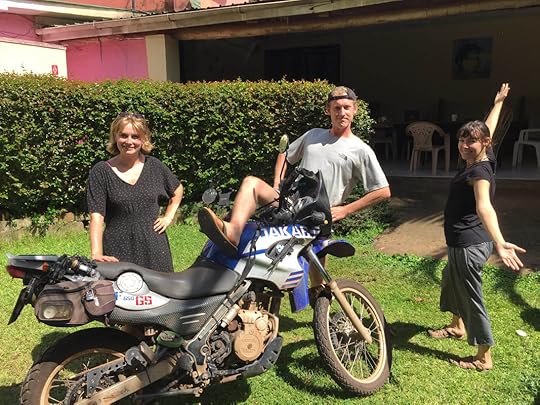 Lucy on the left, Braden in the middle, and me on the right, oh and Braden's BMW 650. The hotel is closed, but there are a few other foreigners living on the grounds, including two other motorcycle travelers: Leo, our Cuban/American friend who we were traveling with before the borders closed, and Braden, a Canadian who's been traveling through Africa on a GS650. There's also Lucy from the UK, but unfortunately for us, she will be taking the last flight back home this week.
Lucy on the left, Braden in the middle, and me on the right, oh and Braden's BMW 650. The hotel is closed, but there are a few other foreigners living on the grounds, including two other motorcycle travelers: Leo, our Cuban/American friend who we were traveling with before the borders closed, and Braden, a Canadian who's been traveling through Africa on a GS650. There's also Lucy from the UK, but unfortunately for us, she will be taking the last flight back home this week. 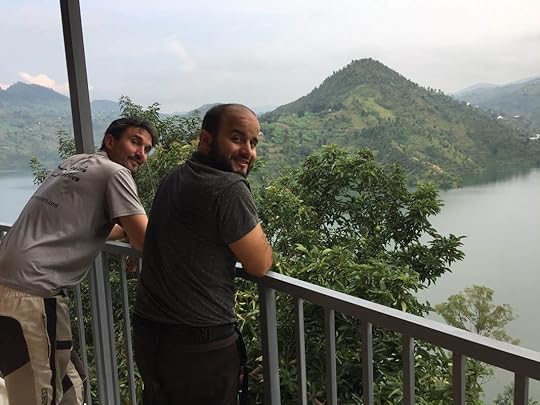 Tim and Leo overlooking Lake Kivu back in Rwanda. Despite being on the equator, the weather here is perfect every day. The sun is bright and hot, but the daily thunderstorms come to cool everything off. The plants and trees are vibrant and green from all the rains, and there are lots of interesting and exotic birds that hang out in the gardens.
Tim and Leo overlooking Lake Kivu back in Rwanda. Despite being on the equator, the weather here is perfect every day. The sun is bright and hot, but the daily thunderstorms come to cool everything off. The plants and trees are vibrant and green from all the rains, and there are lots of interesting and exotic birds that hang out in the gardens.
But I think my favorite part of the place is Tom, the Red-Tailed Monkey with white whiskers. He's a wild monkey that steals bananas and guavas from our trees, but of course he's so cute, everyone just lets him.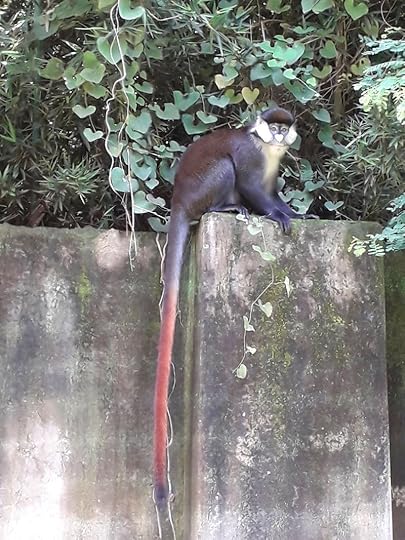 Tim was able to snap this picture of Tom from his phone, so it's not the best, but it shows his beautifully long tail and funny white whiskers. We made some runs to the mall a week ago to purchase a few anti-boredom necessities before the shops closed, such as three guitars (Tim is teaching Leo and Lucy) and an old Nintendo set with over 400 terrible games. With the addition of a deck of cards, a few dice for Farkle, and Leo's portable speaker, we've actually had a lot of fun here.
Tim was able to snap this picture of Tom from his phone, so it's not the best, but it shows his beautifully long tail and funny white whiskers. We made some runs to the mall a week ago to purchase a few anti-boredom necessities before the shops closed, such as three guitars (Tim is teaching Leo and Lucy) and an old Nintendo set with over 400 terrible games. With the addition of a deck of cards, a few dice for Farkle, and Leo's portable speaker, we've actually had a lot of fun here.
At the moment, no one is going in and out of the complex unless it's for an essential purchase, and we try to have one person buy everything for everyone. Besides that, we stay here doing our best to enjoy and entertain ourselves, and I'm trying not watch the news every moment of the day because it makes me crazy. But that is the basic summery of our life in Uganda.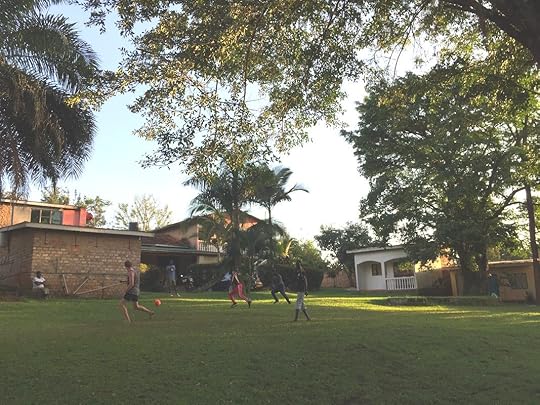 The staff members and Braden playing some soccer in the hotel's lawn area. It was nice while it lasted, but due to new social distancing rules, these afternoon games may have to be suspended. I truly hope that everyone out there is healthy and doing well. Please keep us updated on how you are doing through facebook or by commenting here.
The staff members and Braden playing some soccer in the hotel's lawn area. It was nice while it lasted, but due to new social distancing rules, these afternoon games may have to be suspended. I truly hope that everyone out there is healthy and doing well. Please keep us updated on how you are doing through facebook or by commenting here.
Stay safe. Subscribe to Our Blog
 Here I am at Uganda's equator, back when we could still go out and about... That's right, while the Coronavirus makes its rampage around the world, we are in Uganda. The US State Department has just emailed me their last alert notifying any US citizens still in Uganda that there may be one final “care lift" flight out that will head back to the USA. This would be our last chance out, and our last chance to get home. It sounds dire and certainly scary, and the situation in the world is dire and scary, but after weighing all of our options, we have decided to stay in Uganda.
Here I am at Uganda's equator, back when we could still go out and about... That's right, while the Coronavirus makes its rampage around the world, we are in Uganda. The US State Department has just emailed me their last alert notifying any US citizens still in Uganda that there may be one final “care lift" flight out that will head back to the USA. This would be our last chance out, and our last chance to get home. It sounds dire and certainly scary, and the situation in the world is dire and scary, but after weighing all of our options, we have decided to stay in Uganda.This has not been an easy choice, as it seems that finding a perfect “safe haven" no longer is a reality for us, or anyone for that matter. But I will try to convey in this post a sense of what life is like here in Uganda, and what our reasons are for staying. Plus, we'll give you a little tour of our new home. How bad is it in Uganda? Amazingly, Uganda and most of Sub-Saharan Africa (except maybe South Africa) has not been hit hard yet with the Coronavirus. As of today, Uganda has had 33 confirmed cases and nearly all of these have been from people who were immediately quarantined after flying in from other countries. So far, three of these cases were from one Ugandan transmitting the virus to his family members. But besides that, it has not spread within the country itself.
That we know of.
 Will it be contained to these isolated cases? Well, it's nice to be optimistic, but if there's any indication from other countries of what this virus will do, the realistic answer would be it will probably spread.
Will it be contained to these isolated cases? Well, it's nice to be optimistic, but if there's any indication from other countries of what this virus will do, the realistic answer would be it will probably spread.So now the real question is how will Uganda handle an outbreak? Life in Uganda Today As of today (March 31), Uganda is on a 14-day lock-down. The reason for this is because three of the institutionally quarantined travelers who tested positive for Coronavirus escaped a few days ago and interacted with the public. Therefore, all non-essential movement and most person-to-person contact will be suspended for two weeks in order to locate any new cases before this virus spreads.
Yesterday, life here continued more or less normally. Most people still went to work, and there was still plenty of traffic in the streets. Some things had been closed, such as schools and religious centers, the tourist industry had dried up, large social gatherings had been canceled, and the little mototaxis that zip around town had been forbidden. But besides that, daily life went on.
But today, things are supposed to change. No more driving around, even in private vehicles. No more going to work if you are not part of the allowed emergency and essential professions, and even if you are, you are supposed to camp and live next to your place of work for 14 days without going home. Unfortunately, I don't know how easy it will be to implement such social distancing and lock-down techniques here. This is a country where many people are used to living close together, sometimes with whole families staying in one room, and moving around is essential for many people to get their daily rice and bread.
But we will see. I believe if this country puts their mind to it, they can do anything for 14 days. But if it needs to be longer... there is no financial safety-net here big enough to support all the people that will need basic supplies without their jobs and without movement. So let's keep our fingers crossed for the people of Uganda.
 Uganda certainly is a beautiful country, and though it may not be wealthy, it is rich in basic necessities of food and water. The Ugandan Response This Coronavirus pandemic has not been easy for any government, but I'm actually quite impressed with Uganda's response. For not having a lot of resources to begin with, I think they've done a great job of coherently informing the public of every case and every step they make. They've implemented the use of the newest technology to locate the contacts of confirmed cases, they've categorized people according to their potential risk of having the virus, and they've tested and followed up on everyone they can.
Uganda certainly is a beautiful country, and though it may not be wealthy, it is rich in basic necessities of food and water. The Ugandan Response This Coronavirus pandemic has not been easy for any government, but I'm actually quite impressed with Uganda's response. For not having a lot of resources to begin with, I think they've done a great job of coherently informing the public of every case and every step they make. They've implemented the use of the newest technology to locate the contacts of confirmed cases, they've categorized people according to their potential risk of having the virus, and they've tested and followed up on everyone they can.This is not Uganda's first time dealing with viral epidemics, and they have some good systems already in place from last year's ebola outbreak. I'm glad to see that the Ministry of Health, the president, and the government as a whole have taken this pandemic very seriously, and it appears like they are doing their best to keep the Ugandan people safe from the virus.
 President Museveni of Uganda giving a speech on the Covid-19 situation. President Museveni has made many speeches to the nation about the situation, and he seems to be a respected and reassuring presence here. He speaks clearly and simply, and he does it all with a touch of humor. Also, the advice he gives is from scientists and specialists, as he's working hard to put into practice all the latest suggestions. He is also not afraid to administer harsh and economically-damaging measures in order to quell the spread of Coronavirus.
President Museveni of Uganda giving a speech on the Covid-19 situation. President Museveni has made many speeches to the nation about the situation, and he seems to be a respected and reassuring presence here. He speaks clearly and simply, and he does it all with a touch of humor. Also, the advice he gives is from scientists and specialists, as he's working hard to put into practice all the latest suggestions. He is also not afraid to administer harsh and economically-damaging measures in order to quell the spread of Coronavirus.I hope that all of these precautions and measures work. We will see. The Pros of Staying in Uganda Besides Uganda having evaded a major outbreak so far, there are some real advantages for us staying here. Financially, it makes a lot of sense since life here is very cheap compared to life in the States, not to mention the cost of getting us (and the motorcycle?) back to the US.
But also we don't really have a home in the US to return to, since we quit our jobs and sold everything to travel the world on our motorcycle. This means that if we were to fly back, not only would we be taking a big risk of getting the Coronavirus on the several flights required to get us to Chicago (one of which is through NYC), but we'd have to stay with family and friends once there. Therefore, we'd risk infecting them, and this would be a nightmare situation for us.
The truth is, as far as prevention goes, it's much safer for us and everyone else if we stay here where we have a wonderful house to live in that we really never need to leave.
 This is our house that we've rented. It's very comfortable and surrounded by beautiful property. The Cons of Staying in Uganda There are two very bad scenarios that could happen by staying here, but they are both unlikely. If we were to get the virus and need hospitalization, the health care system here is not up to Western standards. I don't even know how many ventilators are in Uganda, but I've heard three. I've also heard zero. Either way, it's not enough. It's almost laughable in a very sad, depressing way.
This is our house that we've rented. It's very comfortable and surrounded by beautiful property. The Cons of Staying in Uganda There are two very bad scenarios that could happen by staying here, but they are both unlikely. If we were to get the virus and need hospitalization, the health care system here is not up to Western standards. I don't even know how many ventilators are in Uganda, but I've heard three. I've also heard zero. Either way, it's not enough. It's almost laughable in a very sad, depressing way.But there's no place on the planet right now that has enough ventilators, so like I said before, finding that perfect “safe haven" that will be able to care for and hospitalize everyone who needs it is almost non-existent at this point.
The other apocalyptic scenario that could happen here is if a lot of people die, and others are going hungry and are angry and need someone to blame, they may take it out on mzungus (white people). They already call this virus the mzungu corona.
But I see the chance of this happening on a large scale to be slim. We have found the Ugandan people to be extremely welcoming and understanding. Plus, the place we are at is well guarded with high fences all around, and the staff here are wonderful. Welcome to our new home! Thus, Tim and I are going to be here in Uganda for the long-haul. How long will that be? We don't know. But it will probably be a while.
So in the meantime, let me introduce you to our new home.
 Here's our bike taking a break from the road with a couple new friends. She's got a new set of tires, so whenever we can get a chance to go out and adventure on her again, we're ready! We are living in a house that is connected to a hotel on the outskirts of Kampala, the capital city of Uganda. The hotel has a few live-in staff members, including the chef of the restaurant, the bartender, the gardener, and some 24-hr guards. So not only do we have our own kitchen that we've stocked up, but there's a restaurant and bar here as well (there's even a couple of pool tables).
Here's our bike taking a break from the road with a couple new friends. She's got a new set of tires, so whenever we can get a chance to go out and adventure on her again, we're ready! We are living in a house that is connected to a hotel on the outskirts of Kampala, the capital city of Uganda. The hotel has a few live-in staff members, including the chef of the restaurant, the bartender, the gardener, and some 24-hr guards. So not only do we have our own kitchen that we've stocked up, but there's a restaurant and bar here as well (there's even a couple of pool tables).The property is huge and has lots of lawn space for going for a jog, doing exercises, or morning yoga, or simply reading in the shade of the banana trees. It's pretty nice, I have to admit.
 Lucy on the left, Braden in the middle, and me on the right, oh and Braden's BMW 650. The hotel is closed, but there are a few other foreigners living on the grounds, including two other motorcycle travelers: Leo, our Cuban/American friend who we were traveling with before the borders closed, and Braden, a Canadian who's been traveling through Africa on a GS650. There's also Lucy from the UK, but unfortunately for us, she will be taking the last flight back home this week.
Lucy on the left, Braden in the middle, and me on the right, oh and Braden's BMW 650. The hotel is closed, but there are a few other foreigners living on the grounds, including two other motorcycle travelers: Leo, our Cuban/American friend who we were traveling with before the borders closed, and Braden, a Canadian who's been traveling through Africa on a GS650. There's also Lucy from the UK, but unfortunately for us, she will be taking the last flight back home this week.  Tim and Leo overlooking Lake Kivu back in Rwanda. Despite being on the equator, the weather here is perfect every day. The sun is bright and hot, but the daily thunderstorms come to cool everything off. The plants and trees are vibrant and green from all the rains, and there are lots of interesting and exotic birds that hang out in the gardens.
Tim and Leo overlooking Lake Kivu back in Rwanda. Despite being on the equator, the weather here is perfect every day. The sun is bright and hot, but the daily thunderstorms come to cool everything off. The plants and trees are vibrant and green from all the rains, and there are lots of interesting and exotic birds that hang out in the gardens.
But I think my favorite part of the place is Tom, the Red-Tailed Monkey with white whiskers. He's a wild monkey that steals bananas and guavas from our trees, but of course he's so cute, everyone just lets him.
 Tim was able to snap this picture of Tom from his phone, so it's not the best, but it shows his beautifully long tail and funny white whiskers. We made some runs to the mall a week ago to purchase a few anti-boredom necessities before the shops closed, such as three guitars (Tim is teaching Leo and Lucy) and an old Nintendo set with over 400 terrible games. With the addition of a deck of cards, a few dice for Farkle, and Leo's portable speaker, we've actually had a lot of fun here.
Tim was able to snap this picture of Tom from his phone, so it's not the best, but it shows his beautifully long tail and funny white whiskers. We made some runs to the mall a week ago to purchase a few anti-boredom necessities before the shops closed, such as three guitars (Tim is teaching Leo and Lucy) and an old Nintendo set with over 400 terrible games. With the addition of a deck of cards, a few dice for Farkle, and Leo's portable speaker, we've actually had a lot of fun here.At the moment, no one is going in and out of the complex unless it's for an essential purchase, and we try to have one person buy everything for everyone. Besides that, we stay here doing our best to enjoy and entertain ourselves, and I'm trying not watch the news every moment of the day because it makes me crazy. But that is the basic summery of our life in Uganda.
 The staff members and Braden playing some soccer in the hotel's lawn area. It was nice while it lasted, but due to new social distancing rules, these afternoon games may have to be suspended. I truly hope that everyone out there is healthy and doing well. Please keep us updated on how you are doing through facebook or by commenting here.
The staff members and Braden playing some soccer in the hotel's lawn area. It was nice while it lasted, but due to new social distancing rules, these afternoon games may have to be suspended. I truly hope that everyone out there is healthy and doing well. Please keep us updated on how you are doing through facebook or by commenting here.Stay safe. Subscribe to Our Blog
Published on March 30, 2020 02:31
March 14, 2020
Being in Africa during the Coronavirus Pandemic - Part 1
By Marisa 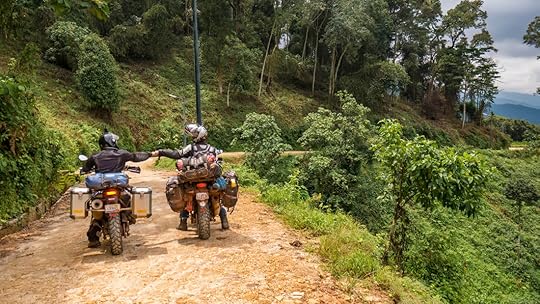 Oh no! Not the fist-bump! Everybody knows not to fist-bump! In any emergency situation, my first instinct is always to go where I feel most safe. In the case of this COVID-19 Coronavirus pandemic that is gripping the globe, that's my first reaction once again: to leave Uganda and fly home to Chicago where I can be with friends and family.
Oh no! Not the fist-bump! Everybody knows not to fist-bump! In any emergency situation, my first instinct is always to go where I feel most safe. In the case of this COVID-19 Coronavirus pandemic that is gripping the globe, that's my first reaction once again: to leave Uganda and fly home to Chicago where I can be with friends and family.
But upon further reflection, Tim and I have decided that it may be best for us to wait out the storm in Africa, even if that means we'll be quarantined and on lock-down in whichever country we find ourselves in. Uganda, Kenya, or Ethiopia are our immediate options, though it's not like we'll have a choice when it happens. And when the lock-down begins, we'll be stuck. For how long, we don't know.
Is this really the best option for us? Well, there's no saying for sure, but the following is a snapshot of what's been happening out here, and why we're choosing not to leave. The Situation Now in East Africa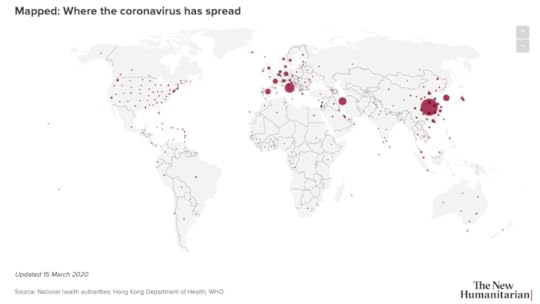 So far, life here in Uganda is continuing like normal. The Coronavirus hit Sub-Saharan Africa very late in this pandemic and is still reported as only isolated cases in large cities and international hubs such as Nairobi, Kenya or Addis Ababa, Ethiopia. There have been no major outbreaks in the entire region. Yet.
So far, life here in Uganda is continuing like normal. The Coronavirus hit Sub-Saharan Africa very late in this pandemic and is still reported as only isolated cases in large cities and international hubs such as Nairobi, Kenya or Addis Ababa, Ethiopia. There have been no major outbreaks in the entire region. Yet.
That means that businesses are still open, there are even other tourists at the hotels going on safaris and hiking through the national parks. Stores are full of supplies and no one is panic buying. Yes, there is even toilet paper, but in all honesty, most people out here have squat toilets and don't use toilet paper.
In some ways, this region is well-equipped to go into survival mode. Most people who live in rural areas rely on food grown and raised right in their backyard, and the rainy season has provided the region with lots of healthy crops and gardens. We are in an area of fresh water lakes, while herds of cows graze through the fields. So no one seems to be concerned with running out of basic necessities. Even electricity is often obtained from solar panels.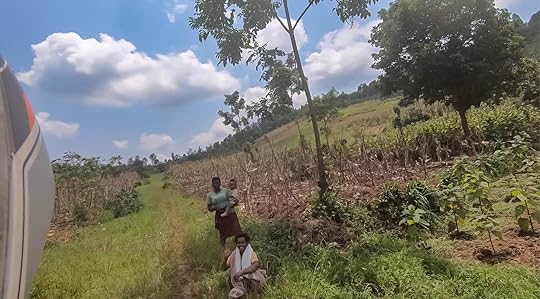 Most people in this part of the world are subsistence farmers. But that doesn't mean that people here aren't taking the Coronavirus seriously. In fact, they know all about viral outbreaks, and have many systems and practices in place from when Ebola was a big concern a year ago.
Most people in this part of the world are subsistence farmers. But that doesn't mean that people here aren't taking the Coronavirus seriously. In fact, they know all about viral outbreaks, and have many systems and practices in place from when Ebola was a big concern a year ago.
At the border between Rwanda and Uganda they were taking everyone's temperatures, forcing you to sterilize your boots and hands, and the guards and medical personnel were wearing masks and gloves. I have to say, it did look a bit apocalyptic to see a camo-clad soldier holding an AK47 with rubber gloves on and a doctor's face mask. What sort of bio-terrorism guerrilla warfare sci-fi tv show have we stepped into?
Outside of the border, no one on the street is wearing masks. But everyone is watching the news closely, washing their hands, giving elbow bumps instead of hand shakes. They know the drill here, and no one in Africa makes fun of virus epidemics. It's an unfortunate part of African life. What will happen as it spreads... Well, no one can say for sure what will happen. There are now only a few confirmed cases of the Coronavirus in East Africa at the moment. But if there's any indication of what's been happening in other countries, this virus will spread undetected elsewhere in the region. And when it does, the already fragile health care system of these countries might be be overwhelmed.
East Africa has some real disadvantages in the fight against this pandemic, such as poor economies based in tourism that may not easily recover from a financial slump, few qualified health care professionals, and a lack of a solid medical infrastructure. But Africa may also have a couple of advantages.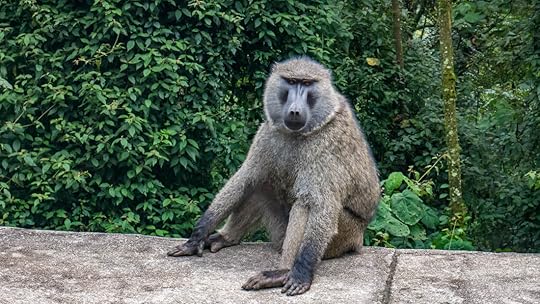 Africa is a continent of young people, who usually only get mild symptoms of the virus and don't need hospitalization (though they can still spread it). Only 2.7% of Kenyans are 65 and older, compared to 14% in the US (source).
Africa is a continent of young people, who usually only get mild symptoms of the virus and don't need hospitalization (though they can still spread it). Only 2.7% of Kenyans are 65 and older, compared to 14% in the US (source).
Those are who are smokers are also more susceptible to having serious complications of the Coronavirus. I'm happy to say that Tim quit smoking nearly a year ago, and we're now more thankful than ever that he did. But besides him, East Africa doesn't have a lot of smokers: only 4% of adults in Ethiopia are smokers compared to 21% in the US as of 2018 (source).
I can only hope that these factors will spare East Africa from becoming a humanitarian disaster. This is just a hope though, as the only way to truly know is to wait and see. Our Plan So instead of spending thousands of dollars on last-minute airfare, along with flying our bike back to the States, we've decided to stay. Being close to friends and family may be what we want, but it's also what the virus wants.
We will most likely need to renew and extend our visas, and if there's a quarantine and we're forced to stay put, I have no idea how that will affect our visas, as this is all unprecedented. But we'll find out I suppose.
Maybe if we are in a place long-term, we'll rent an apartment. We're still traveling with Leo, which has been wonderful, and especially in a difficult situation, it's good to have a friend around so that we know we're not in this alone.
Also, we are so thankful to have the messages and well-wishes from all of you out there, and we wish only the same for you.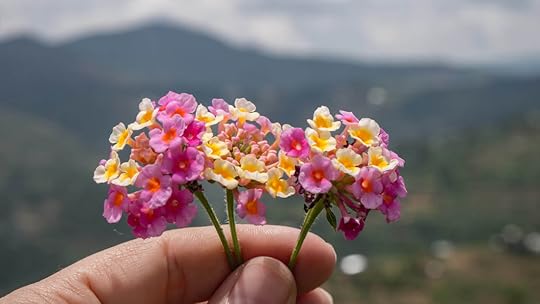 Because above all, we hope that you stay safe, and please keep us updated just as we will keep you updated.
Because above all, we hope that you stay safe, and please keep us updated just as we will keep you updated.
We'll write Part 2 once we know how things out here are going to progress. Subscribe to Our Blog
 Oh no! Not the fist-bump! Everybody knows not to fist-bump! In any emergency situation, my first instinct is always to go where I feel most safe. In the case of this COVID-19 Coronavirus pandemic that is gripping the globe, that's my first reaction once again: to leave Uganda and fly home to Chicago where I can be with friends and family.
Oh no! Not the fist-bump! Everybody knows not to fist-bump! In any emergency situation, my first instinct is always to go where I feel most safe. In the case of this COVID-19 Coronavirus pandemic that is gripping the globe, that's my first reaction once again: to leave Uganda and fly home to Chicago where I can be with friends and family.But upon further reflection, Tim and I have decided that it may be best for us to wait out the storm in Africa, even if that means we'll be quarantined and on lock-down in whichever country we find ourselves in. Uganda, Kenya, or Ethiopia are our immediate options, though it's not like we'll have a choice when it happens. And when the lock-down begins, we'll be stuck. For how long, we don't know.
Is this really the best option for us? Well, there's no saying for sure, but the following is a snapshot of what's been happening out here, and why we're choosing not to leave. The Situation Now in East Africa
 So far, life here in Uganda is continuing like normal. The Coronavirus hit Sub-Saharan Africa very late in this pandemic and is still reported as only isolated cases in large cities and international hubs such as Nairobi, Kenya or Addis Ababa, Ethiopia. There have been no major outbreaks in the entire region. Yet.
So far, life here in Uganda is continuing like normal. The Coronavirus hit Sub-Saharan Africa very late in this pandemic and is still reported as only isolated cases in large cities and international hubs such as Nairobi, Kenya or Addis Ababa, Ethiopia. There have been no major outbreaks in the entire region. Yet.That means that businesses are still open, there are even other tourists at the hotels going on safaris and hiking through the national parks. Stores are full of supplies and no one is panic buying. Yes, there is even toilet paper, but in all honesty, most people out here have squat toilets and don't use toilet paper.
In some ways, this region is well-equipped to go into survival mode. Most people who live in rural areas rely on food grown and raised right in their backyard, and the rainy season has provided the region with lots of healthy crops and gardens. We are in an area of fresh water lakes, while herds of cows graze through the fields. So no one seems to be concerned with running out of basic necessities. Even electricity is often obtained from solar panels.
 Most people in this part of the world are subsistence farmers. But that doesn't mean that people here aren't taking the Coronavirus seriously. In fact, they know all about viral outbreaks, and have many systems and practices in place from when Ebola was a big concern a year ago.
Most people in this part of the world are subsistence farmers. But that doesn't mean that people here aren't taking the Coronavirus seriously. In fact, they know all about viral outbreaks, and have many systems and practices in place from when Ebola was a big concern a year ago. At the border between Rwanda and Uganda they were taking everyone's temperatures, forcing you to sterilize your boots and hands, and the guards and medical personnel were wearing masks and gloves. I have to say, it did look a bit apocalyptic to see a camo-clad soldier holding an AK47 with rubber gloves on and a doctor's face mask. What sort of bio-terrorism guerrilla warfare sci-fi tv show have we stepped into?
Outside of the border, no one on the street is wearing masks. But everyone is watching the news closely, washing their hands, giving elbow bumps instead of hand shakes. They know the drill here, and no one in Africa makes fun of virus epidemics. It's an unfortunate part of African life. What will happen as it spreads... Well, no one can say for sure what will happen. There are now only a few confirmed cases of the Coronavirus in East Africa at the moment. But if there's any indication of what's been happening in other countries, this virus will spread undetected elsewhere in the region. And when it does, the already fragile health care system of these countries might be be overwhelmed.
East Africa has some real disadvantages in the fight against this pandemic, such as poor economies based in tourism that may not easily recover from a financial slump, few qualified health care professionals, and a lack of a solid medical infrastructure. But Africa may also have a couple of advantages.
 Africa is a continent of young people, who usually only get mild symptoms of the virus and don't need hospitalization (though they can still spread it). Only 2.7% of Kenyans are 65 and older, compared to 14% in the US (source).
Africa is a continent of young people, who usually only get mild symptoms of the virus and don't need hospitalization (though they can still spread it). Only 2.7% of Kenyans are 65 and older, compared to 14% in the US (source).Those are who are smokers are also more susceptible to having serious complications of the Coronavirus. I'm happy to say that Tim quit smoking nearly a year ago, and we're now more thankful than ever that he did. But besides him, East Africa doesn't have a lot of smokers: only 4% of adults in Ethiopia are smokers compared to 21% in the US as of 2018 (source).
I can only hope that these factors will spare East Africa from becoming a humanitarian disaster. This is just a hope though, as the only way to truly know is to wait and see. Our Plan So instead of spending thousands of dollars on last-minute airfare, along with flying our bike back to the States, we've decided to stay. Being close to friends and family may be what we want, but it's also what the virus wants.
We will most likely need to renew and extend our visas, and if there's a quarantine and we're forced to stay put, I have no idea how that will affect our visas, as this is all unprecedented. But we'll find out I suppose.
Maybe if we are in a place long-term, we'll rent an apartment. We're still traveling with Leo, which has been wonderful, and especially in a difficult situation, it's good to have a friend around so that we know we're not in this alone.
Also, we are so thankful to have the messages and well-wishes from all of you out there, and we wish only the same for you.
 Because above all, we hope that you stay safe, and please keep us updated just as we will keep you updated.
Because above all, we hope that you stay safe, and please keep us updated just as we will keep you updated.We'll write Part 2 once we know how things out here are going to progress. Subscribe to Our Blog
Published on March 14, 2020 23:32
March 6, 2020
Saying Goodbye to Tanzania
By Marisa
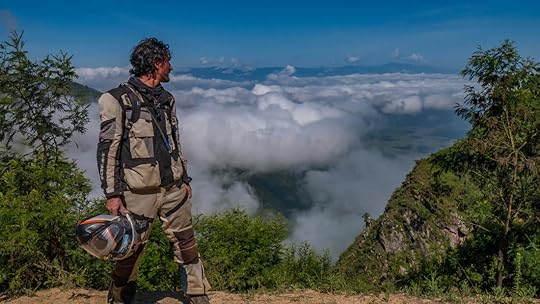 Our time traveling through Tanzania was a bit different than what most tourists do. Due to costs, we didn't go on any safaris and we didn't hike up Mount Kilimanjaro or snorkel around Zanzibar. But what we did see and do in Tanzania was truly memorable, unique, and special, not because of lions and elephants, but because of the people we met along the way.
Our time traveling through Tanzania was a bit different than what most tourists do. Due to costs, we didn't go on any safaris and we didn't hike up Mount Kilimanjaro or snorkel around Zanzibar. But what we did see and do in Tanzania was truly memorable, unique, and special, not because of lions and elephants, but because of the people we met along the way.
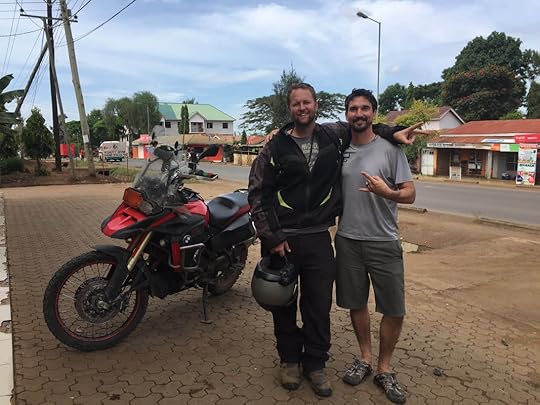 Simon and Tim in Arusha, Tanzania.It started with Simon in Arusha who gave us advice on some incredible roads that we took in the north and east of Tanzania. Along these roads, we got to meet the nomadic Maasai people, test our skills on a treacherous mountain pass into the clouds, and finally we camped on the beach listening to the waves crash along the warm coast of the Indian Ocean.
Simon and Tim in Arusha, Tanzania.It started with Simon in Arusha who gave us advice on some incredible roads that we took in the north and east of Tanzania. Along these roads, we got to meet the nomadic Maasai people, test our skills on a treacherous mountain pass into the clouds, and finally we camped on the beach listening to the waves crash along the warm coast of the Indian Ocean.
But throughout these adventures, we noticed that the bike kept dying randomly. This problem first started in Malawi, but it had seemed to go away until it reared its ugly head again in northern Tanzania. It was an electrical problem, that we knew. Somewhere there was a short happening that was causing the bike to suddenly shut off out of nowhere. But finding that electrical short amidst the tangle of wires that makes up our KTM 1190 was a truly daunting task.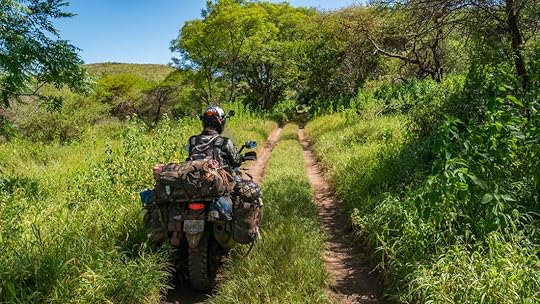 Of course, the bike always seemed to die whenever we found ourselves in the middle of nowhere.And then we were told about Sam in Moshi, Tanzania. No, there aren't any KTM dealerships in Tanzania, but Sam was the closest thing to one that we were going to find.
Of course, the bike always seemed to die whenever we found ourselves in the middle of nowhere.And then we were told about Sam in Moshi, Tanzania. No, there aren't any KTM dealerships in Tanzania, but Sam was the closest thing to one that we were going to find.
His real name is Samatarxavier (coolest name ever!) and he owns agarage in Moshi that repairs vehicles as well as gives motorcycle tours of the incredible surrounding area and wildlife parks. And I think he was sent from heaven because in less than 15 minutes he had diagnosed and fixed this motorcycle problem that had been plaguing us for more than a month! Like we'd suspected, it was a wire that was sometimes bumping into the chassis of the bike and shorting out the system. Sam was certainly a godsent, and we are so grateful for him and his team.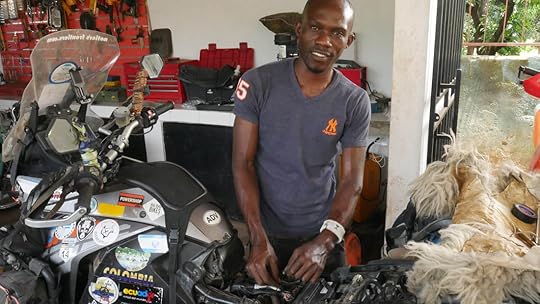 One of Sam's brilliant mechanics who is well-versed with the workings of big adventure motorcycles. Moshi, Tanzania.
[image error]
One of Sam's brilliant mechanics who is well-versed with the workings of big adventure motorcycles. Moshi, Tanzania.
[image error]
 After fixing the bike, we stayed a couple more weeks in Arusha at our favorite little hotel so that Tim could finalize his newest book and publish it. If you haven't already heard about it, it's called 2Up and Overloaded and is a hilarious and beautifully written account of our trip from out home in Chicago down through every country in Central America. The book launch was a huge success, and every day we get people writing to us saying how much they've enjoyed it, which I can't even express how much that has touched us.
After fixing the bike, we stayed a couple more weeks in Arusha at our favorite little hotel so that Tim could finalize his newest book and publish it. If you haven't already heard about it, it's called 2Up and Overloaded and is a hilarious and beautifully written account of our trip from out home in Chicago down through every country in Central America. The book launch was a huge success, and every day we get people writing to us saying how much they've enjoyed it, which I can't even express how much that has touched us.
We eventually had to leave the “good" internet of Arusha. Ok, it was good for African standards which means that there was internet 60% of the time. The other 40% was when the electricity went out, or they hadn't charged up their plan, or the boss was out of town and forgot to, or - and imagine this - because it was raining! But we finished what we needed to do online, and headed off to have one last adventure in Tanzania before entering Rwanda.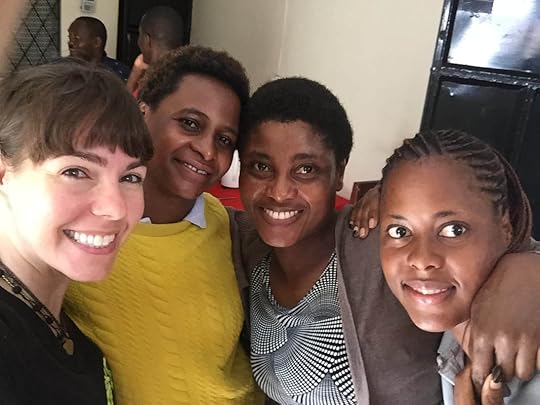 We stayed so long in Arusha, the hotel employees became like family. It was hard saying goodbye.Simon once again had a good road in mind for us to travel on, and unlike all his other difficult-but-rewarding suggestions, this one was paved. We were to travel along the western edge of Lake Victoria before dipping back down to get to the Rwandan border.And it was just as Simon had described: a perfectly tarred road hugging the green cliffs that overlooked Lake Victoria like a stunning blue expanse of sea speckled in islands. The islands appeared like the humps of whales cresting out of the water, and at a remote cliffside picnic spot, we could hear children below laughing as they splashed in the refreshing water. The weather was perfect, the wind coming off the lake was pleasant and quiet like a whisper, and the twitter of birds flying through the soft pine tree branches filled the place with a meditative music.
We stayed so long in Arusha, the hotel employees became like family. It was hard saying goodbye.Simon once again had a good road in mind for us to travel on, and unlike all his other difficult-but-rewarding suggestions, this one was paved. We were to travel along the western edge of Lake Victoria before dipping back down to get to the Rwandan border.And it was just as Simon had described: a perfectly tarred road hugging the green cliffs that overlooked Lake Victoria like a stunning blue expanse of sea speckled in islands. The islands appeared like the humps of whales cresting out of the water, and at a remote cliffside picnic spot, we could hear children below laughing as they splashed in the refreshing water. The weather was perfect, the wind coming off the lake was pleasant and quiet like a whisper, and the twitter of birds flying through the soft pine tree branches filled the place with a meditative music.
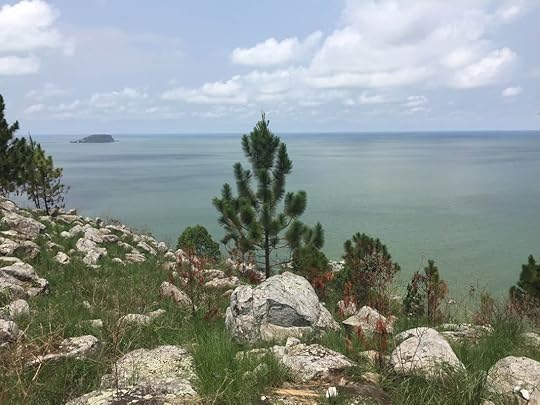 Beautiful Lake Victoria from a cliff near Bukoba, Tanzania.This was one of my favorite spots that we've come across in all of Africa.
Beautiful Lake Victoria from a cliff near Bukoba, Tanzania.This was one of my favorite spots that we've come across in all of Africa.
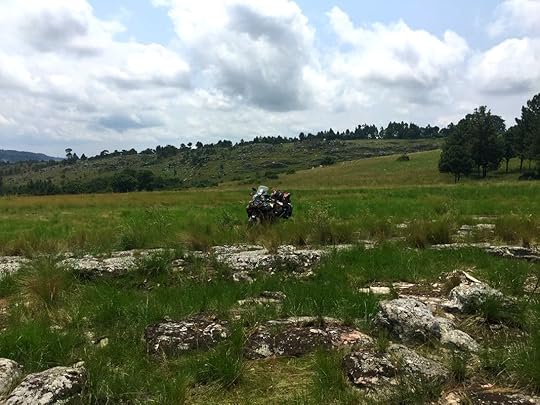 The bike looked to be at peace within the wild fields surrounding Lake Victoria.The next day's plan was to get from Lake Victoria to the Rwandan border, and we thought that would be easy. But the road we had decided on was made of red clay, which isn't bad by itself, but considering the daily rains, can turn into a slippery slush pit very quickly.
The bike looked to be at peace within the wild fields surrounding Lake Victoria.The next day's plan was to get from Lake Victoria to the Rwandan border, and we thought that would be easy. But the road we had decided on was made of red clay, which isn't bad by itself, but considering the daily rains, can turn into a slippery slush pit very quickly.
We spent hours on this road praying for the skies to stay clear, but the clouds just became thicker and thicker. Until finally the wrath of the weather gods came plummeting down on us and we were mired in some serious mud.
Luckily we were close to our destination, but when we pulled into the town of Nyakasanza, thunder was still roiling above us, garbage and tree branches were floating down the street in rivers, and everyone in the town was hiding under any shelter they could find. There wasn't even anyone at the hotel that we had pulled into, and we had to wait another half hour standing under the bucketing rain before someone showed up.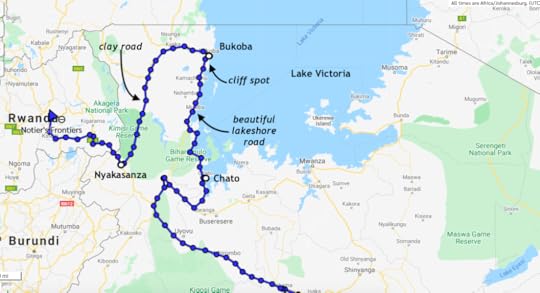 At last, we were shown a room where we lugged all our dripping belongings and tried our best to lay our clothes in places where they could dry. It's times like these that I start to think that being at home would be better than being on a motorcycle traveling the world. But then of course, something amazing always happens.
At last, we were shown a room where we lugged all our dripping belongings and tried our best to lay our clothes in places where they could dry. It's times like these that I start to think that being at home would be better than being on a motorcycle traveling the world. But then of course, something amazing always happens.
The sun had just set when we heard a knock on our hotel room door and someone in an American accent said, “Tim?" We opened the door to find Leo, a Cuban/American motorcycle friend who we had met back in Namibia, standing there with a big smile on his face saying, “I pulled in, saw your bike, and asked the guy at the front which room the motorcycle people were staying in."
We were so delighted to see him, we could barely contain ourselves. Tim, Leo, me, and our bikes.Leo had been through some serious adventures in Africa, the type of which I'm glad we have not encountered. He broke his ankle, then once it healed well enough to get on the bike again, he lost his top case in Zimbabwe which had his carnet, passport, phone, computer, even sentimental items... the list is horrific. He spent months away from his bike on a temporary passport trying to get some of his life back together so that he could continue his journey. Finally he was able to obtain new versions of enough items to get him to Tanzania, and as fate would have it, to our very same hotel!Saying goodbye to all the good people we met in Tanzania was difficult, but we're very thankful to now be traveling with a familiar face. The three of us have decided to cross into Rwanda together and explore some of this fascinating country as a team, which I will tell you all about in my next blog post.
Tim, Leo, me, and our bikes.Leo had been through some serious adventures in Africa, the type of which I'm glad we have not encountered. He broke his ankle, then once it healed well enough to get on the bike again, he lost his top case in Zimbabwe which had his carnet, passport, phone, computer, even sentimental items... the list is horrific. He spent months away from his bike on a temporary passport trying to get some of his life back together so that he could continue his journey. Finally he was able to obtain new versions of enough items to get him to Tanzania, and as fate would have it, to our very same hotel!Saying goodbye to all the good people we met in Tanzania was difficult, but we're very thankful to now be traveling with a familiar face. The three of us have decided to cross into Rwanda together and explore some of this fascinating country as a team, which I will tell you all about in my next blog post.
So stay tuned...Subscribe to the Blog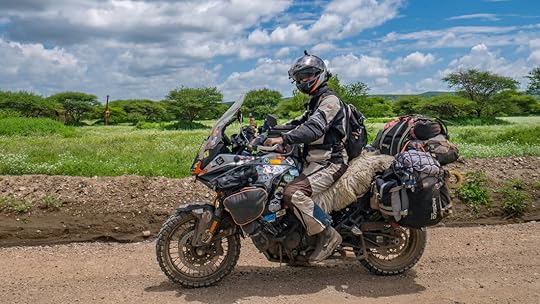 See the giraffe? We'll miss you Tanzania!
See the giraffe? We'll miss you Tanzania!
 Our time traveling through Tanzania was a bit different than what most tourists do. Due to costs, we didn't go on any safaris and we didn't hike up Mount Kilimanjaro or snorkel around Zanzibar. But what we did see and do in Tanzania was truly memorable, unique, and special, not because of lions and elephants, but because of the people we met along the way.
Our time traveling through Tanzania was a bit different than what most tourists do. Due to costs, we didn't go on any safaris and we didn't hike up Mount Kilimanjaro or snorkel around Zanzibar. But what we did see and do in Tanzania was truly memorable, unique, and special, not because of lions and elephants, but because of the people we met along the way.
 Simon and Tim in Arusha, Tanzania.It started with Simon in Arusha who gave us advice on some incredible roads that we took in the north and east of Tanzania. Along these roads, we got to meet the nomadic Maasai people, test our skills on a treacherous mountain pass into the clouds, and finally we camped on the beach listening to the waves crash along the warm coast of the Indian Ocean.
Simon and Tim in Arusha, Tanzania.It started with Simon in Arusha who gave us advice on some incredible roads that we took in the north and east of Tanzania. Along these roads, we got to meet the nomadic Maasai people, test our skills on a treacherous mountain pass into the clouds, and finally we camped on the beach listening to the waves crash along the warm coast of the Indian Ocean.But throughout these adventures, we noticed that the bike kept dying randomly. This problem first started in Malawi, but it had seemed to go away until it reared its ugly head again in northern Tanzania. It was an electrical problem, that we knew. Somewhere there was a short happening that was causing the bike to suddenly shut off out of nowhere. But finding that electrical short amidst the tangle of wires that makes up our KTM 1190 was a truly daunting task.
 Of course, the bike always seemed to die whenever we found ourselves in the middle of nowhere.And then we were told about Sam in Moshi, Tanzania. No, there aren't any KTM dealerships in Tanzania, but Sam was the closest thing to one that we were going to find.
Of course, the bike always seemed to die whenever we found ourselves in the middle of nowhere.And then we were told about Sam in Moshi, Tanzania. No, there aren't any KTM dealerships in Tanzania, but Sam was the closest thing to one that we were going to find.His real name is Samatarxavier (coolest name ever!) and he owns agarage in Moshi that repairs vehicles as well as gives motorcycle tours of the incredible surrounding area and wildlife parks. And I think he was sent from heaven because in less than 15 minutes he had diagnosed and fixed this motorcycle problem that had been plaguing us for more than a month! Like we'd suspected, it was a wire that was sometimes bumping into the chassis of the bike and shorting out the system. Sam was certainly a godsent, and we are so grateful for him and his team.
 One of Sam's brilliant mechanics who is well-versed with the workings of big adventure motorcycles. Moshi, Tanzania.
[image error]
One of Sam's brilliant mechanics who is well-versed with the workings of big adventure motorcycles. Moshi, Tanzania.
[image error]
 After fixing the bike, we stayed a couple more weeks in Arusha at our favorite little hotel so that Tim could finalize his newest book and publish it. If you haven't already heard about it, it's called 2Up and Overloaded and is a hilarious and beautifully written account of our trip from out home in Chicago down through every country in Central America. The book launch was a huge success, and every day we get people writing to us saying how much they've enjoyed it, which I can't even express how much that has touched us.
After fixing the bike, we stayed a couple more weeks in Arusha at our favorite little hotel so that Tim could finalize his newest book and publish it. If you haven't already heard about it, it's called 2Up and Overloaded and is a hilarious and beautifully written account of our trip from out home in Chicago down through every country in Central America. The book launch was a huge success, and every day we get people writing to us saying how much they've enjoyed it, which I can't even express how much that has touched us.We eventually had to leave the “good" internet of Arusha. Ok, it was good for African standards which means that there was internet 60% of the time. The other 40% was when the electricity went out, or they hadn't charged up their plan, or the boss was out of town and forgot to, or - and imagine this - because it was raining! But we finished what we needed to do online, and headed off to have one last adventure in Tanzania before entering Rwanda.
 We stayed so long in Arusha, the hotel employees became like family. It was hard saying goodbye.Simon once again had a good road in mind for us to travel on, and unlike all his other difficult-but-rewarding suggestions, this one was paved. We were to travel along the western edge of Lake Victoria before dipping back down to get to the Rwandan border.And it was just as Simon had described: a perfectly tarred road hugging the green cliffs that overlooked Lake Victoria like a stunning blue expanse of sea speckled in islands. The islands appeared like the humps of whales cresting out of the water, and at a remote cliffside picnic spot, we could hear children below laughing as they splashed in the refreshing water. The weather was perfect, the wind coming off the lake was pleasant and quiet like a whisper, and the twitter of birds flying through the soft pine tree branches filled the place with a meditative music.
We stayed so long in Arusha, the hotel employees became like family. It was hard saying goodbye.Simon once again had a good road in mind for us to travel on, and unlike all his other difficult-but-rewarding suggestions, this one was paved. We were to travel along the western edge of Lake Victoria before dipping back down to get to the Rwandan border.And it was just as Simon had described: a perfectly tarred road hugging the green cliffs that overlooked Lake Victoria like a stunning blue expanse of sea speckled in islands. The islands appeared like the humps of whales cresting out of the water, and at a remote cliffside picnic spot, we could hear children below laughing as they splashed in the refreshing water. The weather was perfect, the wind coming off the lake was pleasant and quiet like a whisper, and the twitter of birds flying through the soft pine tree branches filled the place with a meditative music.
 Beautiful Lake Victoria from a cliff near Bukoba, Tanzania.This was one of my favorite spots that we've come across in all of Africa.
Beautiful Lake Victoria from a cliff near Bukoba, Tanzania.This was one of my favorite spots that we've come across in all of Africa.
 The bike looked to be at peace within the wild fields surrounding Lake Victoria.The next day's plan was to get from Lake Victoria to the Rwandan border, and we thought that would be easy. But the road we had decided on was made of red clay, which isn't bad by itself, but considering the daily rains, can turn into a slippery slush pit very quickly.
The bike looked to be at peace within the wild fields surrounding Lake Victoria.The next day's plan was to get from Lake Victoria to the Rwandan border, and we thought that would be easy. But the road we had decided on was made of red clay, which isn't bad by itself, but considering the daily rains, can turn into a slippery slush pit very quickly.We spent hours on this road praying for the skies to stay clear, but the clouds just became thicker and thicker. Until finally the wrath of the weather gods came plummeting down on us and we were mired in some serious mud.
Luckily we were close to our destination, but when we pulled into the town of Nyakasanza, thunder was still roiling above us, garbage and tree branches were floating down the street in rivers, and everyone in the town was hiding under any shelter they could find. There wasn't even anyone at the hotel that we had pulled into, and we had to wait another half hour standing under the bucketing rain before someone showed up.
 At last, we were shown a room where we lugged all our dripping belongings and tried our best to lay our clothes in places where they could dry. It's times like these that I start to think that being at home would be better than being on a motorcycle traveling the world. But then of course, something amazing always happens.
At last, we were shown a room where we lugged all our dripping belongings and tried our best to lay our clothes in places where they could dry. It's times like these that I start to think that being at home would be better than being on a motorcycle traveling the world. But then of course, something amazing always happens.The sun had just set when we heard a knock on our hotel room door and someone in an American accent said, “Tim?" We opened the door to find Leo, a Cuban/American motorcycle friend who we had met back in Namibia, standing there with a big smile on his face saying, “I pulled in, saw your bike, and asked the guy at the front which room the motorcycle people were staying in."
We were so delighted to see him, we could barely contain ourselves.
 Tim, Leo, me, and our bikes.Leo had been through some serious adventures in Africa, the type of which I'm glad we have not encountered. He broke his ankle, then once it healed well enough to get on the bike again, he lost his top case in Zimbabwe which had his carnet, passport, phone, computer, even sentimental items... the list is horrific. He spent months away from his bike on a temporary passport trying to get some of his life back together so that he could continue his journey. Finally he was able to obtain new versions of enough items to get him to Tanzania, and as fate would have it, to our very same hotel!Saying goodbye to all the good people we met in Tanzania was difficult, but we're very thankful to now be traveling with a familiar face. The three of us have decided to cross into Rwanda together and explore some of this fascinating country as a team, which I will tell you all about in my next blog post.
Tim, Leo, me, and our bikes.Leo had been through some serious adventures in Africa, the type of which I'm glad we have not encountered. He broke his ankle, then once it healed well enough to get on the bike again, he lost his top case in Zimbabwe which had his carnet, passport, phone, computer, even sentimental items... the list is horrific. He spent months away from his bike on a temporary passport trying to get some of his life back together so that he could continue his journey. Finally he was able to obtain new versions of enough items to get him to Tanzania, and as fate would have it, to our very same hotel!Saying goodbye to all the good people we met in Tanzania was difficult, but we're very thankful to now be traveling with a familiar face. The three of us have decided to cross into Rwanda together and explore some of this fascinating country as a team, which I will tell you all about in my next blog post.So stay tuned...Subscribe to the Blog
 See the giraffe? We'll miss you Tanzania!
See the giraffe? We'll miss you Tanzania!
Published on March 06, 2020 03:37
February 21, 2020
2Up and Overloaded - Chicago to Panama
A New Adventure Motorcycle Book By: Tim Notier 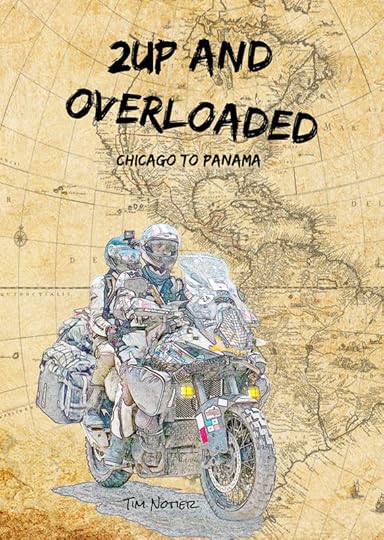 If you only read one book this year that features a couple riding 2Up on a KTM1190, make sure it's 2Up and Overloaded - Chicago to Panama. I wrote 2Up and Overloaded while on three different continents, throughout South America, back home in Chicago, and then finished the book in Tanzania. My mind and my body were constantly separated by thousands of miles.
If you only read one book this year that features a couple riding 2Up on a KTM1190, make sure it's 2Up and Overloaded - Chicago to Panama. I wrote 2Up and Overloaded while on three different continents, throughout South America, back home in Chicago, and then finished the book in Tanzania. My mind and my body were constantly separated by thousands of miles. 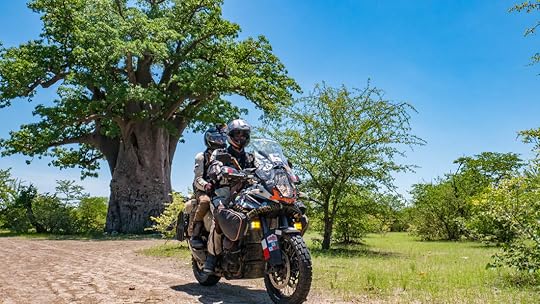 This is a good cover picture of us.. but it's in Botswana... Not North or Central America The cover's concept art to the final image was a journey of its own. From finding reliable internet, staying in one place long enough to edit the multiple pictures I spliced together, to making sure my computer didn't melt in the relentless African heat. Once everything was almost completed, we found a temporary home in Arusha, Tanzania to piece together all of the final touches.
This is a good cover picture of us.. but it's in Botswana... Not North or Central America The cover's concept art to the final image was a journey of its own. From finding reliable internet, staying in one place long enough to edit the multiple pictures I spliced together, to making sure my computer didn't melt in the relentless African heat. Once everything was almost completed, we found a temporary home in Arusha, Tanzania to piece together all of the final touches. 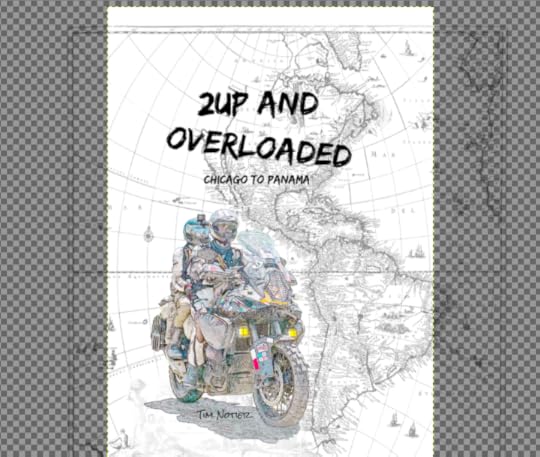 I Photoshoped out the Baobab tree... but this isn't a good representation of us "Overloaded" I had a lot of help with the editing of my book from my father, who was a high school honors English teacher (a class that I would have failed miserably), then to a professional editor (and one that I wasn't related to), and finally Marisa looked it over one last time before I nervously pressed publish on Amazon.
I Photoshoped out the Baobab tree... but this isn't a good representation of us "Overloaded" I had a lot of help with the editing of my book from my father, who was a high school honors English teacher (a class that I would have failed miserably), then to a professional editor (and one that I wasn't related to), and finally Marisa looked it over one last time before I nervously pressed publish on Amazon. 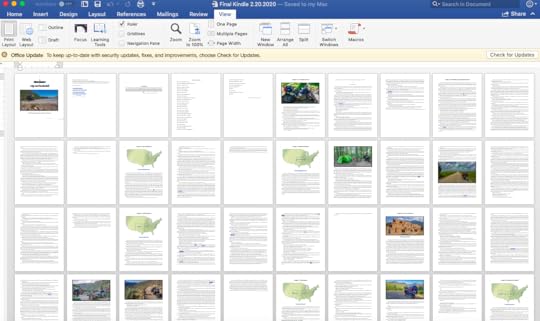 It has been a fun project, and I hope it can shed some light on our travels, bring a smile to your face, make you laugh out loud at times, and let you get to know who Marisa and I are on a more personal level than social media and our short blogs allow.
It has been a fun project, and I hope it can shed some light on our travels, bring a smile to your face, make you laugh out loud at times, and let you get to know who Marisa and I are on a more personal level than social media and our short blogs allow.
There are over 92 thousand words that will hopefully inspire you. Over 200 pages that detail our hardships, our successes, the mostly good times, as well as some insight into some of the bad.
I hope you are able to relive our experiences and be part of our journey. We have met many of you who are reading this post, and far more have made positive comments of encouragement on our blogs, Facebook and Instagram. We can't thank you enough for being an emotional support vehicle in some of the tougher times.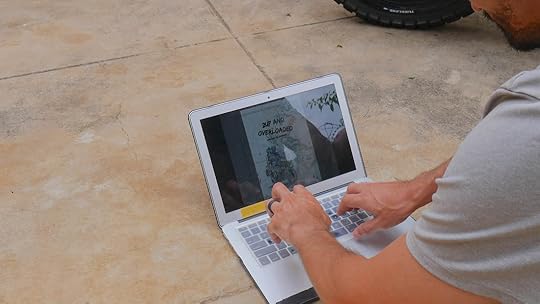 Back cover blurb:
Back cover blurb:
Maiden Voyage: The Prequel to The Adventure of a Lifetime introduced the characters, 2Up and Overloaded sets them free into the world. Join Tim and his fiancée Marisa as they take a leap of faith and quit their jobs to circumnavigate the globe on their KTM 1190 Adventure motorcycle.
You'll feel the wind in your hair as they make their way across the United States, and head south through Mexico and Central America. You’ll be holding your breath as you ride along with them behind smog-extruding trucks in Tijuana, shouting at intrusive bears in the backcountry of Colorado, and pondering how to repair a bike that lies exhausted on the side of a deserted road.
2Up and Overloaded is an inspiring, witty, sometimes-harrowing, and always gripping story, in which two people prepare extensively to explore the world on their motorcycle, only to discover that their most powerful resource can’t be packed in a bag. Available in both Paperback and Kindle: Paperback Kindle Edition Take a look at the trailer below I made for 2Up and Overloaded!
 If you only read one book this year that features a couple riding 2Up on a KTM1190, make sure it's 2Up and Overloaded - Chicago to Panama. I wrote 2Up and Overloaded while on three different continents, throughout South America, back home in Chicago, and then finished the book in Tanzania. My mind and my body were constantly separated by thousands of miles.
If you only read one book this year that features a couple riding 2Up on a KTM1190, make sure it's 2Up and Overloaded - Chicago to Panama. I wrote 2Up and Overloaded while on three different continents, throughout South America, back home in Chicago, and then finished the book in Tanzania. My mind and my body were constantly separated by thousands of miles.  This is a good cover picture of us.. but it's in Botswana... Not North or Central America The cover's concept art to the final image was a journey of its own. From finding reliable internet, staying in one place long enough to edit the multiple pictures I spliced together, to making sure my computer didn't melt in the relentless African heat. Once everything was almost completed, we found a temporary home in Arusha, Tanzania to piece together all of the final touches.
This is a good cover picture of us.. but it's in Botswana... Not North or Central America The cover's concept art to the final image was a journey of its own. From finding reliable internet, staying in one place long enough to edit the multiple pictures I spliced together, to making sure my computer didn't melt in the relentless African heat. Once everything was almost completed, we found a temporary home in Arusha, Tanzania to piece together all of the final touches.  I Photoshoped out the Baobab tree... but this isn't a good representation of us "Overloaded" I had a lot of help with the editing of my book from my father, who was a high school honors English teacher (a class that I would have failed miserably), then to a professional editor (and one that I wasn't related to), and finally Marisa looked it over one last time before I nervously pressed publish on Amazon.
I Photoshoped out the Baobab tree... but this isn't a good representation of us "Overloaded" I had a lot of help with the editing of my book from my father, who was a high school honors English teacher (a class that I would have failed miserably), then to a professional editor (and one that I wasn't related to), and finally Marisa looked it over one last time before I nervously pressed publish on Amazon.  It has been a fun project, and I hope it can shed some light on our travels, bring a smile to your face, make you laugh out loud at times, and let you get to know who Marisa and I are on a more personal level than social media and our short blogs allow.
It has been a fun project, and I hope it can shed some light on our travels, bring a smile to your face, make you laugh out loud at times, and let you get to know who Marisa and I are on a more personal level than social media and our short blogs allow.There are over 92 thousand words that will hopefully inspire you. Over 200 pages that detail our hardships, our successes, the mostly good times, as well as some insight into some of the bad.
I hope you are able to relive our experiences and be part of our journey. We have met many of you who are reading this post, and far more have made positive comments of encouragement on our blogs, Facebook and Instagram. We can't thank you enough for being an emotional support vehicle in some of the tougher times.
 Back cover blurb:
Back cover blurb: Maiden Voyage: The Prequel to The Adventure of a Lifetime introduced the characters, 2Up and Overloaded sets them free into the world. Join Tim and his fiancée Marisa as they take a leap of faith and quit their jobs to circumnavigate the globe on their KTM 1190 Adventure motorcycle.
You'll feel the wind in your hair as they make their way across the United States, and head south through Mexico and Central America. You’ll be holding your breath as you ride along with them behind smog-extruding trucks in Tijuana, shouting at intrusive bears in the backcountry of Colorado, and pondering how to repair a bike that lies exhausted on the side of a deserted road.
2Up and Overloaded is an inspiring, witty, sometimes-harrowing, and always gripping story, in which two people prepare extensively to explore the world on their motorcycle, only to discover that their most powerful resource can’t be packed in a bag. Available in both Paperback and Kindle: Paperback Kindle Edition Take a look at the trailer below I made for 2Up and Overloaded!
Published on February 21, 2020 03:17
February 16, 2020
Tough Roads in Tanzania
By Marisa 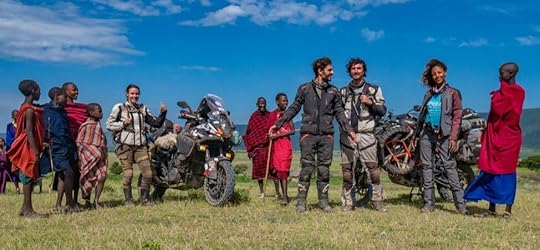 “Africa is surprisingly expensive," we'd heard time and time again from fellow travelers. But so far during our Africa trip, we had been able to find cheap food, accommodation, and camping. We even rented a 4x4 car in Namibia for a decent price and went on a “self-drive" safari in Etosha National Park for only $6 a person to enter. While some people were spending thousands of dollars on safaris in Africa, we'd spent a fraction of that, and I'd begun to think that everyone had been wrong.
“Africa is surprisingly expensive," we'd heard time and time again from fellow travelers. But so far during our Africa trip, we had been able to find cheap food, accommodation, and camping. We even rented a 4x4 car in Namibia for a decent price and went on a “self-drive" safari in Etosha National Park for only $6 a person to enter. While some people were spending thousands of dollars on safaris in Africa, we'd spent a fraction of that, and I'd begun to think that everyone had been wrong.
And then we got to Tanzania.
The visa for Americans to enter this country is $100 a person. Alright, that a bit steep, but it's more-or-less the norm for Eastern African countries. But then there are the park fees. If you want to enter one of Tanzania's famous safari parks such as Serengeti National Park or Ngorongoro Crater, then you'll have to pay $80 a person for a 24 hour period, you'll be charged for your vehicle or your guide, you'll most likely have to camp and will have to pay for that... the list of fees goes on and on.
In the end, most people pay about $400 to $500 a person just to enter a Tanzanian National Park per day! Whoa! And I'm not even going to talk about the thousands of dollars it costs to climb Mount Kilimanjaro.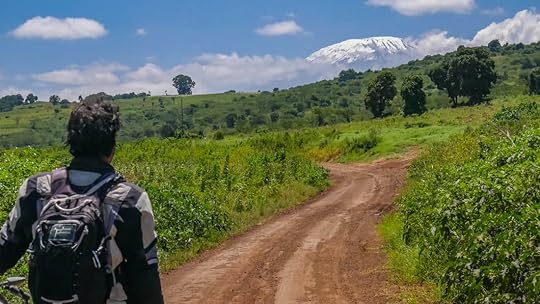 We saved $4,000 or so by simply seeing Kilimanjaro from the road without climbing it. After having been so excited to come to Tanzania, once we got here and the reality of the costs hit us, I was worried this country was going to be a bust. Besides the fact that motorcycles aren't allowed in the parks, I had hoped we could at least join a game drive or tour or something... but alas, these things were all out of our budget.
We saved $4,000 or so by simply seeing Kilimanjaro from the road without climbing it. After having been so excited to come to Tanzania, once we got here and the reality of the costs hit us, I was worried this country was going to be a bust. Besides the fact that motorcycles aren't allowed in the parks, I had hoped we could at least join a game drive or tour or something... but alas, these things were all out of our budget.
But it turns out that there is something that Tanzania can offer the adventure motorcyclist that is free, if you're willing to do it: tough but scenic roads. And what I mean by tough roads is that Tanzania is an off-roader's heaven of difficulty, beauty, and unique cultural experiences. Three wild asses. We entered Tanzania from the south, and as we left Lake Malawi in the distance, the scenery surrounded us with green mountains rippling off into blues and purples as far as the eye could see. Swahili could be heard everywhere, the people smiled and welcomed us from every store and stall by saying “Karibu", and we happily settled in to a cheap hotel called Warsame Guesthouse (I'm talking $7 a night) in Mbeya (by the way, we're not paid by any of hotels and accommodations I've put in this blog. I simply linked the places because I liked them.) The internet there worked, the family who owned it was friendly, and as the summer rains drummed on the roof, we decided to relax and get some computer work done. We ended up staying for two weeks.
Three wild asses. We entered Tanzania from the south, and as we left Lake Malawi in the distance, the scenery surrounded us with green mountains rippling off into blues and purples as far as the eye could see. Swahili could be heard everywhere, the people smiled and welcomed us from every store and stall by saying “Karibu", and we happily settled in to a cheap hotel called Warsame Guesthouse (I'm talking $7 a night) in Mbeya (by the way, we're not paid by any of hotels and accommodations I've put in this blog. I simply linked the places because I liked them.) The internet there worked, the family who owned it was friendly, and as the summer rains drummed on the roof, we decided to relax and get some computer work done. We ended up staying for two weeks. 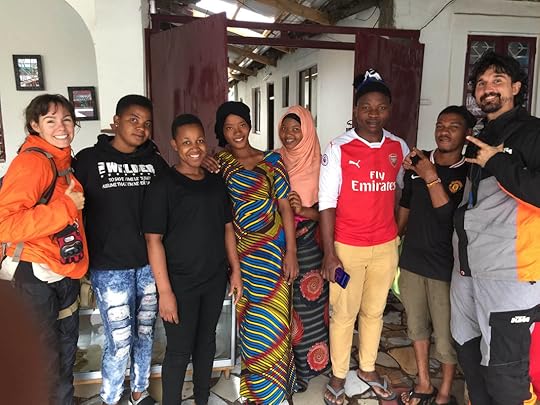 Our new "family" at Warsame Guesthouse in Mbeya, Tanzania. I noticed that compared to Zambia and Malawi, there seemed to be more industry going on in Tanzania. There were cobblers (I fixed my boot zippers!), mechanics, bakeries, and book stores. Little 250cc motorcycles zoomed around and they were loaded with everything you could think of: furniture, goats, baskets full of chickens, and of course, grandma, mama, and her baby all piled on the back.
Our new "family" at Warsame Guesthouse in Mbeya, Tanzania. I noticed that compared to Zambia and Malawi, there seemed to be more industry going on in Tanzania. There were cobblers (I fixed my boot zippers!), mechanics, bakeries, and book stores. Little 250cc motorcycles zoomed around and they were loaded with everything you could think of: furniture, goats, baskets full of chickens, and of course, grandma, mama, and her baby all piled on the back.  And you thought we were overloaded! Feeling refreshed from Mbeya, we headed north through the center of Tanzania along the main highway. Since all the parks along the way didn't allow motorcycles, and were too expensive to visit anyway, we reluctantly passed them by. We went straight to the tourist town of Arusha because we had some repairs to make on the bike and had heard of a few knowledgable motorcycle enthusiasts living there.
And you thought we were overloaded! Feeling refreshed from Mbeya, we headed north through the center of Tanzania along the main highway. Since all the parks along the way didn't allow motorcycles, and were too expensive to visit anyway, we reluctantly passed them by. We went straight to the tourist town of Arusha because we had some repairs to make on the bike and had heard of a few knowledgable motorcycle enthusiasts living there. 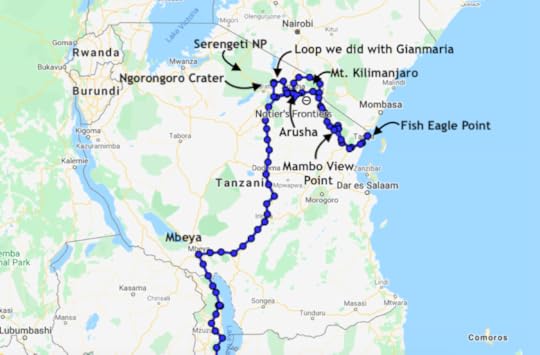
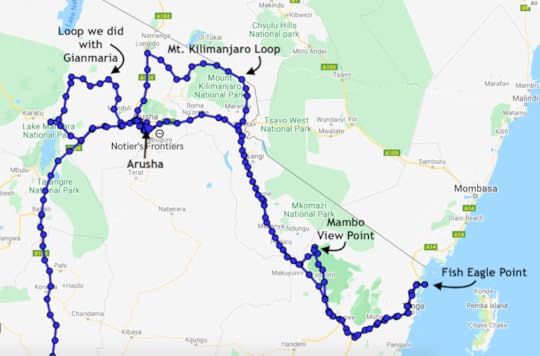 But along the way we had a surprise. Meeting other motorcycle travelers in Africa has been a rare occurrence. But as we were stopped at one of Tanzania's many speed traps, we pulled over to find ourselves next to an Italian couple traveling on a KTM 1290 Super Adventure! Two-up, just like us, also with Mosko Moto soft luggage, and on practically the same bike (ours is the 1190), we just couldn't believe it!
But along the way we had a surprise. Meeting other motorcycle travelers in Africa has been a rare occurrence. But as we were stopped at one of Tanzania's many speed traps, we pulled over to find ourselves next to an Italian couple traveling on a KTM 1290 Super Adventure! Two-up, just like us, also with Mosko Moto soft luggage, and on practically the same bike (ours is the 1190), we just couldn't believe it!
After talking our way out of a speeding ticket, we all stopped at a roadside restaurant to have some lunch together. Gianmaria Colangeli and his girlfriend Lucia were headed through Africa in the same direction as us, but because he had to get back to Italy in the spring to run his hotel and motorcycle tour business (Macedonia Adventures), they would be going much faster.
Still, though we had to momentarily split ways as they headed to Zanzibar, we all planned on meeting again sometime soon. And after a week or so, this great reunion in Arusha turned into one of the best adventures we've had in Africa! KTM brothers! (and sisters!) First we met up with an adventure motorcycle friend in Arusha named Simon who owns a beautiful lodge there called The Outpost. In Arusha we got some repairs done, an oil change, and Simon gave us great advice on roads to take. Then when Gianmaria and Lucia arrived, we headed off into the wilds of northern Tanzania.
KTM brothers! (and sisters!) First we met up with an adventure motorcycle friend in Arusha named Simon who owns a beautiful lodge there called The Outpost. In Arusha we got some repairs done, an oil change, and Simon gave us great advice on roads to take. Then when Gianmaria and Lucia arrived, we headed off into the wilds of northern Tanzania.
These two days of riding down rough roads turned out to be exactly what I was looking for out of Tanzania. No, we didn't see lions (actually, that's probably a good thing considering they like to chase motorcycles), but we did see giraffes, zebra, ostriches, and a very big strange bird called the kori bustard, which is considered to be the heaviest living animal capable of flight.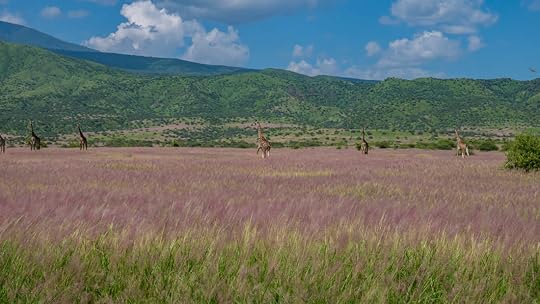 The rains of December and January had stopped, filling the landscape with lush fields of grasses and some very happy animals. But what really made this journey special was that the road was so bad and washed out in sections by rivers and small canyons, we had to work as a team to get through these challenges. And I have to say we made a great team.
The rains of December and January had stopped, filling the landscape with lush fields of grasses and some very happy animals. But what really made this journey special was that the road was so bad and washed out in sections by rivers and small canyons, we had to work as a team to get through these challenges. And I have to say we made a great team. 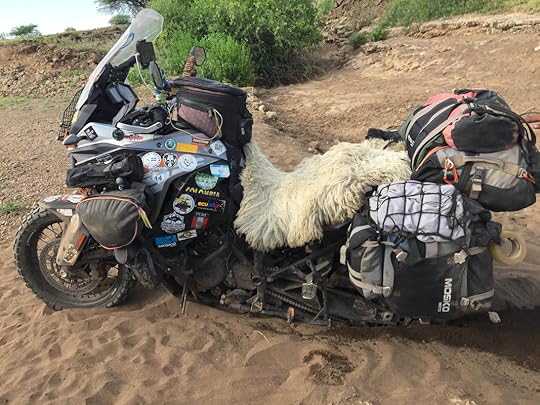 Yup, we got very buried in the sand. But nothing the four of us couldn't get out of. We all fell many times: they slipped out from a muddy section once or twice, we slid down a hill when Tim accidentally had the bike in neutral, just to name a few. But overall, these guys were champs at getting across all these washouts, sand traps, river crossings, and steep mud hills. I couldn't be more proud of Tim.
Yup, we got very buried in the sand. But nothing the four of us couldn't get out of. We all fell many times: they slipped out from a muddy section once or twice, we slid down a hill when Tim accidentally had the bike in neutral, just to name a few. But overall, these guys were champs at getting across all these washouts, sand traps, river crossings, and steep mud hills. I couldn't be more proud of Tim. 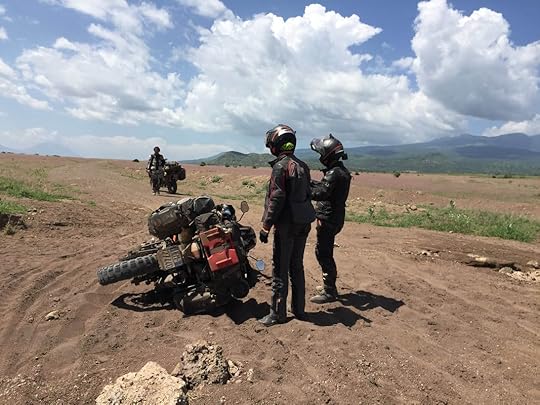 We all fall sometimes.
We all fall sometimes. 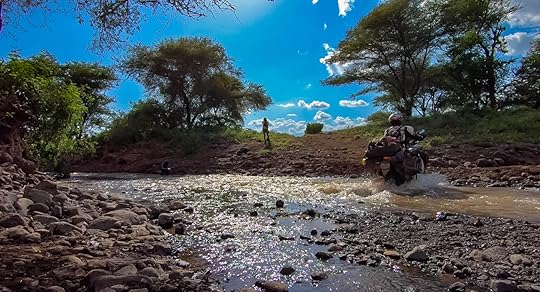 Tim raging through a river. But the coolest part was the Maasai people who we met. These indigenous pastoralists of northern Tanzania are tall, lean, and majestically beautiful in their red and purple checkered clothing which they drape over their shoulders. The women have bald heads and wear beaded bands on their arms along with shiny metal earrings which stretch out their earlobes. The men also have elongated earlobes and sometimes “tattoo" their faces with burn marks.
Tim raging through a river. But the coolest part was the Maasai people who we met. These indigenous pastoralists of northern Tanzania are tall, lean, and majestically beautiful in their red and purple checkered clothing which they drape over their shoulders. The women have bald heads and wear beaded bands on their arms along with shiny metal earrings which stretch out their earlobes. The men also have elongated earlobes and sometimes “tattoo" their faces with burn marks.
We could never speak each other's languages, but whenever we came to an impassable section of road, we'd ride through the tall grasses until we found a Maasai camp with cattle everywhere and warriors holding sticks and sometimes spears. They could figure out easily enough that we needed to get across the ravine that had formed from the recent rains, and they'd show us where they usually get their livestock across.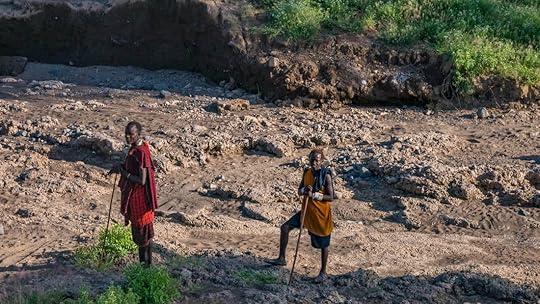 Two of the many Maasai we met, both wearing shoes made out of old tires. It was a truly incredible adventure, and it makes me proud just thinking back on the fact that we were so far out there in the Serengeti that there was no way any other vehicles could go along that road. The only other people out there were those who traveled by donkey or foot.
Two of the many Maasai we met, both wearing shoes made out of old tires. It was a truly incredible adventure, and it makes me proud just thinking back on the fact that we were so far out there in the Serengeti that there was no way any other vehicles could go along that road. The only other people out there were those who traveled by donkey or foot.
That night, we couldn't find a proper place to stay, so we wild camped in the bush. We cooked up some steaks which we'd been carrying, but unfortunately, due to all the falls of the day, the steak bag had burst and got raw meat juice all over Gianmaria's tent bag.
“Hopefully the smell doesn't attract lions," he said with a frown. I got out our pepper spray and kept our GPS emergency button close to me all night long, but luckily, we were only greeted by the locals in the morning who seemed to come out of the woodwork and shake our hands with warm smiles and stares of curiosity.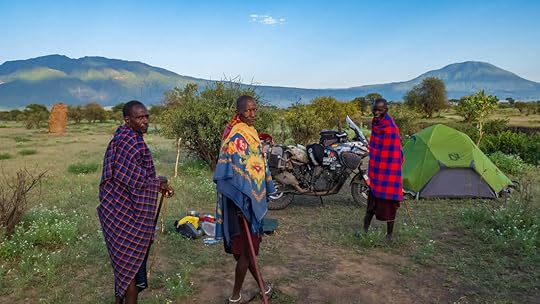 Our Maasai neighbors welcoming us onto their lands. Unfortunately, Gianmaria and Lucia had to keep on their schedule and head into Kenya that day. But Tim and I decided to do some more exploring of Tanzania's wonders. So we said our goodbyes and hopefully we'll all meet again one day, maybe in Italy.
Our Maasai neighbors welcoming us onto their lands. Unfortunately, Gianmaria and Lucia had to keep on their schedule and head into Kenya that day. But Tim and I decided to do some more exploring of Tanzania's wonders. So we said our goodbyes and hopefully we'll all meet again one day, maybe in Italy. 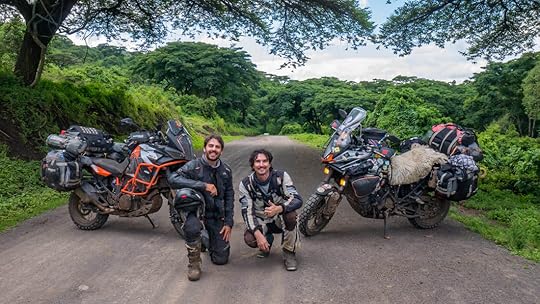 Gianmaria and Tim and their mighty KTM steeds. Next on our list was to ride around Mount Kilimanjaro, the tallest mountain of the African continent and the tallest free-standing mountain in the world. We waited for the morning mist to pass, and spent hours traversing a loop road around the peak. The views did not disappoint.
Gianmaria and Tim and their mighty KTM steeds. Next on our list was to ride around Mount Kilimanjaro, the tallest mountain of the African continent and the tallest free-standing mountain in the world. We waited for the morning mist to pass, and spent hours traversing a loop road around the peak. The views did not disappoint. 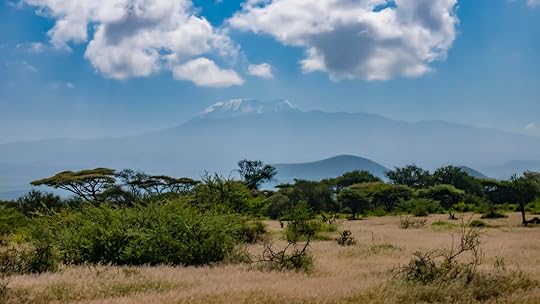 The great and wonderful Mount Kilimanjaro, Tanzania. At over 19,000ft (5,900m), it's no wonder there's always snow on it despite being located near the equator.
The great and wonderful Mount Kilimanjaro, Tanzania. At over 19,000ft (5,900m), it's no wonder there's always snow on it despite being located near the equator. 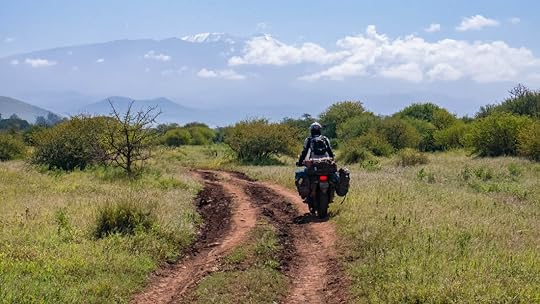 Sometimes we would think the snow on top was just clouds in the distance. Imagine how tall it was before the volcano blew its top off... After that we decided to tackle another one of Simon's road suggestions and do a particularly hard mountain pass up the West Usambaras Mountain Range to a hotel called Mambo View Point. After the difficultly of the first road Simon told us to do, I don't really know what we were thinking, especially now that we didn't have a pair of Italian superheroes to help us. And the first road didn't have cliff edges to deal with, which definitely upped the level of danger. One fall could mean the end of the trip!
Sometimes we would think the snow on top was just clouds in the distance. Imagine how tall it was before the volcano blew its top off... After that we decided to tackle another one of Simon's road suggestions and do a particularly hard mountain pass up the West Usambaras Mountain Range to a hotel called Mambo View Point. After the difficultly of the first road Simon told us to do, I don't really know what we were thinking, especially now that we didn't have a pair of Italian superheroes to help us. And the first road didn't have cliff edges to deal with, which definitely upped the level of danger. One fall could mean the end of the trip! 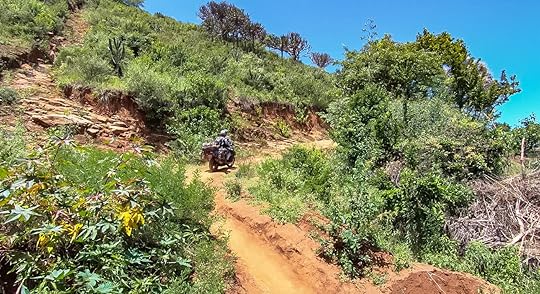 The difficulty of this road just does not come out well on film. In all honesty, I would not recommend this road to anyone unless they are on an unloaded dirt bike, and definitely not with a passenger. This was some seriously tricky stuff, especially due to the recent onslaught of rain, but once again, Tim was an absolute master! We arrived at the top of the pass at a whopping 6,000 ft above sea level (2,000 meters), stayed a lovely night at Mambo View Point, and felt quite accomplished with ourselves and happy to be alive.
The difficulty of this road just does not come out well on film. In all honesty, I would not recommend this road to anyone unless they are on an unloaded dirt bike, and definitely not with a passenger. This was some seriously tricky stuff, especially due to the recent onslaught of rain, but once again, Tim was an absolute master! We arrived at the top of the pass at a whopping 6,000 ft above sea level (2,000 meters), stayed a lovely night at Mambo View Point, and felt quite accomplished with ourselves and happy to be alive. 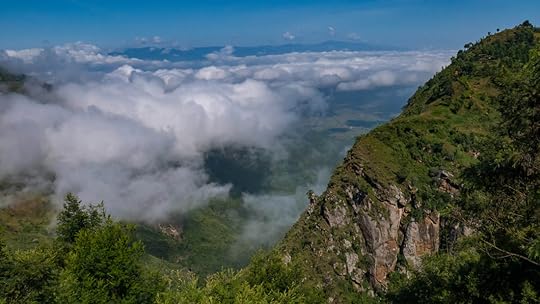 Yeah, I'd say the road up to Mambo View Point was worth it.
Yeah, I'd say the road up to Mambo View Point was worth it. 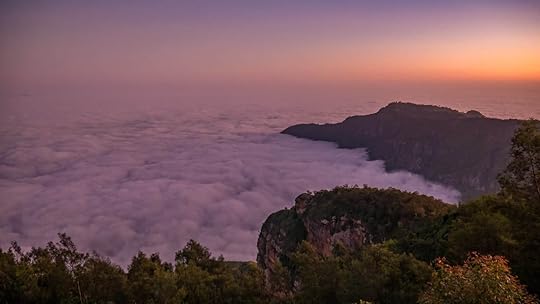 This was sunrise over a sea of clouds. And for our final escapade in Tanzania, we decided to take a break from the dirt and instead head to the beach. We'd earned it I think.
This was sunrise over a sea of clouds. And for our final escapade in Tanzania, we decided to take a break from the dirt and instead head to the beach. We'd earned it I think.
Tanzania is famous not just for the Lion King and the Serengeti, but also for its amazing coastline. Because we had skipped the island of Zanzibar, we thought we'd still try to get a glimpse of some beautiful turquoise waters by dipping into the sea near Tanga, at another place that Simon owns, Fish Eagle Point. Simply stunning. The water was like salty bath water, and just as clear. And because it was the off-season, it was our own private tropical paradise.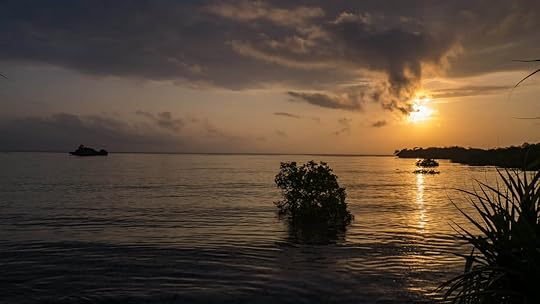 The gorgeous sunset from Fish Eagle Point, near Tanga, Tanzania. But unlike the mountains, the coast of Tanzania was hot. Sweltering is an understatement. So after a sticky night camping on the beach, we decided to cool off back in the mountains, and are now on our way west to Rwanda and Uganda (where we may actually see some lions while riding on the bike, ahhh!).
The gorgeous sunset from Fish Eagle Point, near Tanga, Tanzania. But unlike the mountains, the coast of Tanzania was hot. Sweltering is an understatement. So after a sticky night camping on the beach, we decided to cool off back in the mountains, and are now on our way west to Rwanda and Uganda (where we may actually see some lions while riding on the bike, ahhh!).
So stay tuned, and keep your eyes out for Tim's new book covering from when we left our home in Chicago and headed south through Central America. It's called Two-Up and Overloaded, and it's sure to be full of laughs and adventures. It will probably be launching within the next week! Contact Tim to Preorder Book Subscribe to Our Blog One last crazy tidbit: here in Tanzania they use something called Swahili time. Since sunrise and sunset are always the same time throughout the year, they've set their clocks so that the day starts at 6:00am, meaning that's 12:00 midnight. So to tell time in Swahili you have to take away 6 hours and switch am with pm. What??!!!!!
I still find this hard to believe that it's a real thing, but it is. Enjoy this random fact for the day...
 “Africa is surprisingly expensive," we'd heard time and time again from fellow travelers. But so far during our Africa trip, we had been able to find cheap food, accommodation, and camping. We even rented a 4x4 car in Namibia for a decent price and went on a “self-drive" safari in Etosha National Park for only $6 a person to enter. While some people were spending thousands of dollars on safaris in Africa, we'd spent a fraction of that, and I'd begun to think that everyone had been wrong.
“Africa is surprisingly expensive," we'd heard time and time again from fellow travelers. But so far during our Africa trip, we had been able to find cheap food, accommodation, and camping. We even rented a 4x4 car in Namibia for a decent price and went on a “self-drive" safari in Etosha National Park for only $6 a person to enter. While some people were spending thousands of dollars on safaris in Africa, we'd spent a fraction of that, and I'd begun to think that everyone had been wrong.And then we got to Tanzania.
The visa for Americans to enter this country is $100 a person. Alright, that a bit steep, but it's more-or-less the norm for Eastern African countries. But then there are the park fees. If you want to enter one of Tanzania's famous safari parks such as Serengeti National Park or Ngorongoro Crater, then you'll have to pay $80 a person for a 24 hour period, you'll be charged for your vehicle or your guide, you'll most likely have to camp and will have to pay for that... the list of fees goes on and on.
In the end, most people pay about $400 to $500 a person just to enter a Tanzanian National Park per day! Whoa! And I'm not even going to talk about the thousands of dollars it costs to climb Mount Kilimanjaro.
 We saved $4,000 or so by simply seeing Kilimanjaro from the road without climbing it. After having been so excited to come to Tanzania, once we got here and the reality of the costs hit us, I was worried this country was going to be a bust. Besides the fact that motorcycles aren't allowed in the parks, I had hoped we could at least join a game drive or tour or something... but alas, these things were all out of our budget.
We saved $4,000 or so by simply seeing Kilimanjaro from the road without climbing it. After having been so excited to come to Tanzania, once we got here and the reality of the costs hit us, I was worried this country was going to be a bust. Besides the fact that motorcycles aren't allowed in the parks, I had hoped we could at least join a game drive or tour or something... but alas, these things were all out of our budget.But it turns out that there is something that Tanzania can offer the adventure motorcyclist that is free, if you're willing to do it: tough but scenic roads. And what I mean by tough roads is that Tanzania is an off-roader's heaven of difficulty, beauty, and unique cultural experiences.
 Three wild asses. We entered Tanzania from the south, and as we left Lake Malawi in the distance, the scenery surrounded us with green mountains rippling off into blues and purples as far as the eye could see. Swahili could be heard everywhere, the people smiled and welcomed us from every store and stall by saying “Karibu", and we happily settled in to a cheap hotel called Warsame Guesthouse (I'm talking $7 a night) in Mbeya (by the way, we're not paid by any of hotels and accommodations I've put in this blog. I simply linked the places because I liked them.) The internet there worked, the family who owned it was friendly, and as the summer rains drummed on the roof, we decided to relax and get some computer work done. We ended up staying for two weeks.
Three wild asses. We entered Tanzania from the south, and as we left Lake Malawi in the distance, the scenery surrounded us with green mountains rippling off into blues and purples as far as the eye could see. Swahili could be heard everywhere, the people smiled and welcomed us from every store and stall by saying “Karibu", and we happily settled in to a cheap hotel called Warsame Guesthouse (I'm talking $7 a night) in Mbeya (by the way, we're not paid by any of hotels and accommodations I've put in this blog. I simply linked the places because I liked them.) The internet there worked, the family who owned it was friendly, and as the summer rains drummed on the roof, we decided to relax and get some computer work done. We ended up staying for two weeks.  Our new "family" at Warsame Guesthouse in Mbeya, Tanzania. I noticed that compared to Zambia and Malawi, there seemed to be more industry going on in Tanzania. There were cobblers (I fixed my boot zippers!), mechanics, bakeries, and book stores. Little 250cc motorcycles zoomed around and they were loaded with everything you could think of: furniture, goats, baskets full of chickens, and of course, grandma, mama, and her baby all piled on the back.
Our new "family" at Warsame Guesthouse in Mbeya, Tanzania. I noticed that compared to Zambia and Malawi, there seemed to be more industry going on in Tanzania. There were cobblers (I fixed my boot zippers!), mechanics, bakeries, and book stores. Little 250cc motorcycles zoomed around and they were loaded with everything you could think of: furniture, goats, baskets full of chickens, and of course, grandma, mama, and her baby all piled on the back.  And you thought we were overloaded! Feeling refreshed from Mbeya, we headed north through the center of Tanzania along the main highway. Since all the parks along the way didn't allow motorcycles, and were too expensive to visit anyway, we reluctantly passed them by. We went straight to the tourist town of Arusha because we had some repairs to make on the bike and had heard of a few knowledgable motorcycle enthusiasts living there.
And you thought we were overloaded! Feeling refreshed from Mbeya, we headed north through the center of Tanzania along the main highway. Since all the parks along the way didn't allow motorcycles, and were too expensive to visit anyway, we reluctantly passed them by. We went straight to the tourist town of Arusha because we had some repairs to make on the bike and had heard of a few knowledgable motorcycle enthusiasts living there. 
 But along the way we had a surprise. Meeting other motorcycle travelers in Africa has been a rare occurrence. But as we were stopped at one of Tanzania's many speed traps, we pulled over to find ourselves next to an Italian couple traveling on a KTM 1290 Super Adventure! Two-up, just like us, also with Mosko Moto soft luggage, and on practically the same bike (ours is the 1190), we just couldn't believe it!
But along the way we had a surprise. Meeting other motorcycle travelers in Africa has been a rare occurrence. But as we were stopped at one of Tanzania's many speed traps, we pulled over to find ourselves next to an Italian couple traveling on a KTM 1290 Super Adventure! Two-up, just like us, also with Mosko Moto soft luggage, and on practically the same bike (ours is the 1190), we just couldn't believe it!After talking our way out of a speeding ticket, we all stopped at a roadside restaurant to have some lunch together. Gianmaria Colangeli and his girlfriend Lucia were headed through Africa in the same direction as us, but because he had to get back to Italy in the spring to run his hotel and motorcycle tour business (Macedonia Adventures), they would be going much faster.
Still, though we had to momentarily split ways as they headed to Zanzibar, we all planned on meeting again sometime soon. And after a week or so, this great reunion in Arusha turned into one of the best adventures we've had in Africa!
 KTM brothers! (and sisters!) First we met up with an adventure motorcycle friend in Arusha named Simon who owns a beautiful lodge there called The Outpost. In Arusha we got some repairs done, an oil change, and Simon gave us great advice on roads to take. Then when Gianmaria and Lucia arrived, we headed off into the wilds of northern Tanzania.
KTM brothers! (and sisters!) First we met up with an adventure motorcycle friend in Arusha named Simon who owns a beautiful lodge there called The Outpost. In Arusha we got some repairs done, an oil change, and Simon gave us great advice on roads to take. Then when Gianmaria and Lucia arrived, we headed off into the wilds of northern Tanzania.These two days of riding down rough roads turned out to be exactly what I was looking for out of Tanzania. No, we didn't see lions (actually, that's probably a good thing considering they like to chase motorcycles), but we did see giraffes, zebra, ostriches, and a very big strange bird called the kori bustard, which is considered to be the heaviest living animal capable of flight.
 The rains of December and January had stopped, filling the landscape with lush fields of grasses and some very happy animals. But what really made this journey special was that the road was so bad and washed out in sections by rivers and small canyons, we had to work as a team to get through these challenges. And I have to say we made a great team.
The rains of December and January had stopped, filling the landscape with lush fields of grasses and some very happy animals. But what really made this journey special was that the road was so bad and washed out in sections by rivers and small canyons, we had to work as a team to get through these challenges. And I have to say we made a great team.  Yup, we got very buried in the sand. But nothing the four of us couldn't get out of. We all fell many times: they slipped out from a muddy section once or twice, we slid down a hill when Tim accidentally had the bike in neutral, just to name a few. But overall, these guys were champs at getting across all these washouts, sand traps, river crossings, and steep mud hills. I couldn't be more proud of Tim.
Yup, we got very buried in the sand. But nothing the four of us couldn't get out of. We all fell many times: they slipped out from a muddy section once or twice, we slid down a hill when Tim accidentally had the bike in neutral, just to name a few. But overall, these guys were champs at getting across all these washouts, sand traps, river crossings, and steep mud hills. I couldn't be more proud of Tim.  We all fall sometimes.
We all fall sometimes.  Tim raging through a river. But the coolest part was the Maasai people who we met. These indigenous pastoralists of northern Tanzania are tall, lean, and majestically beautiful in their red and purple checkered clothing which they drape over their shoulders. The women have bald heads and wear beaded bands on their arms along with shiny metal earrings which stretch out their earlobes. The men also have elongated earlobes and sometimes “tattoo" their faces with burn marks.
Tim raging through a river. But the coolest part was the Maasai people who we met. These indigenous pastoralists of northern Tanzania are tall, lean, and majestically beautiful in their red and purple checkered clothing which they drape over their shoulders. The women have bald heads and wear beaded bands on their arms along with shiny metal earrings which stretch out their earlobes. The men also have elongated earlobes and sometimes “tattoo" their faces with burn marks.We could never speak each other's languages, but whenever we came to an impassable section of road, we'd ride through the tall grasses until we found a Maasai camp with cattle everywhere and warriors holding sticks and sometimes spears. They could figure out easily enough that we needed to get across the ravine that had formed from the recent rains, and they'd show us where they usually get their livestock across.
 Two of the many Maasai we met, both wearing shoes made out of old tires. It was a truly incredible adventure, and it makes me proud just thinking back on the fact that we were so far out there in the Serengeti that there was no way any other vehicles could go along that road. The only other people out there were those who traveled by donkey or foot.
Two of the many Maasai we met, both wearing shoes made out of old tires. It was a truly incredible adventure, and it makes me proud just thinking back on the fact that we were so far out there in the Serengeti that there was no way any other vehicles could go along that road. The only other people out there were those who traveled by donkey or foot.That night, we couldn't find a proper place to stay, so we wild camped in the bush. We cooked up some steaks which we'd been carrying, but unfortunately, due to all the falls of the day, the steak bag had burst and got raw meat juice all over Gianmaria's tent bag.
“Hopefully the smell doesn't attract lions," he said with a frown. I got out our pepper spray and kept our GPS emergency button close to me all night long, but luckily, we were only greeted by the locals in the morning who seemed to come out of the woodwork and shake our hands with warm smiles and stares of curiosity.
 Our Maasai neighbors welcoming us onto their lands. Unfortunately, Gianmaria and Lucia had to keep on their schedule and head into Kenya that day. But Tim and I decided to do some more exploring of Tanzania's wonders. So we said our goodbyes and hopefully we'll all meet again one day, maybe in Italy.
Our Maasai neighbors welcoming us onto their lands. Unfortunately, Gianmaria and Lucia had to keep on their schedule and head into Kenya that day. But Tim and I decided to do some more exploring of Tanzania's wonders. So we said our goodbyes and hopefully we'll all meet again one day, maybe in Italy.  Gianmaria and Tim and their mighty KTM steeds. Next on our list was to ride around Mount Kilimanjaro, the tallest mountain of the African continent and the tallest free-standing mountain in the world. We waited for the morning mist to pass, and spent hours traversing a loop road around the peak. The views did not disappoint.
Gianmaria and Tim and their mighty KTM steeds. Next on our list was to ride around Mount Kilimanjaro, the tallest mountain of the African continent and the tallest free-standing mountain in the world. We waited for the morning mist to pass, and spent hours traversing a loop road around the peak. The views did not disappoint.  The great and wonderful Mount Kilimanjaro, Tanzania. At over 19,000ft (5,900m), it's no wonder there's always snow on it despite being located near the equator.
The great and wonderful Mount Kilimanjaro, Tanzania. At over 19,000ft (5,900m), it's no wonder there's always snow on it despite being located near the equator.  Sometimes we would think the snow on top was just clouds in the distance. Imagine how tall it was before the volcano blew its top off... After that we decided to tackle another one of Simon's road suggestions and do a particularly hard mountain pass up the West Usambaras Mountain Range to a hotel called Mambo View Point. After the difficultly of the first road Simon told us to do, I don't really know what we were thinking, especially now that we didn't have a pair of Italian superheroes to help us. And the first road didn't have cliff edges to deal with, which definitely upped the level of danger. One fall could mean the end of the trip!
Sometimes we would think the snow on top was just clouds in the distance. Imagine how tall it was before the volcano blew its top off... After that we decided to tackle another one of Simon's road suggestions and do a particularly hard mountain pass up the West Usambaras Mountain Range to a hotel called Mambo View Point. After the difficultly of the first road Simon told us to do, I don't really know what we were thinking, especially now that we didn't have a pair of Italian superheroes to help us. And the first road didn't have cliff edges to deal with, which definitely upped the level of danger. One fall could mean the end of the trip!  The difficulty of this road just does not come out well on film. In all honesty, I would not recommend this road to anyone unless they are on an unloaded dirt bike, and definitely not with a passenger. This was some seriously tricky stuff, especially due to the recent onslaught of rain, but once again, Tim was an absolute master! We arrived at the top of the pass at a whopping 6,000 ft above sea level (2,000 meters), stayed a lovely night at Mambo View Point, and felt quite accomplished with ourselves and happy to be alive.
The difficulty of this road just does not come out well on film. In all honesty, I would not recommend this road to anyone unless they are on an unloaded dirt bike, and definitely not with a passenger. This was some seriously tricky stuff, especially due to the recent onslaught of rain, but once again, Tim was an absolute master! We arrived at the top of the pass at a whopping 6,000 ft above sea level (2,000 meters), stayed a lovely night at Mambo View Point, and felt quite accomplished with ourselves and happy to be alive.  Yeah, I'd say the road up to Mambo View Point was worth it.
Yeah, I'd say the road up to Mambo View Point was worth it.  This was sunrise over a sea of clouds. And for our final escapade in Tanzania, we decided to take a break from the dirt and instead head to the beach. We'd earned it I think.
This was sunrise over a sea of clouds. And for our final escapade in Tanzania, we decided to take a break from the dirt and instead head to the beach. We'd earned it I think.Tanzania is famous not just for the Lion King and the Serengeti, but also for its amazing coastline. Because we had skipped the island of Zanzibar, we thought we'd still try to get a glimpse of some beautiful turquoise waters by dipping into the sea near Tanga, at another place that Simon owns, Fish Eagle Point. Simply stunning. The water was like salty bath water, and just as clear. And because it was the off-season, it was our own private tropical paradise.
 The gorgeous sunset from Fish Eagle Point, near Tanga, Tanzania. But unlike the mountains, the coast of Tanzania was hot. Sweltering is an understatement. So after a sticky night camping on the beach, we decided to cool off back in the mountains, and are now on our way west to Rwanda and Uganda (where we may actually see some lions while riding on the bike, ahhh!).
The gorgeous sunset from Fish Eagle Point, near Tanga, Tanzania. But unlike the mountains, the coast of Tanzania was hot. Sweltering is an understatement. So after a sticky night camping on the beach, we decided to cool off back in the mountains, and are now on our way west to Rwanda and Uganda (where we may actually see some lions while riding on the bike, ahhh!).So stay tuned, and keep your eyes out for Tim's new book covering from when we left our home in Chicago and headed south through Central America. It's called Two-Up and Overloaded, and it's sure to be full of laughs and adventures. It will probably be launching within the next week! Contact Tim to Preorder Book Subscribe to Our Blog One last crazy tidbit: here in Tanzania they use something called Swahili time. Since sunrise and sunset are always the same time throughout the year, they've set their clocks so that the day starts at 6:00am, meaning that's 12:00 midnight. So to tell time in Swahili you have to take away 6 hours and switch am with pm. What??!!!!!
I still find this hard to believe that it's a real thing, but it is. Enjoy this random fact for the day...
Published on February 16, 2020 21:32
January 13, 2020
Malawi: Land of the Lake
By Marisa 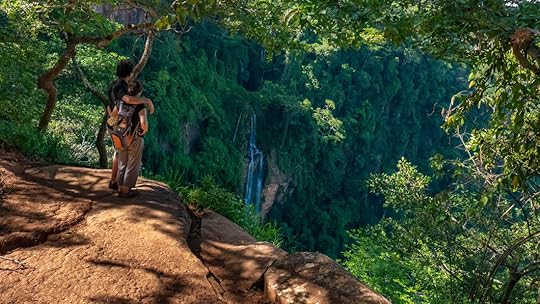 This is Manchewe Falls, near Livingstonia, Malawi. “You will never want to leave Malawi," is what people told us. “The lake is perfectly placid and warm, and swimming in it is divine." Hearing things like this got me excited to visit this small African nation bordering the most biodiverse lake in the world: Lake Malawi. But then we also heard the many warnings: “Watch out for the Bilharzia parasite," and “Beware of crocodiles."
This is Manchewe Falls, near Livingstonia, Malawi. “You will never want to leave Malawi," is what people told us. “The lake is perfectly placid and warm, and swimming in it is divine." Hearing things like this got me excited to visit this small African nation bordering the most biodiverse lake in the world: Lake Malawi. But then we also heard the many warnings: “Watch out for the Bilharzia parasite," and “Beware of crocodiles."
Moreover, it was going to be $75 per person just for the visa to enter Malawi, and because we happened to be visiting in the midst of the rainy season, the weather would be at its worst. In the end, we worried the high price to see this small country would not be worth it for us.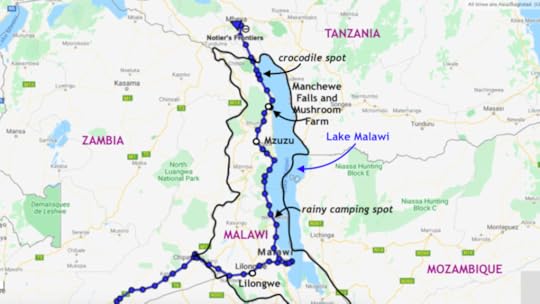 Our route through Malawi. But, you know how we are, once we get excited to see something, we have to go. So from Zambia we headed straight to Malawi, and found ourselves at another confusing and chaotic border crossing.
Our route through Malawi. But, you know how we are, once we get excited to see something, we have to go. So from Zambia we headed straight to Malawi, and found ourselves at another confusing and chaotic border crossing.
We were still traveling with our motorcycle friend, Emiliano, and when we pulled up to where people said the Malawi Customs and Immigration building was, I simply didn't believe it. There was no sign, no Malawian flag, no indication that this tiny sweltering set of walls was going to be able to process our expensive visas.
But sure enough, we'd come to the right place, and spent the next few hours standing in line between sweaty people, filling out paperwork, dishing out our hard-to-come-by US currency for the visa, along with paying for a road tax, carbon tax, and something called a consulate tax... and then after all that, as I proudly looked at the official full-page sticker for the Malawi visa in my passport, I noticed that they had labeled me as a MALE.
I sighed. “Well, I'm not going to go stand in line again to change it now," I told Tim in my best deep, manly voice.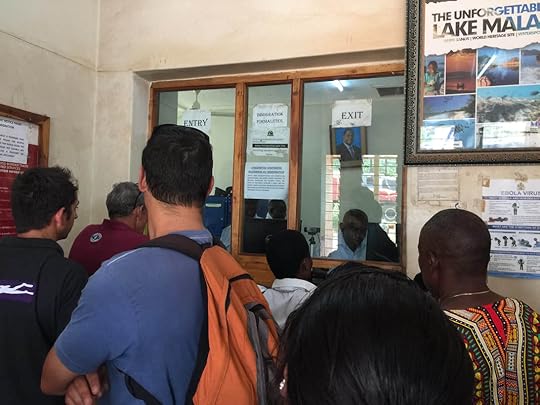 It took us hours to get through this border. From the border, the three of us rode straight to Lilongwe, Malawi's capital city, but we discovered this “city" to be small, and much of it looked rural, like the rest of Malawi.
It took us hours to get through this border. From the border, the three of us rode straight to Lilongwe, Malawi's capital city, but we discovered this “city" to be small, and much of it looked rural, like the rest of Malawi.
Dirt roads extended away from our “paved" one into grassy fields of cows grazing between clumps of brick thatched huts. People were selling bananas, pulling their goats around on a rope, riding bicycles laden in sacks of corn meal. A woman was carrying a live chicken in a plastic bag with only its head sticking out. A man was fixing people's broken flip flops, and yes, that seemed to be his full-time job.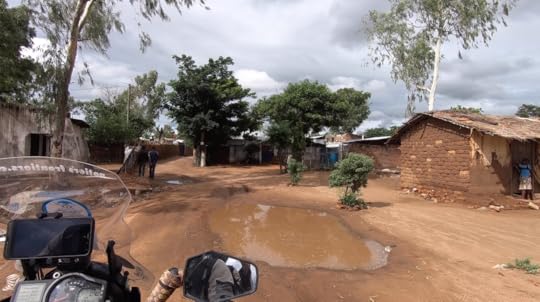 This picture wasn't taken in Lilongwe, but it's pretty representative of Malawi's "urban planning" as a whole. Every single day, in every single place we went to in Malawi, the electricity would cut out. This lack of consistent amenities made traveling through the country difficult.
This picture wasn't taken in Lilongwe, but it's pretty representative of Malawi's "urban planning" as a whole. Every single day, in every single place we went to in Malawi, the electricity would cut out. This lack of consistent amenities made traveling through the country difficult.
One time we tried to find food to cook, and we stopped by a roadside thatched hut called Mkaika Shopping Centre. But they only had loaves of processed white bread, sacks of rice and corn flour, a few tomatoes and tiny onions, and bars of laundry soap for washing clothes by hand. That's it. No meat, no eggs, no real vegetables. Just the very basics for survival.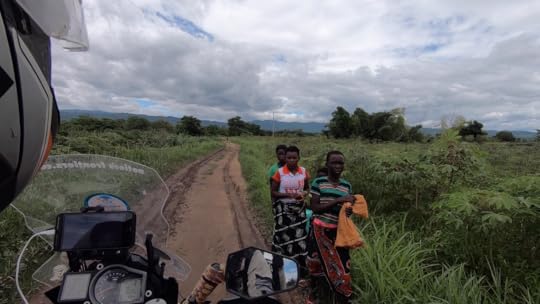 So yes, Malawi is poor, but this poverty is quickly drowned out by the country's friendly people, vibrant culture, and absolutely breathtaking landscapes. The colorful cloths that women wear as skirts, the kids waving at us from the side of the road, and most impressively, the huge blue lake surrounded by lush green mountains... Malawi may not have been gifted with great monetary wealth, but it is certainly rich in culture and natural beauty.
So yes, Malawi is poor, but this poverty is quickly drowned out by the country's friendly people, vibrant culture, and absolutely breathtaking landscapes. The colorful cloths that women wear as skirts, the kids waving at us from the side of the road, and most impressively, the huge blue lake surrounded by lush green mountains... Malawi may not have been gifted with great monetary wealth, but it is certainly rich in culture and natural beauty. 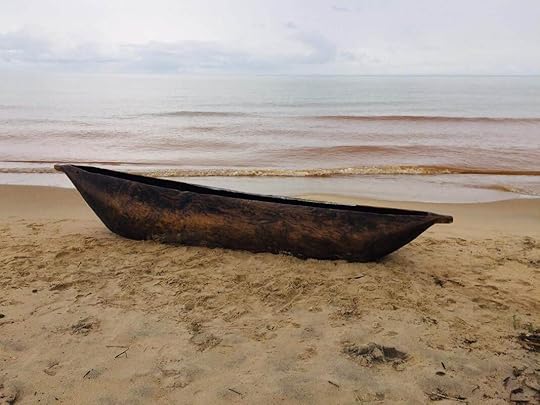 The local people masterfully hand carve these dugout canoes, and use them every day for fishing. From Lilongwe, we unfortunately had to part ways with Emiliano who wanted to head south while we went straight to the lake. And after doing a bit of research, we learned that although there is a horrible parasitic snail that lives in the lake and can infect you through your skin, if you take some pills a few weeks after swimming, you'll be fine. So we purchased the pills, waited for the rains to stop, and headed into Lake Malawi.
The local people masterfully hand carve these dugout canoes, and use them every day for fishing. From Lilongwe, we unfortunately had to part ways with Emiliano who wanted to head south while we went straight to the lake. And after doing a bit of research, we learned that although there is a horrible parasitic snail that lives in the lake and can infect you through your skin, if you take some pills a few weeks after swimming, you'll be fine. So we purchased the pills, waited for the rains to stop, and headed into Lake Malawi.
The water was soothingly warm, and the lake was dotted in wooden dugout fishing boats.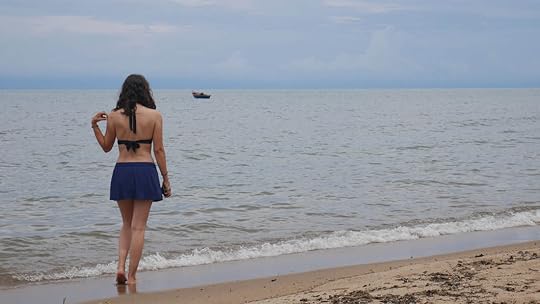 Lake Malawi is the fourth largest fresh water lake in the world by volume, and has more species of fish than any other lake. Then we got literally inundated with some pretty bad weather as we camped for two days beachside and in a constant deluge. Our tent was covered in splattered mud, our sleeping bag was damp, and our dry belongings had become threateningly low. The weather reports showed that it was going to rain every day for as far as the extended forecast would go.
Lake Malawi is the fourth largest fresh water lake in the world by volume, and has more species of fish than any other lake. Then we got literally inundated with some pretty bad weather as we camped for two days beachside and in a constant deluge. Our tent was covered in splattered mud, our sleeping bag was damp, and our dry belongings had become threateningly low. The weather reports showed that it was going to rain every day for as far as the extended forecast would go.
We knew we needed to get dry before we turned into moldy prunes.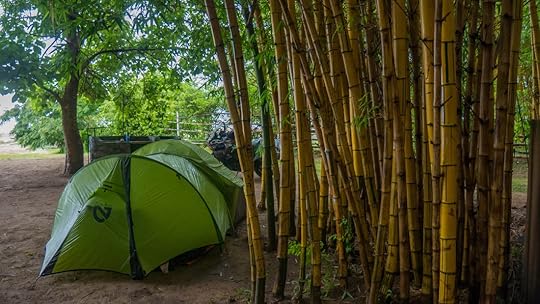 After two days of non-stop rain, this lovely bamboo grove did nothing to protect us. When it rains in Malawi, it storms in Biblical proportions. Last rainy season, 80,000 people in Malawi were displaced due to flooding, along with 60 fatalities.
After two days of non-stop rain, this lovely bamboo grove did nothing to protect us. When it rains in Malawi, it storms in Biblical proportions. Last rainy season, 80,000 people in Malawi were displaced due to flooding, along with 60 fatalities.
So Tim and I planned to leave the lake and head to the next biggest town, Mzuzu (best name ever), where we could stay indoors in a hotel, and get ourselves dry.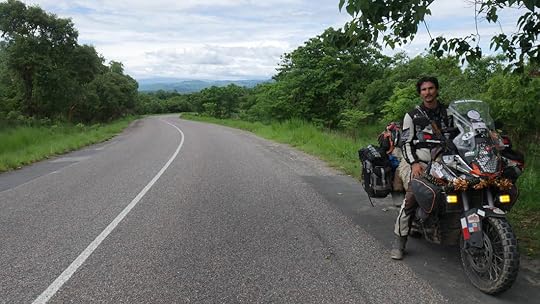 One nice thing about the rainy season is everything is green and lush. At first, I thought Malawi was going to be all about the lake. But to my surprise, it's also a land of forested mountains. Greener than green could ever be, the mountains always surrounded us. Malawi is the beginning point of the Great Rift Valley that carves its way through eastern Africa and ends in the Dead Sea: a chasm in the earth of vivid colors.
One nice thing about the rainy season is everything is green and lush. At first, I thought Malawi was going to be all about the lake. But to my surprise, it's also a land of forested mountains. Greener than green could ever be, the mountains always surrounded us. Malawi is the beginning point of the Great Rift Valley that carves its way through eastern Africa and ends in the Dead Sea: a chasm in the earth of vivid colors. 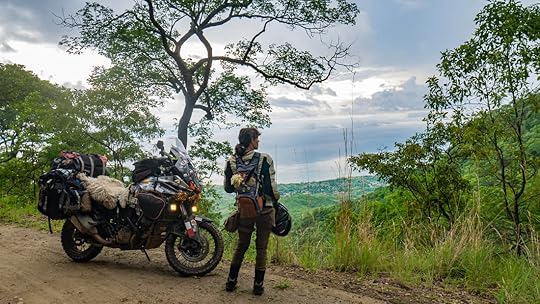 That's Lake Malawi in the distance that I'm gazing out at. We took these lovely winding mountain roads that weaved inland from the lake, but the roads were narrow, the pavement unreliable, and the rains were bucketing over us. But worst of all, Malawi's drivers acted like they wanted to hit us head-on.
That's Lake Malawi in the distance that I'm gazing out at. We took these lovely winding mountain roads that weaved inland from the lake, but the roads were narrow, the pavement unreliable, and the rains were bucketing over us. But worst of all, Malawi's drivers acted like they wanted to hit us head-on.
Just as in Peru, for some reason drivers in Malawi like to stray into your lane and play chicken with you, especially if you're on a motorcycle. They believe that motorcycles are small and slow (neither of which is true for us) and should move out of the way of bigger vehicles. Trucks were barreling frighteningly close to us, and we were being run off the road into the mud and flooded-out gravel, which was equally dangerous. Tim laid on the horn, flashed his brights at all oncoming traffic, but his efforts were being drowned out by the pounding rain.
And then there was this one semi truck that simply did not care about our lives. We skirted over as far as we could go, but as he came at us full-speed, I thought, “Ok, this is it. We're going to die." Somehow, and I still don't know how, the truck did not hit us. It must have come less than an inch away from our pannier. We could feel the wobble of the wind it created as the semi swished passed us, and with our stomachs in our throats, we pulled over to take a breather.
“That was the closest we've ever come to death on the road," Tim said to me as we sat in the rain.
Very slowly, and very carefully, we pushed on to Mzuzu, and somehow made it there alive.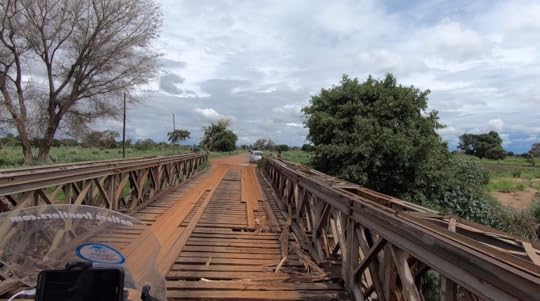 Just a typical bridge in Malawi. Mzuzu had a supermarket, which was very exciting for us. Plus, our hotel had a hot shower and internet when there was electricity. We strung up a clothes line in our bathroom to get our stuff dry, but our enjoyment was short lived.
Just a typical bridge in Malawi. Mzuzu had a supermarket, which was very exciting for us. Plus, our hotel had a hot shower and internet when there was electricity. We strung up a clothes line in our bathroom to get our stuff dry, but our enjoyment was short lived.
On the second day there, we both got sick. It was food poisoning, a need-to-go-to-the-bathroom type of sick. Good thing we had our own en suite toilet and there was a pharmacy across the street.
We ended up staying a week in Mzuzu to recover. And finally, on the eighth day the sun came out, we felt better, and we decided to leave. But as we started packing up, we opened up one of our panniers and the horrible stench of athlete's foot came wafting out from our sleeping pads.
Mold. All our camping gear was covered in putrid, festering mold.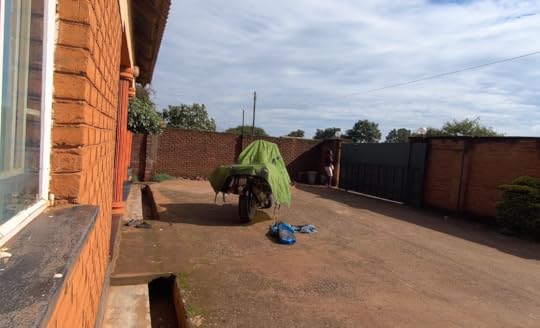 Finally sunshine! Perfect for drying out our moldy tent rain-fly. We had no one to blame for this but our own stupid selves. So we took everything out, poured toilet-bowl bleach all over our sleeping pads, and started scrubbing.
Finally sunshine! Perfect for drying out our moldy tent rain-fly. We had no one to blame for this but our own stupid selves. So we took everything out, poured toilet-bowl bleach all over our sleeping pads, and started scrubbing.
A few hours later, and due to the drying power of that one sunny day, the little green circles of mold stains had faded and didn't smell so bad anymore. So we once again packed up, kept our fingers crossed for no rain, and headed higher into the mountains to a place called the Mushroom Farm.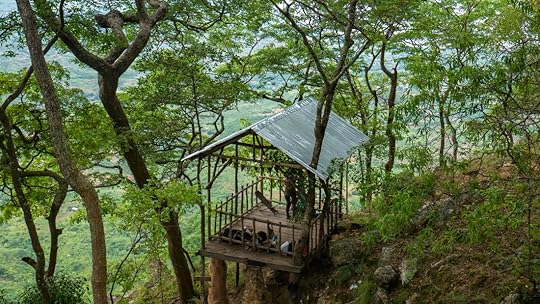 We pitched our tent right in this cliff-side structure.
We pitched our tent right in this cliff-side structure. 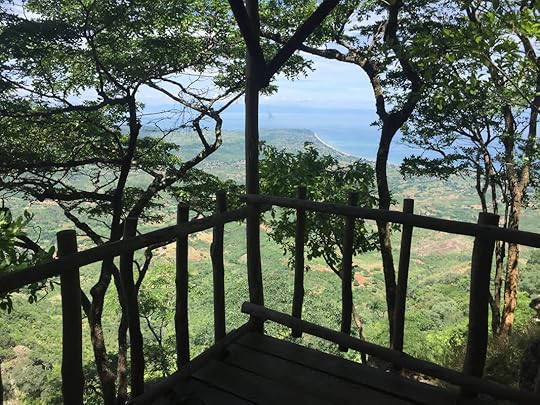 And what a view! You could see all the way to Tanzania behind the lake. Built on a vertical cliff overlooking Lake Malawi, the Mushroom Farm is a hotel/campground that is also hiking distance from Manchewe Waterfalls in Nyika National Park. We took the backroads to the farm through the park, which was beautiful, and then hiked to the falls, and it was definitely worth the trek (see the first picture of this post).
And what a view! You could see all the way to Tanzania behind the lake. Built on a vertical cliff overlooking Lake Malawi, the Mushroom Farm is a hotel/campground that is also hiking distance from Manchewe Waterfalls in Nyika National Park. We took the backroads to the farm through the park, which was beautiful, and then hiked to the falls, and it was definitely worth the trek (see the first picture of this post).
But it was the road out that was the most spectacular of all: a rocky and rutted set of tight switchbacks through the jungle with views of the blue Lake Malawi interspersed between the trees.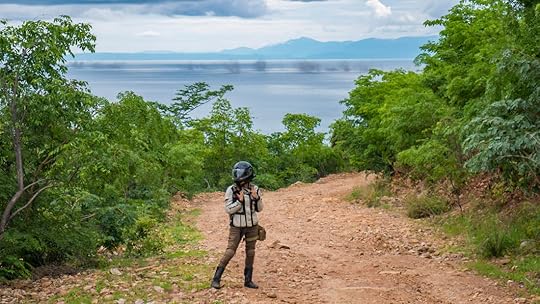 Here I am looking like an astronaut. Apparently, these smoky wisps on the lake behind me are swarms of midges. Bizarre. But our problems were not over. As we descended, suddenly the engine of the bike cut. The power was still on, and the dash was flashing all sorts of warnings at us. But with relief, Tim was able to get the bike started.
Here I am looking like an astronaut. Apparently, these smoky wisps on the lake behind me are swarms of midges. Bizarre. But our problems were not over. As we descended, suddenly the engine of the bike cut. The power was still on, and the dash was flashing all sorts of warnings at us. But with relief, Tim was able to get the bike started.
And then it died again. And again. Thank goodness we were headed steeply downhill and didn't actually need the engine, but by the twelfth time that the bike randomly shut off, we kept thinking, what is wrong with it now!?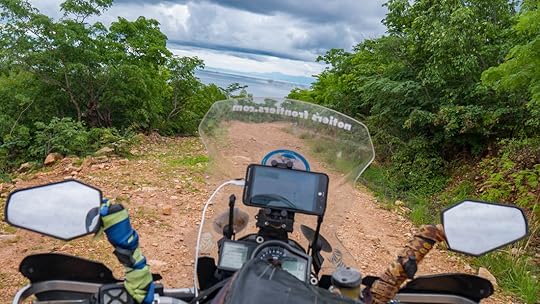 We were able to limp our way to a lakeside campsite, where Tim headed online to post an SOS to all KTM 1190 savvy folks out there who might be able to diagnose the problem. The next proper KTM dealership was in Kenya, so getting our bike to a professional was out of the question. And all the local mechanics of Malawi only knew about the little bikes they had, not a massive and electronically-complicated adventure bike like our 1190.
We were able to limp our way to a lakeside campsite, where Tim headed online to post an SOS to all KTM 1190 savvy folks out there who might be able to diagnose the problem. The next proper KTM dealership was in Kenya, so getting our bike to a professional was out of the question. And all the local mechanics of Malawi only knew about the little bikes they had, not a massive and electronically-complicated adventure bike like our 1190.
But thanks to the online community, people came up with some great suggestions. One theory was that our bike may have had an electrical “aneurysm", and in computer terms, needed a reboot. So after taking out the battery, checking all the connections, and putting things back together, we decided to take a test ride up the mountain again and back down. It was the same road, and we were replicating the same circumstances, and luckily, nothing went wrong this time.
So we're hoping that the aneurysm theory was right, and so far, our beloved bike has been back in business. I love this picture of Tim. Before we left Malawi, we wanted to take one more dip in the lake as a final goodbye. But then we were told by the camp hosts that there was a crocodile recently seen at the lake's edge. “Last year, a village boy was eaten by one," he said. In other words, “Go swimming and have fun," we were told. “But just be very, very careful."
I love this picture of Tim. Before we left Malawi, we wanted to take one more dip in the lake as a final goodbye. But then we were told by the camp hosts that there was a crocodile recently seen at the lake's edge. “Last year, a village boy was eaten by one," he said. In other words, “Go swimming and have fun," we were told. “But just be very, very careful."
Ok, I was beginning to realize that swimming in Lake Malawi was not going to be as divine as I had once hoped. Or maybe we were just unlucky with our timing and selected swimming locations. But we ended up wading our feet in, and taking a final stroll along the beach instead of a swim. Guessing by our luck so far, we would have definitely been eaten by that crocodile if we went in.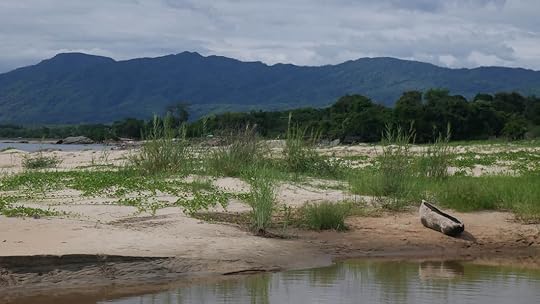 Yeah, this looks like crocodile heaven. Malawi has been full of adventures for us, and it's shown us its beautiful side and its ugly side. Warm waters, tropical mountains, parasites, crocodiles, chickens in bags... Malawi definitely has that perfect blend of incredible landscapes mixed with a unique and fascinating culture, all topped with just a dash of heart-pounding adventure.
Yeah, this looks like crocodile heaven. Malawi has been full of adventures for us, and it's shown us its beautiful side and its ugly side. Warm waters, tropical mountains, parasites, crocodiles, chickens in bags... Malawi definitely has that perfect blend of incredible landscapes mixed with a unique and fascinating culture, all topped with just a dash of heart-pounding adventure.
Now, we're moving on to our next country: Tanzania. And I couldn't be more excited.
This week we'd like to thank Brendon Lever for his generosity, and all those who have left reviews of Tim's book on Amazon. They are heartfelt and very appreciated, and have been great motivation for him to finish up his next book: Two-Up and Overloaded! We also want to give a shout out to our dear friend Jacques in South Africa who showed us our first African off-road mountain pass, our first braai, and despite facing some obstacles along the road, he's still keeping it strong.
Stay tuned and we'll keep you posted on the next chapter of our journey. Subscribe to Our Blog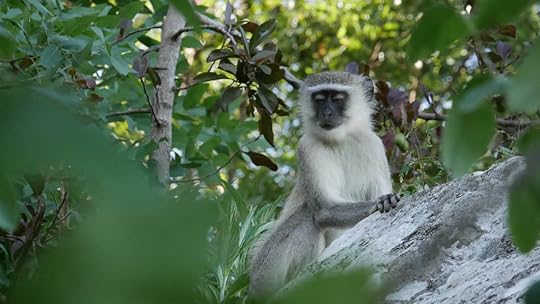 And we leave you with a picture of the wisest monkey in Malawi.
And we leave you with a picture of the wisest monkey in Malawi.
 This is Manchewe Falls, near Livingstonia, Malawi. “You will never want to leave Malawi," is what people told us. “The lake is perfectly placid and warm, and swimming in it is divine." Hearing things like this got me excited to visit this small African nation bordering the most biodiverse lake in the world: Lake Malawi. But then we also heard the many warnings: “Watch out for the Bilharzia parasite," and “Beware of crocodiles."
This is Manchewe Falls, near Livingstonia, Malawi. “You will never want to leave Malawi," is what people told us. “The lake is perfectly placid and warm, and swimming in it is divine." Hearing things like this got me excited to visit this small African nation bordering the most biodiverse lake in the world: Lake Malawi. But then we also heard the many warnings: “Watch out for the Bilharzia parasite," and “Beware of crocodiles."Moreover, it was going to be $75 per person just for the visa to enter Malawi, and because we happened to be visiting in the midst of the rainy season, the weather would be at its worst. In the end, we worried the high price to see this small country would not be worth it for us.
 Our route through Malawi. But, you know how we are, once we get excited to see something, we have to go. So from Zambia we headed straight to Malawi, and found ourselves at another confusing and chaotic border crossing.
Our route through Malawi. But, you know how we are, once we get excited to see something, we have to go. So from Zambia we headed straight to Malawi, and found ourselves at another confusing and chaotic border crossing.We were still traveling with our motorcycle friend, Emiliano, and when we pulled up to where people said the Malawi Customs and Immigration building was, I simply didn't believe it. There was no sign, no Malawian flag, no indication that this tiny sweltering set of walls was going to be able to process our expensive visas.
But sure enough, we'd come to the right place, and spent the next few hours standing in line between sweaty people, filling out paperwork, dishing out our hard-to-come-by US currency for the visa, along with paying for a road tax, carbon tax, and something called a consulate tax... and then after all that, as I proudly looked at the official full-page sticker for the Malawi visa in my passport, I noticed that they had labeled me as a MALE.
I sighed. “Well, I'm not going to go stand in line again to change it now," I told Tim in my best deep, manly voice.
 It took us hours to get through this border. From the border, the three of us rode straight to Lilongwe, Malawi's capital city, but we discovered this “city" to be small, and much of it looked rural, like the rest of Malawi.
It took us hours to get through this border. From the border, the three of us rode straight to Lilongwe, Malawi's capital city, but we discovered this “city" to be small, and much of it looked rural, like the rest of Malawi.Dirt roads extended away from our “paved" one into grassy fields of cows grazing between clumps of brick thatched huts. People were selling bananas, pulling their goats around on a rope, riding bicycles laden in sacks of corn meal. A woman was carrying a live chicken in a plastic bag with only its head sticking out. A man was fixing people's broken flip flops, and yes, that seemed to be his full-time job.
 This picture wasn't taken in Lilongwe, but it's pretty representative of Malawi's "urban planning" as a whole. Every single day, in every single place we went to in Malawi, the electricity would cut out. This lack of consistent amenities made traveling through the country difficult.
This picture wasn't taken in Lilongwe, but it's pretty representative of Malawi's "urban planning" as a whole. Every single day, in every single place we went to in Malawi, the electricity would cut out. This lack of consistent amenities made traveling through the country difficult.One time we tried to find food to cook, and we stopped by a roadside thatched hut called Mkaika Shopping Centre. But they only had loaves of processed white bread, sacks of rice and corn flour, a few tomatoes and tiny onions, and bars of laundry soap for washing clothes by hand. That's it. No meat, no eggs, no real vegetables. Just the very basics for survival.
 So yes, Malawi is poor, but this poverty is quickly drowned out by the country's friendly people, vibrant culture, and absolutely breathtaking landscapes. The colorful cloths that women wear as skirts, the kids waving at us from the side of the road, and most impressively, the huge blue lake surrounded by lush green mountains... Malawi may not have been gifted with great monetary wealth, but it is certainly rich in culture and natural beauty.
So yes, Malawi is poor, but this poverty is quickly drowned out by the country's friendly people, vibrant culture, and absolutely breathtaking landscapes. The colorful cloths that women wear as skirts, the kids waving at us from the side of the road, and most impressively, the huge blue lake surrounded by lush green mountains... Malawi may not have been gifted with great monetary wealth, but it is certainly rich in culture and natural beauty.  The local people masterfully hand carve these dugout canoes, and use them every day for fishing. From Lilongwe, we unfortunately had to part ways with Emiliano who wanted to head south while we went straight to the lake. And after doing a bit of research, we learned that although there is a horrible parasitic snail that lives in the lake and can infect you through your skin, if you take some pills a few weeks after swimming, you'll be fine. So we purchased the pills, waited for the rains to stop, and headed into Lake Malawi.
The local people masterfully hand carve these dugout canoes, and use them every day for fishing. From Lilongwe, we unfortunately had to part ways with Emiliano who wanted to head south while we went straight to the lake. And after doing a bit of research, we learned that although there is a horrible parasitic snail that lives in the lake and can infect you through your skin, if you take some pills a few weeks after swimming, you'll be fine. So we purchased the pills, waited for the rains to stop, and headed into Lake Malawi.The water was soothingly warm, and the lake was dotted in wooden dugout fishing boats.
 Lake Malawi is the fourth largest fresh water lake in the world by volume, and has more species of fish than any other lake. Then we got literally inundated with some pretty bad weather as we camped for two days beachside and in a constant deluge. Our tent was covered in splattered mud, our sleeping bag was damp, and our dry belongings had become threateningly low. The weather reports showed that it was going to rain every day for as far as the extended forecast would go.
Lake Malawi is the fourth largest fresh water lake in the world by volume, and has more species of fish than any other lake. Then we got literally inundated with some pretty bad weather as we camped for two days beachside and in a constant deluge. Our tent was covered in splattered mud, our sleeping bag was damp, and our dry belongings had become threateningly low. The weather reports showed that it was going to rain every day for as far as the extended forecast would go.We knew we needed to get dry before we turned into moldy prunes.
 After two days of non-stop rain, this lovely bamboo grove did nothing to protect us. When it rains in Malawi, it storms in Biblical proportions. Last rainy season, 80,000 people in Malawi were displaced due to flooding, along with 60 fatalities.
After two days of non-stop rain, this lovely bamboo grove did nothing to protect us. When it rains in Malawi, it storms in Biblical proportions. Last rainy season, 80,000 people in Malawi were displaced due to flooding, along with 60 fatalities.So Tim and I planned to leave the lake and head to the next biggest town, Mzuzu (best name ever), where we could stay indoors in a hotel, and get ourselves dry.
 One nice thing about the rainy season is everything is green and lush. At first, I thought Malawi was going to be all about the lake. But to my surprise, it's also a land of forested mountains. Greener than green could ever be, the mountains always surrounded us. Malawi is the beginning point of the Great Rift Valley that carves its way through eastern Africa and ends in the Dead Sea: a chasm in the earth of vivid colors.
One nice thing about the rainy season is everything is green and lush. At first, I thought Malawi was going to be all about the lake. But to my surprise, it's also a land of forested mountains. Greener than green could ever be, the mountains always surrounded us. Malawi is the beginning point of the Great Rift Valley that carves its way through eastern Africa and ends in the Dead Sea: a chasm in the earth of vivid colors.  That's Lake Malawi in the distance that I'm gazing out at. We took these lovely winding mountain roads that weaved inland from the lake, but the roads were narrow, the pavement unreliable, and the rains were bucketing over us. But worst of all, Malawi's drivers acted like they wanted to hit us head-on.
That's Lake Malawi in the distance that I'm gazing out at. We took these lovely winding mountain roads that weaved inland from the lake, but the roads were narrow, the pavement unreliable, and the rains were bucketing over us. But worst of all, Malawi's drivers acted like they wanted to hit us head-on.Just as in Peru, for some reason drivers in Malawi like to stray into your lane and play chicken with you, especially if you're on a motorcycle. They believe that motorcycles are small and slow (neither of which is true for us) and should move out of the way of bigger vehicles. Trucks were barreling frighteningly close to us, and we were being run off the road into the mud and flooded-out gravel, which was equally dangerous. Tim laid on the horn, flashed his brights at all oncoming traffic, but his efforts were being drowned out by the pounding rain.
And then there was this one semi truck that simply did not care about our lives. We skirted over as far as we could go, but as he came at us full-speed, I thought, “Ok, this is it. We're going to die." Somehow, and I still don't know how, the truck did not hit us. It must have come less than an inch away from our pannier. We could feel the wobble of the wind it created as the semi swished passed us, and with our stomachs in our throats, we pulled over to take a breather.
“That was the closest we've ever come to death on the road," Tim said to me as we sat in the rain.
Very slowly, and very carefully, we pushed on to Mzuzu, and somehow made it there alive.
 Just a typical bridge in Malawi. Mzuzu had a supermarket, which was very exciting for us. Plus, our hotel had a hot shower and internet when there was electricity. We strung up a clothes line in our bathroom to get our stuff dry, but our enjoyment was short lived.
Just a typical bridge in Malawi. Mzuzu had a supermarket, which was very exciting for us. Plus, our hotel had a hot shower and internet when there was electricity. We strung up a clothes line in our bathroom to get our stuff dry, but our enjoyment was short lived.On the second day there, we both got sick. It was food poisoning, a need-to-go-to-the-bathroom type of sick. Good thing we had our own en suite toilet and there was a pharmacy across the street.
We ended up staying a week in Mzuzu to recover. And finally, on the eighth day the sun came out, we felt better, and we decided to leave. But as we started packing up, we opened up one of our panniers and the horrible stench of athlete's foot came wafting out from our sleeping pads.
Mold. All our camping gear was covered in putrid, festering mold.
 Finally sunshine! Perfect for drying out our moldy tent rain-fly. We had no one to blame for this but our own stupid selves. So we took everything out, poured toilet-bowl bleach all over our sleeping pads, and started scrubbing.
Finally sunshine! Perfect for drying out our moldy tent rain-fly. We had no one to blame for this but our own stupid selves. So we took everything out, poured toilet-bowl bleach all over our sleeping pads, and started scrubbing.A few hours later, and due to the drying power of that one sunny day, the little green circles of mold stains had faded and didn't smell so bad anymore. So we once again packed up, kept our fingers crossed for no rain, and headed higher into the mountains to a place called the Mushroom Farm.
 We pitched our tent right in this cliff-side structure.
We pitched our tent right in this cliff-side structure.  And what a view! You could see all the way to Tanzania behind the lake. Built on a vertical cliff overlooking Lake Malawi, the Mushroom Farm is a hotel/campground that is also hiking distance from Manchewe Waterfalls in Nyika National Park. We took the backroads to the farm through the park, which was beautiful, and then hiked to the falls, and it was definitely worth the trek (see the first picture of this post).
And what a view! You could see all the way to Tanzania behind the lake. Built on a vertical cliff overlooking Lake Malawi, the Mushroom Farm is a hotel/campground that is also hiking distance from Manchewe Waterfalls in Nyika National Park. We took the backroads to the farm through the park, which was beautiful, and then hiked to the falls, and it was definitely worth the trek (see the first picture of this post).But it was the road out that was the most spectacular of all: a rocky and rutted set of tight switchbacks through the jungle with views of the blue Lake Malawi interspersed between the trees.
 Here I am looking like an astronaut. Apparently, these smoky wisps on the lake behind me are swarms of midges. Bizarre. But our problems were not over. As we descended, suddenly the engine of the bike cut. The power was still on, and the dash was flashing all sorts of warnings at us. But with relief, Tim was able to get the bike started.
Here I am looking like an astronaut. Apparently, these smoky wisps on the lake behind me are swarms of midges. Bizarre. But our problems were not over. As we descended, suddenly the engine of the bike cut. The power was still on, and the dash was flashing all sorts of warnings at us. But with relief, Tim was able to get the bike started.And then it died again. And again. Thank goodness we were headed steeply downhill and didn't actually need the engine, but by the twelfth time that the bike randomly shut off, we kept thinking, what is wrong with it now!?
 We were able to limp our way to a lakeside campsite, where Tim headed online to post an SOS to all KTM 1190 savvy folks out there who might be able to diagnose the problem. The next proper KTM dealership was in Kenya, so getting our bike to a professional was out of the question. And all the local mechanics of Malawi only knew about the little bikes they had, not a massive and electronically-complicated adventure bike like our 1190.
We were able to limp our way to a lakeside campsite, where Tim headed online to post an SOS to all KTM 1190 savvy folks out there who might be able to diagnose the problem. The next proper KTM dealership was in Kenya, so getting our bike to a professional was out of the question. And all the local mechanics of Malawi only knew about the little bikes they had, not a massive and electronically-complicated adventure bike like our 1190.But thanks to the online community, people came up with some great suggestions. One theory was that our bike may have had an electrical “aneurysm", and in computer terms, needed a reboot. So after taking out the battery, checking all the connections, and putting things back together, we decided to take a test ride up the mountain again and back down. It was the same road, and we were replicating the same circumstances, and luckily, nothing went wrong this time.
So we're hoping that the aneurysm theory was right, and so far, our beloved bike has been back in business.
 I love this picture of Tim. Before we left Malawi, we wanted to take one more dip in the lake as a final goodbye. But then we were told by the camp hosts that there was a crocodile recently seen at the lake's edge. “Last year, a village boy was eaten by one," he said. In other words, “Go swimming and have fun," we were told. “But just be very, very careful."
I love this picture of Tim. Before we left Malawi, we wanted to take one more dip in the lake as a final goodbye. But then we were told by the camp hosts that there was a crocodile recently seen at the lake's edge. “Last year, a village boy was eaten by one," he said. In other words, “Go swimming and have fun," we were told. “But just be very, very careful."Ok, I was beginning to realize that swimming in Lake Malawi was not going to be as divine as I had once hoped. Or maybe we were just unlucky with our timing and selected swimming locations. But we ended up wading our feet in, and taking a final stroll along the beach instead of a swim. Guessing by our luck so far, we would have definitely been eaten by that crocodile if we went in.
 Yeah, this looks like crocodile heaven. Malawi has been full of adventures for us, and it's shown us its beautiful side and its ugly side. Warm waters, tropical mountains, parasites, crocodiles, chickens in bags... Malawi definitely has that perfect blend of incredible landscapes mixed with a unique and fascinating culture, all topped with just a dash of heart-pounding adventure.
Yeah, this looks like crocodile heaven. Malawi has been full of adventures for us, and it's shown us its beautiful side and its ugly side. Warm waters, tropical mountains, parasites, crocodiles, chickens in bags... Malawi definitely has that perfect blend of incredible landscapes mixed with a unique and fascinating culture, all topped with just a dash of heart-pounding adventure.Now, we're moving on to our next country: Tanzania. And I couldn't be more excited.
This week we'd like to thank Brendon Lever for his generosity, and all those who have left reviews of Tim's book on Amazon. They are heartfelt and very appreciated, and have been great motivation for him to finish up his next book: Two-Up and Overloaded! We also want to give a shout out to our dear friend Jacques in South Africa who showed us our first African off-road mountain pass, our first braai, and despite facing some obstacles along the road, he's still keeping it strong.
Stay tuned and we'll keep you posted on the next chapter of our journey. Subscribe to Our Blog
 And we leave you with a picture of the wisest monkey in Malawi.
And we leave you with a picture of the wisest monkey in Malawi.
Published on January 13, 2020 00:00
December 29, 2019
Zambia's Natural Christmas Lights
By Marisa 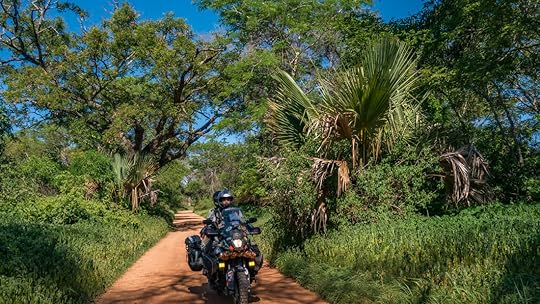 We entered Zambia from Botswana through one of the most difficult border crossings we’ve ever experienced. We were traveling with our motorcycle friend, Emiliano, and crossing borders with another traveler usually makes things easier. With three people, two of them can try to figure out the procedures and stand in separate lines, and one can watch the bikes (me).
We entered Zambia from Botswana through one of the most difficult border crossings we’ve ever experienced. We were traveling with our motorcycle friend, Emiliano, and crossing borders with another traveler usually makes things easier. With three people, two of them can try to figure out the procedures and stand in separate lines, and one can watch the bikes (me).
But for some reason, nothing seemed to be easy when it came to the convoluted process that was getting a visa and vehicle entry permit into Zambia. The heat, the lack of signage, the expense of it ($50 USD for a Zambia/Zimbabwe visa, $20 USD for road tax, more money for carbon taxes, insurance, paying fixers, all in Zambian Kwacha), and most of all, the chaos of the place, made it a horrible experience.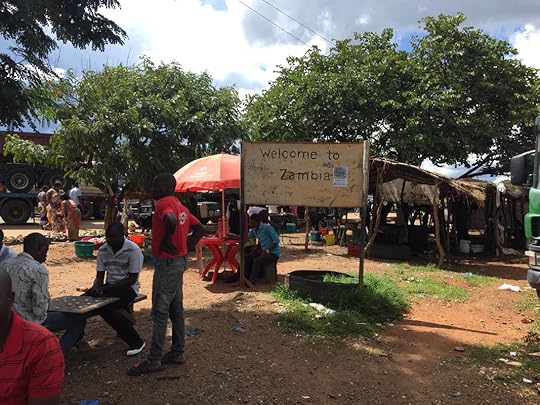 This sign says it all. Nearly five hours later, we had three completely empty wallets, no water left in our water bottles, and no food in our stomachs, but we got through the border. I had spent the entire time watching the bikes and trying to convince a drunk guy that I wasn’t going to buy his fire extinguisher, even though he insisted it was the law that all motorcyclists had to carry one in Zambia. Tim and Emiliano got ripped off by their fixer and they overpaid for Zambian insurance by about $40 a person. It was a disaster, and later on, we were able to report the names of our cheating fixers to the insurance headquarters when we upgraded our COMESA insurance.
This sign says it all. Nearly five hours later, we had three completely empty wallets, no water left in our water bottles, and no food in our stomachs, but we got through the border. I had spent the entire time watching the bikes and trying to convince a drunk guy that I wasn’t going to buy his fire extinguisher, even though he insisted it was the law that all motorcyclists had to carry one in Zambia. Tim and Emiliano got ripped off by their fixer and they overpaid for Zambian insurance by about $40 a person. It was a disaster, and later on, we were able to report the names of our cheating fixers to the insurance headquarters when we upgraded our COMESA insurance.
But at least now we were in Zambia.
And I have to say that this border crossing may have been a good introduction to the country. Because in comparison to Westernized South Africa, Namibia, and Botswana, Zambia was the first place that I felt I had truly entered the “Africa” that I had been told about, both the good and the bad.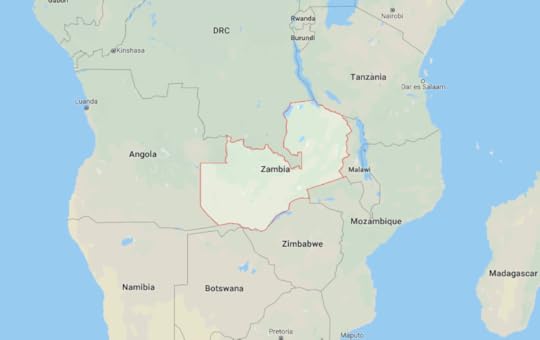 I know you were wondering where Zambia was. The bad was the chaos of the border: the cheating lies of our “friendly” helpers, the line of stinky trucks on a muddy dirt road, and the water bottles littered everywhere that had been there for so long, they almost looked like mud-covered cobblestones.
I know you were wondering where Zambia was. The bad was the chaos of the border: the cheating lies of our “friendly” helpers, the line of stinky trucks on a muddy dirt road, and the water bottles littered everywhere that had been there for so long, they almost looked like mud-covered cobblestones.
But the good was more beautiful than I had ever expected.
On the other side of the border, the roads were lined in green foliage, bright and rich from the recent rains, and between the trees you could see round mud-brick houses with thatched roofs. Men rode around on old bicycles with baskets of goats, turkeys, chickens, or children on the back. Women wore colorful saris wrapped around their waists as a skirt and sometimes tucked it in over their chest like an oversized bath towel. Their hair would be done up in intricately-designed braids, sometimes dyed in similar colors to their clothes. And to literally top it all off, nearly every woman would be carrying something on top of her head, perfectly balanced on a platform of braids. A tray of bananas or mangoes maybe, or a bushel of corn meal, and a Zambian woman’s purse is always better carried on her head than over her shoulder.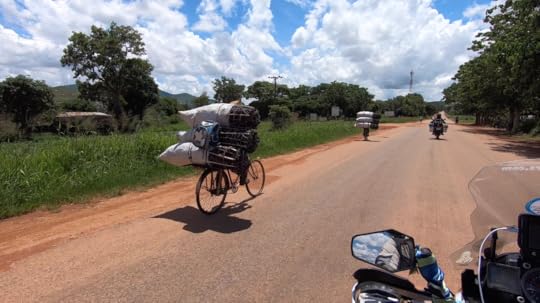 These cyclists are carrying home-made charcoal, a hot commodity of Zambia. I particularly like this man's Mickey Mouse backpack strapped on the back. Once across the border, I immediately felt that this was the Africa that I had hoped still existed somewhere out there. And as we rode the short ride to Livingstone, I couldn’t help but smile the whole way there.
These cyclists are carrying home-made charcoal, a hot commodity of Zambia. I particularly like this man's Mickey Mouse backpack strapped on the back. Once across the border, I immediately felt that this was the Africa that I had hoped still existed somewhere out there. And as we rode the short ride to Livingstone, I couldn’t help but smile the whole way there. 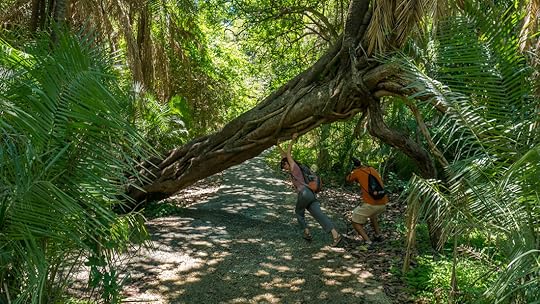 Zambia has some incredible nature. Good thing I was there to save Emiliano from this falling tree. Most tourists come to Zambia for one reason: to see Victoria Falls. As one of the largest waterfalls on earth, Victoria Falls is impressive and it's been a dream destination of mine for a long time. Created by the mighty Zambezi River (which Zambia is named for), the falls are actually split between the countries of Zambia and Zimbabwe, and so there is the eternal debate amongst travelers as to which side is better, and whether it’s necessary to see both.
Zambia has some incredible nature. Good thing I was there to save Emiliano from this falling tree. Most tourists come to Zambia for one reason: to see Victoria Falls. As one of the largest waterfalls on earth, Victoria Falls is impressive and it's been a dream destination of mine for a long time. Created by the mighty Zambezi River (which Zambia is named for), the falls are actually split between the countries of Zambia and Zimbabwe, and so there is the eternal debate amongst travelers as to which side is better, and whether it’s necessary to see both. 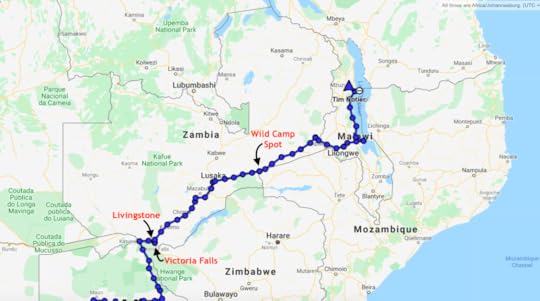 To make things ultra confusing, people often shorten these country names to Zam and Zim when talking about the falls. But despite their similar names, there is a huge difference between Zambia and Zimbabwe, especially at this moment in history. Long ago, they were regions of the same country known as Northern and Southern Rhodesia, but ever since their split, they’ve gone in two different directions.
To make things ultra confusing, people often shorten these country names to Zam and Zim when talking about the falls. But despite their similar names, there is a huge difference between Zambia and Zimbabwe, especially at this moment in history. Long ago, they were regions of the same country known as Northern and Southern Rhodesia, but ever since their split, they’ve gone in two different directions.
Due to a continued relationship with international communities, Zambia is relatively safe and stable to travel through. But because Zimbabwe has been economically hindered for decades by the controversial policies of its former leader, the revolutionary Robert Mugabe, traveling through this proudly independent country is much more challenging. Even after Mugabe's death in 2019, basic services are still lacking, lines for petrol are long, and crime caused by “machete gangs" are a real problem.
So if Victoria Falls were said to be more impressive on the Zimbabwe side, would the risk of going be worth it?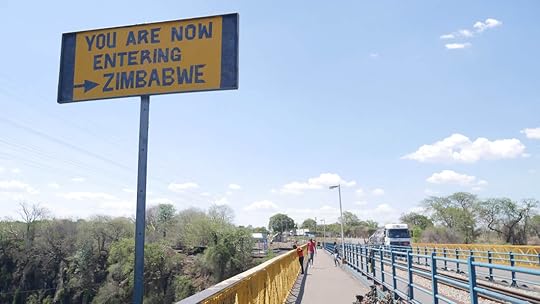 It turns out that heading into Zimbabwe for the day just to see Victoria Falls is safe and easy, as the two countries have a visa deal and a strong tourist infrastructure in place, even if it's just in that one spot. Plus, we came to the falls at the worst possible time of year, the end of the dry season, and the Zambia side was said to be just a trickle. So if we wanted to see more than a dry cliff, we’d have to go into Zimbabwe.
It turns out that heading into Zimbabwe for the day just to see Victoria Falls is safe and easy, as the two countries have a visa deal and a strong tourist infrastructure in place, even if it's just in that one spot. Plus, we came to the falls at the worst possible time of year, the end of the dry season, and the Zambia side was said to be just a trickle. So if we wanted to see more than a dry cliff, we’d have to go into Zimbabwe.
Visiting Victoria Falls is not cheap. The visa for entering both countries is $50 (called UniVisa), the park entrance fee to Zimbabwe is $30 per person, and for Zambia it’s $20. For two people, that's $200, but for most, the falls are worth it.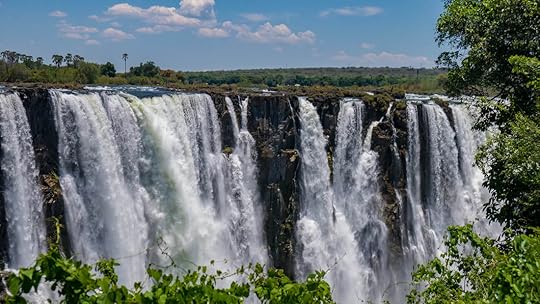 The glorious Victoria Falls. We went to Zimbabwe first, which was good, because we were so sweaty and tired afterwards, that we never even got to the Zambia side, and didn’t really need to. The views that we saw were certainly enough.
The glorious Victoria Falls. We went to Zimbabwe first, which was good, because we were so sweaty and tired afterwards, that we never even got to the Zambia side, and didn’t really need to. The views that we saw were certainly enough.
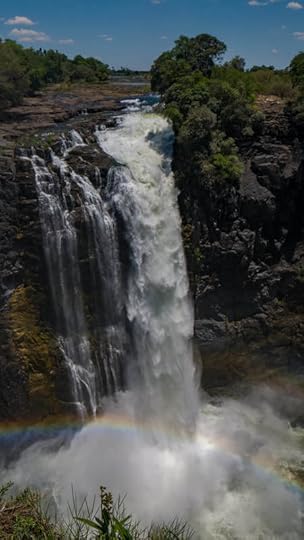 The original name for Vic Falls was Mosi-oa-Tunya, meaning “The Smoke that Thunders", and once you're there, you can definitely see why. And there's so much more to do there than just waterfall watching. You can also zip-line across the canyon, bungee jump, take a helicopter ride, white-water raft (Emiliano did it and loved it), or swim to the edge of the falls in something called Devil's Pool.
The original name for Vic Falls was Mosi-oa-Tunya, meaning “The Smoke that Thunders", and once you're there, you can definitely see why. And there's so much more to do there than just waterfall watching. You can also zip-line across the canyon, bungee jump, take a helicopter ride, white-water raft (Emiliano did it and loved it), or swim to the edge of the falls in something called Devil's Pool. 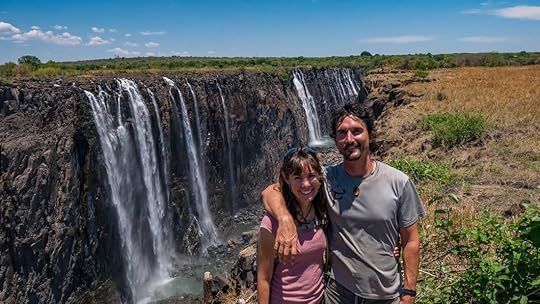 It was so beautiful there, we barely noticed it was 105˚ out with full humidity. Ok, we may have noticed a little. The jumping-off point for most people visiting the Falls is the town of Livingstone in Zambia. Built for tourists, it’s got everything you could want: post cards, people selling knick-knacks on the street, a supermarket, and even a “Starbucks-like” café. The only problem is, like the rest of Zambia, Livingstone doesn’t have consistent electricity. We were lucky while we were there, because the President of Zambia also happened to be in town, which meant they kept the lights, fans, and very slow internet on… most of the time.
It was so beautiful there, we barely noticed it was 105˚ out with full humidity. Ok, we may have noticed a little. The jumping-off point for most people visiting the Falls is the town of Livingstone in Zambia. Built for tourists, it’s got everything you could want: post cards, people selling knick-knacks on the street, a supermarket, and even a “Starbucks-like” café. The only problem is, like the rest of Zambia, Livingstone doesn’t have consistent electricity. We were lucky while we were there, because the President of Zambia also happened to be in town, which meant they kept the lights, fans, and very slow internet on… most of the time.
Livingstone is such a tourist hub, we ended up meeting lots of other motorcycle travelers there, and spent a couple of fantastic days hanging out with Andie. She's a British motorcyclist who lived in Livingstone on and off for years and had all the scoop on what to see and do. She was insanely fun to talk to, and the hours would fly by without us even realizing it. She even gave us talismans carved of the Zambezi River God called Nyami Nyami, who was said to be a serpent-shaped protector of all who go to the river.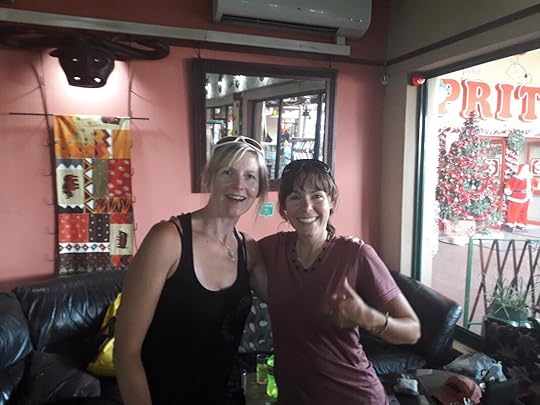 Andie and I in Livingstone, Zambia. We could have stayed in Livingstone for much longer, talking with friends, eating free pancakes at our hotel, and swimming in the pool, but Christmas was coming up, and we had other plans. So Emiliano, Tim, and I said our goodbyes to our new friends, packed up, and headed into the heat so explore more of Zambia.
Andie and I in Livingstone, Zambia. We could have stayed in Livingstone for much longer, talking with friends, eating free pancakes at our hotel, and swimming in the pool, but Christmas was coming up, and we had other plans. So Emiliano, Tim, and I said our goodbyes to our new friends, packed up, and headed into the heat so explore more of Zambia.
Most of Zambia is very rural, and the more east you go, the more mountainous it gets. These vibrantly green mountains hum in the chirps of insects and birds, and between them, sleepy little villages of thatched houses sound of laughing children and smell of burning charcoal. Coming to Zambia, I didn’t really know what to expect out of the country, but I found it to be a breath of fresh air, or at least, humid, hot, sticky air. But the landscape was expansive and vast, with monkeys and baboons out there in the forest, and the lifestyle of the people was simple and comforting. Zambia to me felt like the real-life version of “The Lion Sleeps Tonight" song. You just can't help but smile as you traverse through it.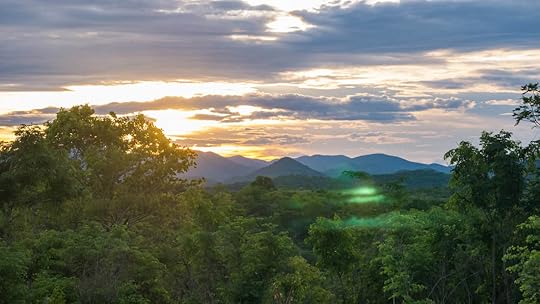 Zambia sure is beautiful.
Zambia sure is beautiful. 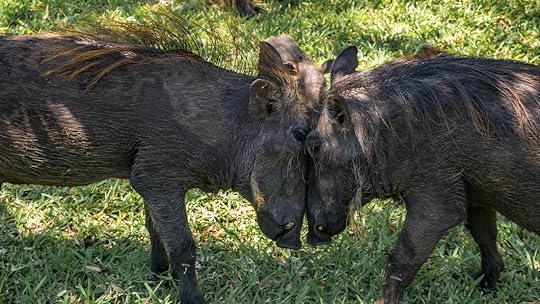 Like Tim and I, warthogs sometimes butt heads. We arrived in the capital city of Lusaka (where we got real vehicle insurance for the real price), and even though we hadn’t wanted to spend Christmas in a dirty, congested city, we did want to have internet to call friends and family. So we stayed at a hostel in an overpriced “chalet” that looked like it was built of sheets of plywood and five nails. The door didn’t properly open or close, and the structure was about to fall over, but I suppose that’s considered a building by Zambian standards.
Like Tim and I, warthogs sometimes butt heads. We arrived in the capital city of Lusaka (where we got real vehicle insurance for the real price), and even though we hadn’t wanted to spend Christmas in a dirty, congested city, we did want to have internet to call friends and family. So we stayed at a hostel in an overpriced “chalet” that looked like it was built of sheets of plywood and five nails. The door didn’t properly open or close, and the structure was about to fall over, but I suppose that’s considered a building by Zambian standards.
Most people in Zambia, and much of Southern Africa, are Christian, and so Christmas is a big deal. Even though it was summer here, and the sweltering weather didn’t make it feel like Christmas to me, there were Christmas trees and decorations everywhere. So we also decided to get into the spirit and decorated our bike. We also splurged and gave ourselves a nice Christmas Eve dinner of a T-bone steak!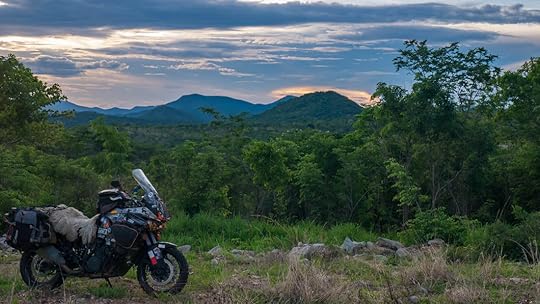 But Christmas day was when the real magic happened. We all headed out from Lusaka and decided to wild camp somewhere near the Mozambique border on a hilltop overlooking the other mountains in the distance. It was a gorgeous site, and the sunset was spectacular, but what really made it special was the light show that night.
But Christmas day was when the real magic happened. We all headed out from Lusaka and decided to wild camp somewhere near the Mozambique border on a hilltop overlooking the other mountains in the distance. It was a gorgeous site, and the sunset was spectacular, but what really made it special was the light show that night.
We were in our tent just about to fall asleep to dreams of a fantasy world when I noticed a firefly glittering above our tent. We had the rainfly off so we could see the stars, but since I had been staring at my phone for so long, I hadn’t noticed that a real fantasy world had surrounded us. Because then came another firefly, and another, blinking very fast, unlike any firefly I had ever seen before. It never just went dark and flew away, but instead gave off a constant blinking glow like Christmas lights.
So we got out of the tent and found ourselves in a glittering world of thousands of dancing fireflies illuminating all the rippling hills, with millions of twinkling stars above us, and to put the icing on the cake, a lightning storm was flashing through some clouds in the distance. It was unbelievable. We tried to take a picture, but it just didn’t come out. It was a moment simply to be appreciated for what it was.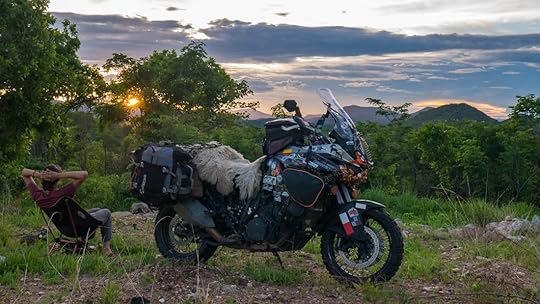 Our perfect camp spot, Zambia. Now we are in Malawi, so stay tuned for our next blog post on our adventures almost dying in the rain, and getting sick in Mzuzu. We’ll keep you posted!
Our perfect camp spot, Zambia. Now we are in Malawi, so stay tuned for our next blog post on our adventures almost dying in the rain, and getting sick in Mzuzu. We’ll keep you posted!
Subscribe to Our Blog
 We entered Zambia from Botswana through one of the most difficult border crossings we’ve ever experienced. We were traveling with our motorcycle friend, Emiliano, and crossing borders with another traveler usually makes things easier. With three people, two of them can try to figure out the procedures and stand in separate lines, and one can watch the bikes (me).
We entered Zambia from Botswana through one of the most difficult border crossings we’ve ever experienced. We were traveling with our motorcycle friend, Emiliano, and crossing borders with another traveler usually makes things easier. With three people, two of them can try to figure out the procedures and stand in separate lines, and one can watch the bikes (me).But for some reason, nothing seemed to be easy when it came to the convoluted process that was getting a visa and vehicle entry permit into Zambia. The heat, the lack of signage, the expense of it ($50 USD for a Zambia/Zimbabwe visa, $20 USD for road tax, more money for carbon taxes, insurance, paying fixers, all in Zambian Kwacha), and most of all, the chaos of the place, made it a horrible experience.
 This sign says it all. Nearly five hours later, we had three completely empty wallets, no water left in our water bottles, and no food in our stomachs, but we got through the border. I had spent the entire time watching the bikes and trying to convince a drunk guy that I wasn’t going to buy his fire extinguisher, even though he insisted it was the law that all motorcyclists had to carry one in Zambia. Tim and Emiliano got ripped off by their fixer and they overpaid for Zambian insurance by about $40 a person. It was a disaster, and later on, we were able to report the names of our cheating fixers to the insurance headquarters when we upgraded our COMESA insurance.
This sign says it all. Nearly five hours later, we had three completely empty wallets, no water left in our water bottles, and no food in our stomachs, but we got through the border. I had spent the entire time watching the bikes and trying to convince a drunk guy that I wasn’t going to buy his fire extinguisher, even though he insisted it was the law that all motorcyclists had to carry one in Zambia. Tim and Emiliano got ripped off by their fixer and they overpaid for Zambian insurance by about $40 a person. It was a disaster, and later on, we were able to report the names of our cheating fixers to the insurance headquarters when we upgraded our COMESA insurance.But at least now we were in Zambia.
And I have to say that this border crossing may have been a good introduction to the country. Because in comparison to Westernized South Africa, Namibia, and Botswana, Zambia was the first place that I felt I had truly entered the “Africa” that I had been told about, both the good and the bad.
 I know you were wondering where Zambia was. The bad was the chaos of the border: the cheating lies of our “friendly” helpers, the line of stinky trucks on a muddy dirt road, and the water bottles littered everywhere that had been there for so long, they almost looked like mud-covered cobblestones.
I know you were wondering where Zambia was. The bad was the chaos of the border: the cheating lies of our “friendly” helpers, the line of stinky trucks on a muddy dirt road, and the water bottles littered everywhere that had been there for so long, they almost looked like mud-covered cobblestones.But the good was more beautiful than I had ever expected.
On the other side of the border, the roads were lined in green foliage, bright and rich from the recent rains, and between the trees you could see round mud-brick houses with thatched roofs. Men rode around on old bicycles with baskets of goats, turkeys, chickens, or children on the back. Women wore colorful saris wrapped around their waists as a skirt and sometimes tucked it in over their chest like an oversized bath towel. Their hair would be done up in intricately-designed braids, sometimes dyed in similar colors to their clothes. And to literally top it all off, nearly every woman would be carrying something on top of her head, perfectly balanced on a platform of braids. A tray of bananas or mangoes maybe, or a bushel of corn meal, and a Zambian woman’s purse is always better carried on her head than over her shoulder.
 These cyclists are carrying home-made charcoal, a hot commodity of Zambia. I particularly like this man's Mickey Mouse backpack strapped on the back. Once across the border, I immediately felt that this was the Africa that I had hoped still existed somewhere out there. And as we rode the short ride to Livingstone, I couldn’t help but smile the whole way there.
These cyclists are carrying home-made charcoal, a hot commodity of Zambia. I particularly like this man's Mickey Mouse backpack strapped on the back. Once across the border, I immediately felt that this was the Africa that I had hoped still existed somewhere out there. And as we rode the short ride to Livingstone, I couldn’t help but smile the whole way there.  Zambia has some incredible nature. Good thing I was there to save Emiliano from this falling tree. Most tourists come to Zambia for one reason: to see Victoria Falls. As one of the largest waterfalls on earth, Victoria Falls is impressive and it's been a dream destination of mine for a long time. Created by the mighty Zambezi River (which Zambia is named for), the falls are actually split between the countries of Zambia and Zimbabwe, and so there is the eternal debate amongst travelers as to which side is better, and whether it’s necessary to see both.
Zambia has some incredible nature. Good thing I was there to save Emiliano from this falling tree. Most tourists come to Zambia for one reason: to see Victoria Falls. As one of the largest waterfalls on earth, Victoria Falls is impressive and it's been a dream destination of mine for a long time. Created by the mighty Zambezi River (which Zambia is named for), the falls are actually split between the countries of Zambia and Zimbabwe, and so there is the eternal debate amongst travelers as to which side is better, and whether it’s necessary to see both.  To make things ultra confusing, people often shorten these country names to Zam and Zim when talking about the falls. But despite their similar names, there is a huge difference between Zambia and Zimbabwe, especially at this moment in history. Long ago, they were regions of the same country known as Northern and Southern Rhodesia, but ever since their split, they’ve gone in two different directions.
To make things ultra confusing, people often shorten these country names to Zam and Zim when talking about the falls. But despite their similar names, there is a huge difference between Zambia and Zimbabwe, especially at this moment in history. Long ago, they were regions of the same country known as Northern and Southern Rhodesia, but ever since their split, they’ve gone in two different directions.Due to a continued relationship with international communities, Zambia is relatively safe and stable to travel through. But because Zimbabwe has been economically hindered for decades by the controversial policies of its former leader, the revolutionary Robert Mugabe, traveling through this proudly independent country is much more challenging. Even after Mugabe's death in 2019, basic services are still lacking, lines for petrol are long, and crime caused by “machete gangs" are a real problem.
So if Victoria Falls were said to be more impressive on the Zimbabwe side, would the risk of going be worth it?
 It turns out that heading into Zimbabwe for the day just to see Victoria Falls is safe and easy, as the two countries have a visa deal and a strong tourist infrastructure in place, even if it's just in that one spot. Plus, we came to the falls at the worst possible time of year, the end of the dry season, and the Zambia side was said to be just a trickle. So if we wanted to see more than a dry cliff, we’d have to go into Zimbabwe.
It turns out that heading into Zimbabwe for the day just to see Victoria Falls is safe and easy, as the two countries have a visa deal and a strong tourist infrastructure in place, even if it's just in that one spot. Plus, we came to the falls at the worst possible time of year, the end of the dry season, and the Zambia side was said to be just a trickle. So if we wanted to see more than a dry cliff, we’d have to go into Zimbabwe.Visiting Victoria Falls is not cheap. The visa for entering both countries is $50 (called UniVisa), the park entrance fee to Zimbabwe is $30 per person, and for Zambia it’s $20. For two people, that's $200, but for most, the falls are worth it.
 The glorious Victoria Falls. We went to Zimbabwe first, which was good, because we were so sweaty and tired afterwards, that we never even got to the Zambia side, and didn’t really need to. The views that we saw were certainly enough.
The glorious Victoria Falls. We went to Zimbabwe first, which was good, because we were so sweaty and tired afterwards, that we never even got to the Zambia side, and didn’t really need to. The views that we saw were certainly enough. The original name for Vic Falls was Mosi-oa-Tunya, meaning “The Smoke that Thunders", and once you're there, you can definitely see why. And there's so much more to do there than just waterfall watching. You can also zip-line across the canyon, bungee jump, take a helicopter ride, white-water raft (Emiliano did it and loved it), or swim to the edge of the falls in something called Devil's Pool.
The original name for Vic Falls was Mosi-oa-Tunya, meaning “The Smoke that Thunders", and once you're there, you can definitely see why. And there's so much more to do there than just waterfall watching. You can also zip-line across the canyon, bungee jump, take a helicopter ride, white-water raft (Emiliano did it and loved it), or swim to the edge of the falls in something called Devil's Pool.  It was so beautiful there, we barely noticed it was 105˚ out with full humidity. Ok, we may have noticed a little. The jumping-off point for most people visiting the Falls is the town of Livingstone in Zambia. Built for tourists, it’s got everything you could want: post cards, people selling knick-knacks on the street, a supermarket, and even a “Starbucks-like” café. The only problem is, like the rest of Zambia, Livingstone doesn’t have consistent electricity. We were lucky while we were there, because the President of Zambia also happened to be in town, which meant they kept the lights, fans, and very slow internet on… most of the time.
It was so beautiful there, we barely noticed it was 105˚ out with full humidity. Ok, we may have noticed a little. The jumping-off point for most people visiting the Falls is the town of Livingstone in Zambia. Built for tourists, it’s got everything you could want: post cards, people selling knick-knacks on the street, a supermarket, and even a “Starbucks-like” café. The only problem is, like the rest of Zambia, Livingstone doesn’t have consistent electricity. We were lucky while we were there, because the President of Zambia also happened to be in town, which meant they kept the lights, fans, and very slow internet on… most of the time.Livingstone is such a tourist hub, we ended up meeting lots of other motorcycle travelers there, and spent a couple of fantastic days hanging out with Andie. She's a British motorcyclist who lived in Livingstone on and off for years and had all the scoop on what to see and do. She was insanely fun to talk to, and the hours would fly by without us even realizing it. She even gave us talismans carved of the Zambezi River God called Nyami Nyami, who was said to be a serpent-shaped protector of all who go to the river.
 Andie and I in Livingstone, Zambia. We could have stayed in Livingstone for much longer, talking with friends, eating free pancakes at our hotel, and swimming in the pool, but Christmas was coming up, and we had other plans. So Emiliano, Tim, and I said our goodbyes to our new friends, packed up, and headed into the heat so explore more of Zambia.
Andie and I in Livingstone, Zambia. We could have stayed in Livingstone for much longer, talking with friends, eating free pancakes at our hotel, and swimming in the pool, but Christmas was coming up, and we had other plans. So Emiliano, Tim, and I said our goodbyes to our new friends, packed up, and headed into the heat so explore more of Zambia.Most of Zambia is very rural, and the more east you go, the more mountainous it gets. These vibrantly green mountains hum in the chirps of insects and birds, and between them, sleepy little villages of thatched houses sound of laughing children and smell of burning charcoal. Coming to Zambia, I didn’t really know what to expect out of the country, but I found it to be a breath of fresh air, or at least, humid, hot, sticky air. But the landscape was expansive and vast, with monkeys and baboons out there in the forest, and the lifestyle of the people was simple and comforting. Zambia to me felt like the real-life version of “The Lion Sleeps Tonight" song. You just can't help but smile as you traverse through it.
 Zambia sure is beautiful.
Zambia sure is beautiful.  Like Tim and I, warthogs sometimes butt heads. We arrived in the capital city of Lusaka (where we got real vehicle insurance for the real price), and even though we hadn’t wanted to spend Christmas in a dirty, congested city, we did want to have internet to call friends and family. So we stayed at a hostel in an overpriced “chalet” that looked like it was built of sheets of plywood and five nails. The door didn’t properly open or close, and the structure was about to fall over, but I suppose that’s considered a building by Zambian standards.
Like Tim and I, warthogs sometimes butt heads. We arrived in the capital city of Lusaka (where we got real vehicle insurance for the real price), and even though we hadn’t wanted to spend Christmas in a dirty, congested city, we did want to have internet to call friends and family. So we stayed at a hostel in an overpriced “chalet” that looked like it was built of sheets of plywood and five nails. The door didn’t properly open or close, and the structure was about to fall over, but I suppose that’s considered a building by Zambian standards.Most people in Zambia, and much of Southern Africa, are Christian, and so Christmas is a big deal. Even though it was summer here, and the sweltering weather didn’t make it feel like Christmas to me, there were Christmas trees and decorations everywhere. So we also decided to get into the spirit and decorated our bike. We also splurged and gave ourselves a nice Christmas Eve dinner of a T-bone steak!
 But Christmas day was when the real magic happened. We all headed out from Lusaka and decided to wild camp somewhere near the Mozambique border on a hilltop overlooking the other mountains in the distance. It was a gorgeous site, and the sunset was spectacular, but what really made it special was the light show that night.
But Christmas day was when the real magic happened. We all headed out from Lusaka and decided to wild camp somewhere near the Mozambique border on a hilltop overlooking the other mountains in the distance. It was a gorgeous site, and the sunset was spectacular, but what really made it special was the light show that night.We were in our tent just about to fall asleep to dreams of a fantasy world when I noticed a firefly glittering above our tent. We had the rainfly off so we could see the stars, but since I had been staring at my phone for so long, I hadn’t noticed that a real fantasy world had surrounded us. Because then came another firefly, and another, blinking very fast, unlike any firefly I had ever seen before. It never just went dark and flew away, but instead gave off a constant blinking glow like Christmas lights.
So we got out of the tent and found ourselves in a glittering world of thousands of dancing fireflies illuminating all the rippling hills, with millions of twinkling stars above us, and to put the icing on the cake, a lightning storm was flashing through some clouds in the distance. It was unbelievable. We tried to take a picture, but it just didn’t come out. It was a moment simply to be appreciated for what it was.
 Our perfect camp spot, Zambia. Now we are in Malawi, so stay tuned for our next blog post on our adventures almost dying in the rain, and getting sick in Mzuzu. We’ll keep you posted!
Our perfect camp spot, Zambia. Now we are in Malawi, so stay tuned for our next blog post on our adventures almost dying in the rain, and getting sick in Mzuzu. We’ll keep you posted!Subscribe to Our Blog
Published on December 29, 2019 23:20
December 20, 2019
Searching for Baobabs in Botswana
By Marisa  We have nothing against Windhoek, the capital city of Namibia, but when you’re stuck there for weeks on end because your motorcycle is broken, all you can think about is leaving.
We have nothing against Windhoek, the capital city of Namibia, but when you’re stuck there for weeks on end because your motorcycle is broken, all you can think about is leaving.
We had unfortunately snapped our monoshock (rear suspension) when we’d first entered Namibia. We waited for two weeks for our new shock to arrive from Austria, and when it did, we packed up the bike, got on the road, and headed to Botswana when we realized something horrible: the monoshock was not the only thing that needed replacing. The shock’s spring was also damaged, and we would have to turn back.
That meant it would be another week and a half of waiting in Windhoek and paying for repairs and living expenses before we could continue with our African travels.
This was very depressing for us, and it certainly wasn’t a great beginning to the holiday season.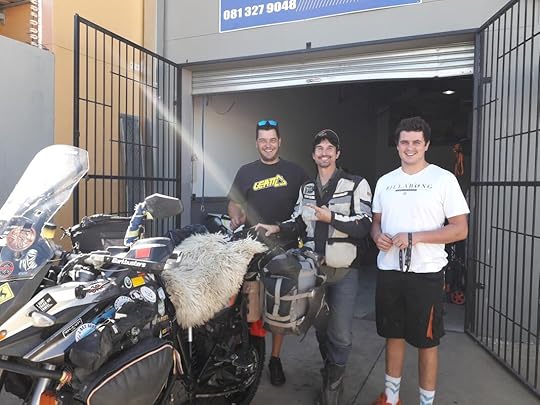 Tim with our amazing mechanics, Ruan and Duard, standing with our bike and its new shock and spring. Windhoek, Namibia. But finally, the new shock spring came, and with fingers crossed that nothing else was wrong, we were ready to go.
Tim with our amazing mechanics, Ruan and Duard, standing with our bike and its new shock and spring. Windhoek, Namibia. But finally, the new shock spring came, and with fingers crossed that nothing else was wrong, we were ready to go.
Looking back, we had a blast in Namibia, minus all the bike trouble. We saw starkly beautiful desert landscapes (Sossusvlei), we came face-to-face with hundreds of stinky seals (Cape Cross), we carpooled with an ochre-covered Himba woman and her baby, and most of all, we got to see lions, zebras, giraffes, and wildebeest in the wild. Namibia was amazing.
But after being stuck without our motorcycle in Namibia for almost a month, we wanted nothing more than to get to a new country. So we couldn't be more excited for the next step on our trajectory: Botswana.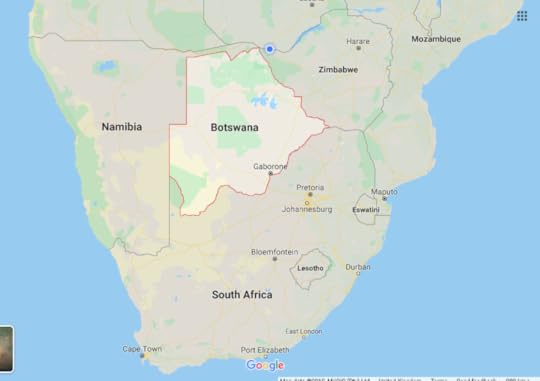 We’ve wanted to visit Botswana ever since we watched The No. 1 Ladies’ Detective Agency on HBO, a series based on the books by Alexander McCall Smith. The show made Botswana out to be an African paradise of giraffes and elephants roaming the landscape, friendly people greeting you everywhere with big smiles, and it seemed to be run by a peaceful, stable government. So we were curious to find out if this was all true.
We’ve wanted to visit Botswana ever since we watched The No. 1 Ladies’ Detective Agency on HBO, a series based on the books by Alexander McCall Smith. The show made Botswana out to be an African paradise of giraffes and elephants roaming the landscape, friendly people greeting you everywhere with big smiles, and it seemed to be run by a peaceful, stable government. So we were curious to find out if this was all true.
We crossed into Botswana through the Kalahari desert, and not even an hour in, we saw one of our motorcycle travel friends on the road: Emiliano. He’s a fellow American riding on a BMW 650, and we’d first met him in South Africa and traveled the Wild Coast with him. And now he was in Botswana, just like us, so we decided to travel together.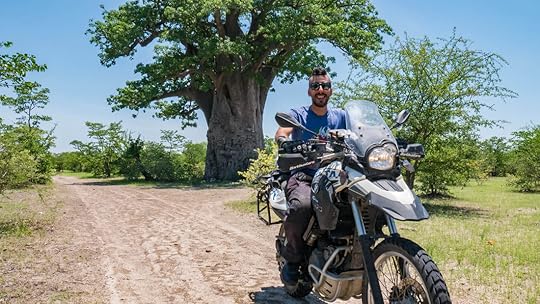 Emiliano in front of a baobab, Gweta, Botswana. We’d come into Botswana in the northern half near the Okavango Delta where most of the wildlife action is. Unfortunately, these sites are not accessible by motorcycle (due to motorcycles not being allowed into National Parks for safety reasons… like lions…), so we had to be a bit creative with where we went and what we saw.
Emiliano in front of a baobab, Gweta, Botswana. We’d come into Botswana in the northern half near the Okavango Delta where most of the wildlife action is. Unfortunately, these sites are not accessible by motorcycle (due to motorcycles not being allowed into National Parks for safety reasons… like lions…), so we had to be a bit creative with where we went and what we saw. 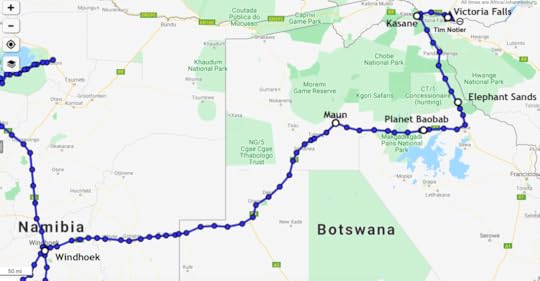 This was the path of our journey from Namibia and through Botswana. Our first destination was an area east of Maun called Planet Baobab, which, as you guessed, is famous for its baobabs. Baobabs are trees, but not just any tree. They’re ancient and unique trees with girthy trunks and stubby branches that you often see in pictures of Madagascar. We weren’t going to Madagascar, so I just assumed we wouldn’t be able to see any of these trees, but it turns out there are some on the mainland of Africa as well, especially in this region of Botswana. And they are some of the largest, oldest, and most impressive specimens of baobabs on earth.
This was the path of our journey from Namibia and through Botswana. Our first destination was an area east of Maun called Planet Baobab, which, as you guessed, is famous for its baobabs. Baobabs are trees, but not just any tree. They’re ancient and unique trees with girthy trunks and stubby branches that you often see in pictures of Madagascar. We weren’t going to Madagascar, so I just assumed we wouldn’t be able to see any of these trees, but it turns out there are some on the mainland of Africa as well, especially in this region of Botswana. And they are some of the largest, oldest, and most impressive specimens of baobabs on earth. 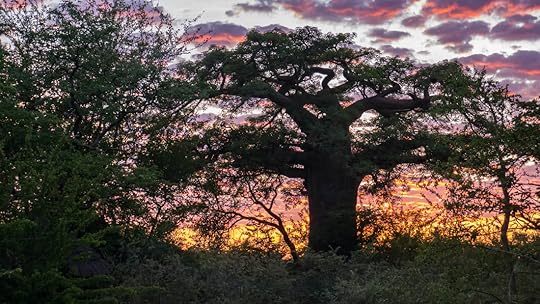 The incredible baobab tree. You might be thinking, “What’s so great about funny looking trees?” Well, as we made our way over there along boring stretches of highway, sweating in the heat of the Botswanan summer, I was thinking the same thing. Sure, they’re big, but we’d seen the Sequoias in California. So would it be worth it to come all the way out here just to see trees?
The incredible baobab tree. You might be thinking, “What’s so great about funny looking trees?” Well, as we made our way over there along boring stretches of highway, sweating in the heat of the Botswanan summer, I was thinking the same thing. Sure, they’re big, but we’d seen the Sequoias in California. So would it be worth it to come all the way out here just to see trees?
But after seeing my first baobab, I immediately changed my mind.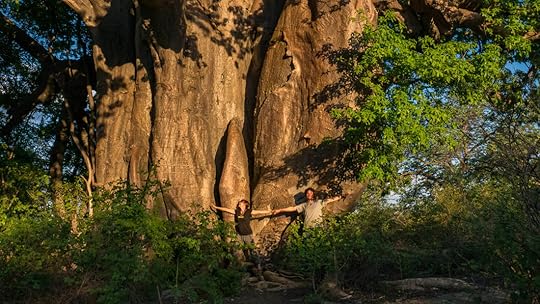 This is the biggest baobab tree that we found, and it's enormous. It's at Planet Baobab, Botswana. There’s something about baobabs that’s magical: they stick up huge and mighty right out of the flat shrub land like a beacon to all people and animals to come for shelter, for shade, for a home. Some of these trees are over 2,000 years old, and as you walk under them, you feel the coolness of its immense shade, you touch its elephant-hide-like bark, you smell the fragrance of the summer sage grasses growing under your feet. And you know that this is where people have congregated since before white settlers ever came, since even before the Bantu people migrated from the north.
This is the biggest baobab tree that we found, and it's enormous. It's at Planet Baobab, Botswana. There’s something about baobabs that’s magical: they stick up huge and mighty right out of the flat shrub land like a beacon to all people and animals to come for shelter, for shade, for a home. Some of these trees are over 2,000 years old, and as you walk under them, you feel the coolness of its immense shade, you touch its elephant-hide-like bark, you smell the fragrance of the summer sage grasses growing under your feet. And you know that this is where people have congregated since before white settlers ever came, since even before the Bantu people migrated from the north.
This tree was here giving shade and refuge to the original bush people who hunted antelope and lions barefoot and with nothing more than spears. And to this day, you feel as if not much has changed around this tree. Antelope have become cows and goats with bells hanging around their necks, creating a wind-chime music to the place. And now there are paths winding through the landscape where 4x4’s and crazy motorcyclists try to push their way through the sand. But those are the only differences. The elephant dung is still fresh all around, the vultures still make their nests high up in the branches, and the air still smells of a humid heat carrying the scent of animals and flowers, just like it always has.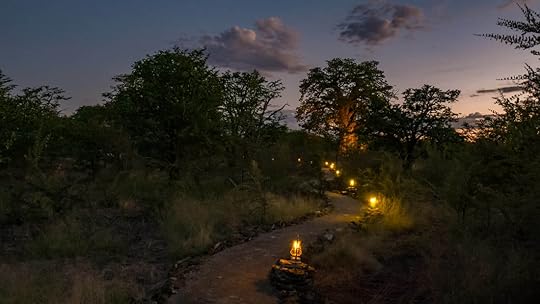 Planet Baobab at night, Botswana. We spent a day riding down the backroads around Gweta, doing nothing more than searching for baobabs. We’d keep our eyes out for the silhouettes of enormous trunks, and then we'd weave our way through the thorny brambles until we’d park under the shade, take off our sweat-soaked jackets, and have a snack next to the baobab. It was a perfect day, even though it was a little hot out (ok, it was a lot hot out), but I will always associate Botswana with our search for the majestic baobab trees.
Planet Baobab at night, Botswana. We spent a day riding down the backroads around Gweta, doing nothing more than searching for baobabs. We’d keep our eyes out for the silhouettes of enormous trunks, and then we'd weave our way through the thorny brambles until we’d park under the shade, take off our sweat-soaked jackets, and have a snack next to the baobab. It was a perfect day, even though it was a little hot out (ok, it was a lot hot out), but I will always associate Botswana with our search for the majestic baobab trees. 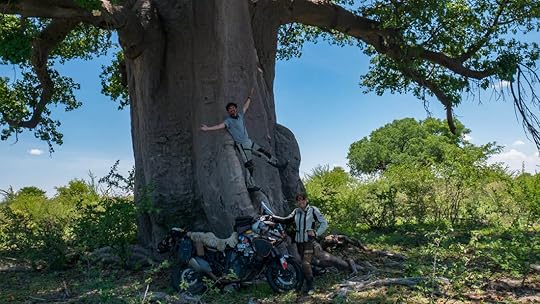 One of the many baobabs we found around Gweta, Botswana. After Planet Baobab, the three of us headed off to another famous campground: Elephant Sands. This place is built around a watering hole where elephants like to hang out, and even though they’re wild, the elephants are used to people camping there and they wonder around like they’re just another patron of the establishment.
One of the many baobabs we found around Gweta, Botswana. After Planet Baobab, the three of us headed off to another famous campground: Elephant Sands. This place is built around a watering hole where elephants like to hang out, and even though they’re wild, the elephants are used to people camping there and they wonder around like they’re just another patron of the establishment.
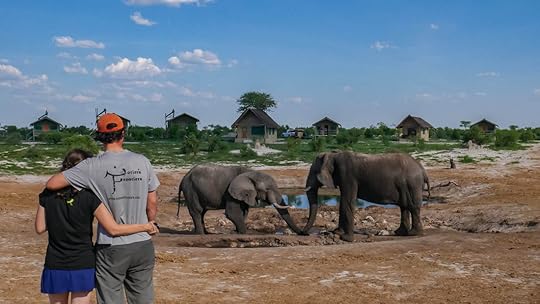 The amazing view at Elephant Sands, Botswana. It’s truly incredible to be that close to elephants, but I also gained some respect for earth’s largest land animal as I witnessed the lengths at which the place had to go to make sure that both people and their buildings were safe from the elephants’ destructive behavior.
The amazing view at Elephant Sands, Botswana. It’s truly incredible to be that close to elephants, but I also gained some respect for earth’s largest land animal as I witnessed the lengths at which the place had to go to make sure that both people and their buildings were safe from the elephants’ destructive behavior.
Rebar was sticking up out of the ground so elephants couldn’t walk over it, the bathrooms were encircled in concrete walls, and signs were posted everywhere saying, “Don’t leave the water running or you could endanger your life." It turns out that elephants seek out water like a backhoe digs through the earth, and they will topple walls, pull up piping, and trample anything in their way to get to it. So just like how you have to keep your food protected up in trees when camping around bears, when camping around elephants you have to make sure your water supply is guarded in a fortress-like facility. And then just hope they don’t accidentally walk over your tent at night.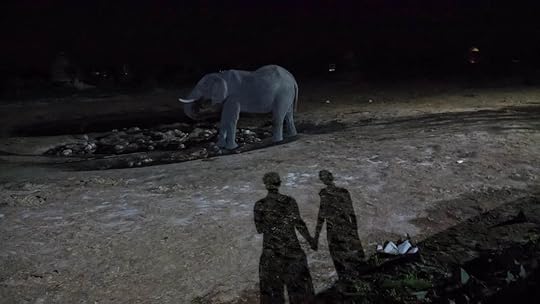 The watering hole at Elephant Sands at night. The night that we spent there we were suddenly awoken by a roar of a monster. It was like the belching of a bear mixed with the low bass of a 90’s rap song. If I was a sound editor for the Jurassic park movies, I would definitely use these elephant sounds for my T-Rex, because they are deep and freaky noises. It was so much more than your typical Dumbo trumpeting, because at night, the elephants grumbled and groaned to each other, sometimes in anger as two young bulls clashed their tusks together in a fight. The sounds almost vibrated the earth beneath my feet with their low reverberating voices. It was like out of horror movie.
The watering hole at Elephant Sands at night. The night that we spent there we were suddenly awoken by a roar of a monster. It was like the belching of a bear mixed with the low bass of a 90’s rap song. If I was a sound editor for the Jurassic park movies, I would definitely use these elephant sounds for my T-Rex, because they are deep and freaky noises. It was so much more than your typical Dumbo trumpeting, because at night, the elephants grumbled and groaned to each other, sometimes in anger as two young bulls clashed their tusks together in a fight. The sounds almost vibrated the earth beneath my feet with their low reverberating voices. It was like out of horror movie.
Of course Tim and I both sat up in our tent at the sounds, and through the darkness we could see a massive elephant just fifteen feet away from us. We held our breath as he lumbered past and headed to the waterhole, where we could make out the shadows of ten more elephants, including some babies.
So we headed over to the main building and got a great view of the waterhole, and spent an hour or so watching the elephants slurp up the water through their trunks, and protect their little cute babies under their legs. I have to say, this was one of our most memorable experiences of our lives.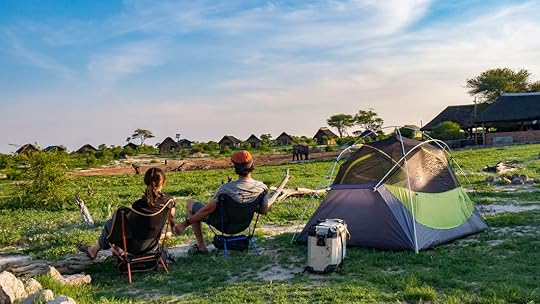 Camping at Elephant Sands, Botswana. The next day we headed to our last destination in Botswana: a town in the northeastern tip called Kasane. It’s right on the edge of Chobe National Park where the Chobe River meets the Zambezi River at the confluence of Namibia, Zimbabwe, and Zambia. From Kasane, we were able to join a Chobe river boat tour where we got to see water-loving animals that we didn’t see on our safari in drier Namibia, such as hippos, crocodiles, and water buffalo.
Camping at Elephant Sands, Botswana. The next day we headed to our last destination in Botswana: a town in the northeastern tip called Kasane. It’s right on the edge of Chobe National Park where the Chobe River meets the Zambezi River at the confluence of Namibia, Zimbabwe, and Zambia. From Kasane, we were able to join a Chobe river boat tour where we got to see water-loving animals that we didn’t see on our safari in drier Namibia, such as hippos, crocodiles, and water buffalo. 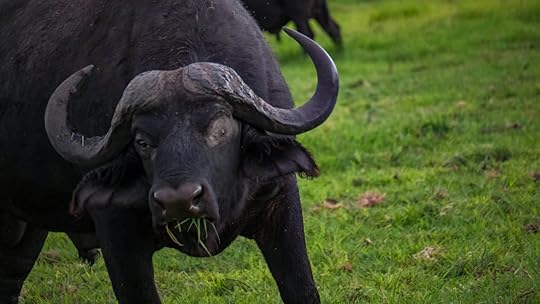 A one-eyed Water Buffalo bull. We were extremely lucky during our tour because we got to see a mother hippo give birth. Now as exciting as that sounds, because hippos give birth under water, there wasn’t actually much to see, but we did notice a little pink hippo head pop up behind her. And then he twitched his tiny ears, took a snotty breath of fresh air, and opened his mouth to make a big yawn. It was absolutely adorable.
A one-eyed Water Buffalo bull. We were extremely lucky during our tour because we got to see a mother hippo give birth. Now as exciting as that sounds, because hippos give birth under water, there wasn’t actually much to see, but we did notice a little pink hippo head pop up behind her. And then he twitched his tiny ears, took a snotty breath of fresh air, and opened his mouth to make a big yawn. It was absolutely adorable. 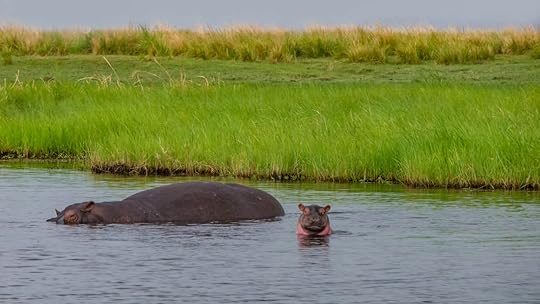 Mama hippo and her newborn. Besides a Fish Eagle, a family of Striped Mongooses, and a whole group of Chacma Baboons, we also got very close to a few Nile Crocodiles. The ones we saw were small compared to how large they can be (18 feet long, 6 meters!), but their reptilian eyes that never blink still gave me the chills. Needless to say, we were not allowed to put our hands into the water. Ever. There are simply too many crocodiles out there.
Mama hippo and her newborn. Besides a Fish Eagle, a family of Striped Mongooses, and a whole group of Chacma Baboons, we also got very close to a few Nile Crocodiles. The ones we saw were small compared to how large they can be (18 feet long, 6 meters!), but their reptilian eyes that never blink still gave me the chills. Needless to say, we were not allowed to put our hands into the water. Ever. There are simply too many crocodiles out there. 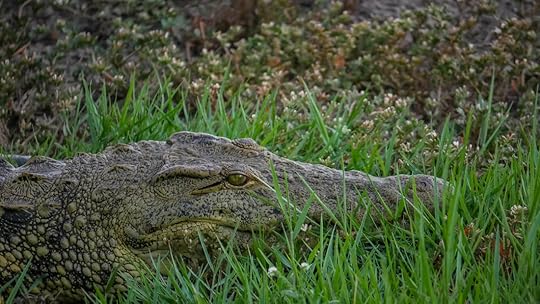 A Nile Crocodile along the Chobe River, Botswana. After a couple more days relaxing poolside in Kasane, we knew our time in Botswana was coming to an end. Not only did the country meet all our expectations from the No. 1 Ladies' Detective Agency show, but it exceeded them.
A Nile Crocodile along the Chobe River, Botswana. After a couple more days relaxing poolside in Kasane, we knew our time in Botswana was coming to an end. Not only did the country meet all our expectations from the No. 1 Ladies' Detective Agency show, but it exceeded them.
And next up, we journey into Zambia to see the great and wonderful Victoria Falls! So stay tuned.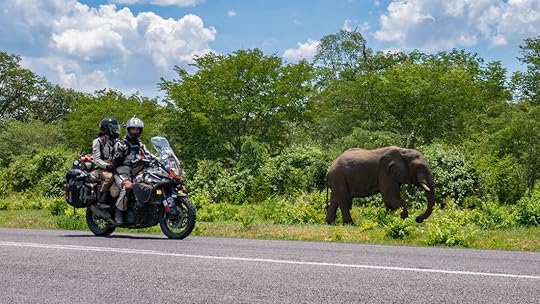 There were elephants everywhere in Botswana. We will miss this incredible country! This holiday season, we have too many people to thank. Ruan and Duard who helped us get back on the road again in Windhoek, and everyone who has bought our books, stickers, and photography. We send you good wishes and a Happy Holidays from Africa! Subscribe to our Blog Check out our Stickers, Books, and Photos we have for sale! Give the gift of travel inspiration this holiday season! Stickers for sale
There were elephants everywhere in Botswana. We will miss this incredible country! This holiday season, we have too many people to thank. Ruan and Duard who helped us get back on the road again in Windhoek, and everyone who has bought our books, stickers, and photography. We send you good wishes and a Happy Holidays from Africa! Subscribe to our Blog Check out our Stickers, Books, and Photos we have for sale! Give the gift of travel inspiration this holiday season! Stickers for sale 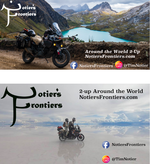 Books for sale
Books for sale 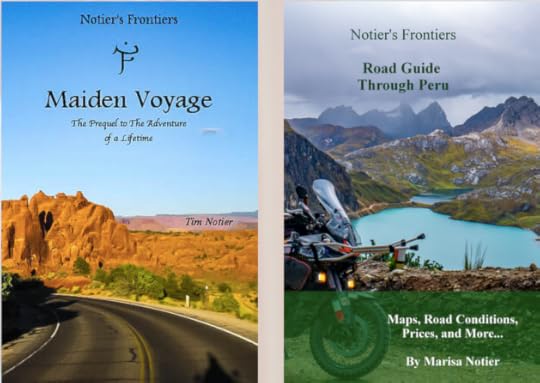 Pictures for sale
Pictures for sale 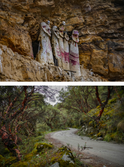
 We have nothing against Windhoek, the capital city of Namibia, but when you’re stuck there for weeks on end because your motorcycle is broken, all you can think about is leaving.
We have nothing against Windhoek, the capital city of Namibia, but when you’re stuck there for weeks on end because your motorcycle is broken, all you can think about is leaving.We had unfortunately snapped our monoshock (rear suspension) when we’d first entered Namibia. We waited for two weeks for our new shock to arrive from Austria, and when it did, we packed up the bike, got on the road, and headed to Botswana when we realized something horrible: the monoshock was not the only thing that needed replacing. The shock’s spring was also damaged, and we would have to turn back.
That meant it would be another week and a half of waiting in Windhoek and paying for repairs and living expenses before we could continue with our African travels.
This was very depressing for us, and it certainly wasn’t a great beginning to the holiday season.
 Tim with our amazing mechanics, Ruan and Duard, standing with our bike and its new shock and spring. Windhoek, Namibia. But finally, the new shock spring came, and with fingers crossed that nothing else was wrong, we were ready to go.
Tim with our amazing mechanics, Ruan and Duard, standing with our bike and its new shock and spring. Windhoek, Namibia. But finally, the new shock spring came, and with fingers crossed that nothing else was wrong, we were ready to go.Looking back, we had a blast in Namibia, minus all the bike trouble. We saw starkly beautiful desert landscapes (Sossusvlei), we came face-to-face with hundreds of stinky seals (Cape Cross), we carpooled with an ochre-covered Himba woman and her baby, and most of all, we got to see lions, zebras, giraffes, and wildebeest in the wild. Namibia was amazing.
But after being stuck without our motorcycle in Namibia for almost a month, we wanted nothing more than to get to a new country. So we couldn't be more excited for the next step on our trajectory: Botswana.
 We’ve wanted to visit Botswana ever since we watched The No. 1 Ladies’ Detective Agency on HBO, a series based on the books by Alexander McCall Smith. The show made Botswana out to be an African paradise of giraffes and elephants roaming the landscape, friendly people greeting you everywhere with big smiles, and it seemed to be run by a peaceful, stable government. So we were curious to find out if this was all true.
We’ve wanted to visit Botswana ever since we watched The No. 1 Ladies’ Detective Agency on HBO, a series based on the books by Alexander McCall Smith. The show made Botswana out to be an African paradise of giraffes and elephants roaming the landscape, friendly people greeting you everywhere with big smiles, and it seemed to be run by a peaceful, stable government. So we were curious to find out if this was all true.We crossed into Botswana through the Kalahari desert, and not even an hour in, we saw one of our motorcycle travel friends on the road: Emiliano. He’s a fellow American riding on a BMW 650, and we’d first met him in South Africa and traveled the Wild Coast with him. And now he was in Botswana, just like us, so we decided to travel together.
 Emiliano in front of a baobab, Gweta, Botswana. We’d come into Botswana in the northern half near the Okavango Delta where most of the wildlife action is. Unfortunately, these sites are not accessible by motorcycle (due to motorcycles not being allowed into National Parks for safety reasons… like lions…), so we had to be a bit creative with where we went and what we saw.
Emiliano in front of a baobab, Gweta, Botswana. We’d come into Botswana in the northern half near the Okavango Delta where most of the wildlife action is. Unfortunately, these sites are not accessible by motorcycle (due to motorcycles not being allowed into National Parks for safety reasons… like lions…), so we had to be a bit creative with where we went and what we saw.  This was the path of our journey from Namibia and through Botswana. Our first destination was an area east of Maun called Planet Baobab, which, as you guessed, is famous for its baobabs. Baobabs are trees, but not just any tree. They’re ancient and unique trees with girthy trunks and stubby branches that you often see in pictures of Madagascar. We weren’t going to Madagascar, so I just assumed we wouldn’t be able to see any of these trees, but it turns out there are some on the mainland of Africa as well, especially in this region of Botswana. And they are some of the largest, oldest, and most impressive specimens of baobabs on earth.
This was the path of our journey from Namibia and through Botswana. Our first destination was an area east of Maun called Planet Baobab, which, as you guessed, is famous for its baobabs. Baobabs are trees, but not just any tree. They’re ancient and unique trees with girthy trunks and stubby branches that you often see in pictures of Madagascar. We weren’t going to Madagascar, so I just assumed we wouldn’t be able to see any of these trees, but it turns out there are some on the mainland of Africa as well, especially in this region of Botswana. And they are some of the largest, oldest, and most impressive specimens of baobabs on earth.  The incredible baobab tree. You might be thinking, “What’s so great about funny looking trees?” Well, as we made our way over there along boring stretches of highway, sweating in the heat of the Botswanan summer, I was thinking the same thing. Sure, they’re big, but we’d seen the Sequoias in California. So would it be worth it to come all the way out here just to see trees?
The incredible baobab tree. You might be thinking, “What’s so great about funny looking trees?” Well, as we made our way over there along boring stretches of highway, sweating in the heat of the Botswanan summer, I was thinking the same thing. Sure, they’re big, but we’d seen the Sequoias in California. So would it be worth it to come all the way out here just to see trees?But after seeing my first baobab, I immediately changed my mind.
 This is the biggest baobab tree that we found, and it's enormous. It's at Planet Baobab, Botswana. There’s something about baobabs that’s magical: they stick up huge and mighty right out of the flat shrub land like a beacon to all people and animals to come for shelter, for shade, for a home. Some of these trees are over 2,000 years old, and as you walk under them, you feel the coolness of its immense shade, you touch its elephant-hide-like bark, you smell the fragrance of the summer sage grasses growing under your feet. And you know that this is where people have congregated since before white settlers ever came, since even before the Bantu people migrated from the north.
This is the biggest baobab tree that we found, and it's enormous. It's at Planet Baobab, Botswana. There’s something about baobabs that’s magical: they stick up huge and mighty right out of the flat shrub land like a beacon to all people and animals to come for shelter, for shade, for a home. Some of these trees are over 2,000 years old, and as you walk under them, you feel the coolness of its immense shade, you touch its elephant-hide-like bark, you smell the fragrance of the summer sage grasses growing under your feet. And you know that this is where people have congregated since before white settlers ever came, since even before the Bantu people migrated from the north.This tree was here giving shade and refuge to the original bush people who hunted antelope and lions barefoot and with nothing more than spears. And to this day, you feel as if not much has changed around this tree. Antelope have become cows and goats with bells hanging around their necks, creating a wind-chime music to the place. And now there are paths winding through the landscape where 4x4’s and crazy motorcyclists try to push their way through the sand. But those are the only differences. The elephant dung is still fresh all around, the vultures still make their nests high up in the branches, and the air still smells of a humid heat carrying the scent of animals and flowers, just like it always has.
 Planet Baobab at night, Botswana. We spent a day riding down the backroads around Gweta, doing nothing more than searching for baobabs. We’d keep our eyes out for the silhouettes of enormous trunks, and then we'd weave our way through the thorny brambles until we’d park under the shade, take off our sweat-soaked jackets, and have a snack next to the baobab. It was a perfect day, even though it was a little hot out (ok, it was a lot hot out), but I will always associate Botswana with our search for the majestic baobab trees.
Planet Baobab at night, Botswana. We spent a day riding down the backroads around Gweta, doing nothing more than searching for baobabs. We’d keep our eyes out for the silhouettes of enormous trunks, and then we'd weave our way through the thorny brambles until we’d park under the shade, take off our sweat-soaked jackets, and have a snack next to the baobab. It was a perfect day, even though it was a little hot out (ok, it was a lot hot out), but I will always associate Botswana with our search for the majestic baobab trees.  One of the many baobabs we found around Gweta, Botswana. After Planet Baobab, the three of us headed off to another famous campground: Elephant Sands. This place is built around a watering hole where elephants like to hang out, and even though they’re wild, the elephants are used to people camping there and they wonder around like they’re just another patron of the establishment.
One of the many baobabs we found around Gweta, Botswana. After Planet Baobab, the three of us headed off to another famous campground: Elephant Sands. This place is built around a watering hole where elephants like to hang out, and even though they’re wild, the elephants are used to people camping there and they wonder around like they’re just another patron of the establishment. The amazing view at Elephant Sands, Botswana. It’s truly incredible to be that close to elephants, but I also gained some respect for earth’s largest land animal as I witnessed the lengths at which the place had to go to make sure that both people and their buildings were safe from the elephants’ destructive behavior.
The amazing view at Elephant Sands, Botswana. It’s truly incredible to be that close to elephants, but I also gained some respect for earth’s largest land animal as I witnessed the lengths at which the place had to go to make sure that both people and their buildings were safe from the elephants’ destructive behavior.Rebar was sticking up out of the ground so elephants couldn’t walk over it, the bathrooms were encircled in concrete walls, and signs were posted everywhere saying, “Don’t leave the water running or you could endanger your life." It turns out that elephants seek out water like a backhoe digs through the earth, and they will topple walls, pull up piping, and trample anything in their way to get to it. So just like how you have to keep your food protected up in trees when camping around bears, when camping around elephants you have to make sure your water supply is guarded in a fortress-like facility. And then just hope they don’t accidentally walk over your tent at night.
 The watering hole at Elephant Sands at night. The night that we spent there we were suddenly awoken by a roar of a monster. It was like the belching of a bear mixed with the low bass of a 90’s rap song. If I was a sound editor for the Jurassic park movies, I would definitely use these elephant sounds for my T-Rex, because they are deep and freaky noises. It was so much more than your typical Dumbo trumpeting, because at night, the elephants grumbled and groaned to each other, sometimes in anger as two young bulls clashed their tusks together in a fight. The sounds almost vibrated the earth beneath my feet with their low reverberating voices. It was like out of horror movie.
The watering hole at Elephant Sands at night. The night that we spent there we were suddenly awoken by a roar of a monster. It was like the belching of a bear mixed with the low bass of a 90’s rap song. If I was a sound editor for the Jurassic park movies, I would definitely use these elephant sounds for my T-Rex, because they are deep and freaky noises. It was so much more than your typical Dumbo trumpeting, because at night, the elephants grumbled and groaned to each other, sometimes in anger as two young bulls clashed their tusks together in a fight. The sounds almost vibrated the earth beneath my feet with their low reverberating voices. It was like out of horror movie.Of course Tim and I both sat up in our tent at the sounds, and through the darkness we could see a massive elephant just fifteen feet away from us. We held our breath as he lumbered past and headed to the waterhole, where we could make out the shadows of ten more elephants, including some babies.
So we headed over to the main building and got a great view of the waterhole, and spent an hour or so watching the elephants slurp up the water through their trunks, and protect their little cute babies under their legs. I have to say, this was one of our most memorable experiences of our lives.
 Camping at Elephant Sands, Botswana. The next day we headed to our last destination in Botswana: a town in the northeastern tip called Kasane. It’s right on the edge of Chobe National Park where the Chobe River meets the Zambezi River at the confluence of Namibia, Zimbabwe, and Zambia. From Kasane, we were able to join a Chobe river boat tour where we got to see water-loving animals that we didn’t see on our safari in drier Namibia, such as hippos, crocodiles, and water buffalo.
Camping at Elephant Sands, Botswana. The next day we headed to our last destination in Botswana: a town in the northeastern tip called Kasane. It’s right on the edge of Chobe National Park where the Chobe River meets the Zambezi River at the confluence of Namibia, Zimbabwe, and Zambia. From Kasane, we were able to join a Chobe river boat tour where we got to see water-loving animals that we didn’t see on our safari in drier Namibia, such as hippos, crocodiles, and water buffalo.  A one-eyed Water Buffalo bull. We were extremely lucky during our tour because we got to see a mother hippo give birth. Now as exciting as that sounds, because hippos give birth under water, there wasn’t actually much to see, but we did notice a little pink hippo head pop up behind her. And then he twitched his tiny ears, took a snotty breath of fresh air, and opened his mouth to make a big yawn. It was absolutely adorable.
A one-eyed Water Buffalo bull. We were extremely lucky during our tour because we got to see a mother hippo give birth. Now as exciting as that sounds, because hippos give birth under water, there wasn’t actually much to see, but we did notice a little pink hippo head pop up behind her. And then he twitched his tiny ears, took a snotty breath of fresh air, and opened his mouth to make a big yawn. It was absolutely adorable.  Mama hippo and her newborn. Besides a Fish Eagle, a family of Striped Mongooses, and a whole group of Chacma Baboons, we also got very close to a few Nile Crocodiles. The ones we saw were small compared to how large they can be (18 feet long, 6 meters!), but their reptilian eyes that never blink still gave me the chills. Needless to say, we were not allowed to put our hands into the water. Ever. There are simply too many crocodiles out there.
Mama hippo and her newborn. Besides a Fish Eagle, a family of Striped Mongooses, and a whole group of Chacma Baboons, we also got very close to a few Nile Crocodiles. The ones we saw were small compared to how large they can be (18 feet long, 6 meters!), but their reptilian eyes that never blink still gave me the chills. Needless to say, we were not allowed to put our hands into the water. Ever. There are simply too many crocodiles out there.  A Nile Crocodile along the Chobe River, Botswana. After a couple more days relaxing poolside in Kasane, we knew our time in Botswana was coming to an end. Not only did the country meet all our expectations from the No. 1 Ladies' Detective Agency show, but it exceeded them.
A Nile Crocodile along the Chobe River, Botswana. After a couple more days relaxing poolside in Kasane, we knew our time in Botswana was coming to an end. Not only did the country meet all our expectations from the No. 1 Ladies' Detective Agency show, but it exceeded them.And next up, we journey into Zambia to see the great and wonderful Victoria Falls! So stay tuned.
 There were elephants everywhere in Botswana. We will miss this incredible country! This holiday season, we have too many people to thank. Ruan and Duard who helped us get back on the road again in Windhoek, and everyone who has bought our books, stickers, and photography. We send you good wishes and a Happy Holidays from Africa! Subscribe to our Blog Check out our Stickers, Books, and Photos we have for sale! Give the gift of travel inspiration this holiday season! Stickers for sale
There were elephants everywhere in Botswana. We will miss this incredible country! This holiday season, we have too many people to thank. Ruan and Duard who helped us get back on the road again in Windhoek, and everyone who has bought our books, stickers, and photography. We send you good wishes and a Happy Holidays from Africa! Subscribe to our Blog Check out our Stickers, Books, and Photos we have for sale! Give the gift of travel inspiration this holiday season! Stickers for sale  Books for sale
Books for sale  Pictures for sale
Pictures for sale 
Published on December 20, 2019 04:53



